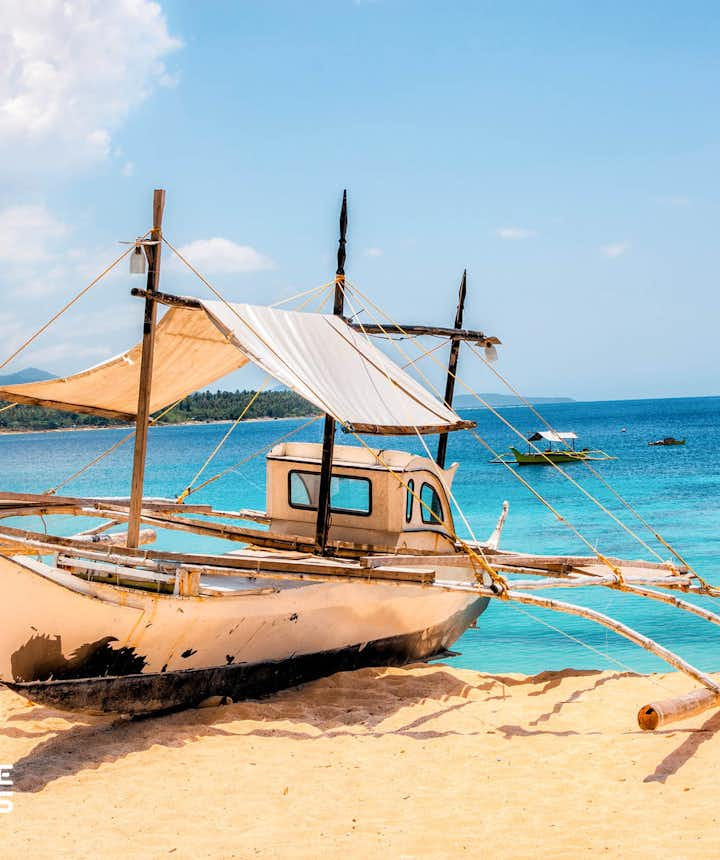

Top 15 Tourist Spots in Davao Mindanao: Home to Mount Apo Hiking & Nearby Samal Island Resort City

1. Explore Samal Island
2. discover eden nature park.
- 3. Unwind at Malagos Garden Resort and Chocolate Museum
- 4. See the Reptiles at Crocodile Park
5. Visit the Philippine Eagle Center
- 6. Relax at People's Park Davao
- 7. See Panoramic View at Jack's Ridge
8. Taste Durian Fruit
9. spend time at roxas night market, 10. stop by at museo dabawenyo.
- 11. Trek Mt. Apo — The Highest in the Philippines
- 12. Visit Davao Butterfly House
- 13. Try Civet Coffee
- 14. Immerse in the Kadayawan Village
- 15. Visit Nearby Tourist Spots in Davao Region
Dahican Beach
Aliwagwag falls.
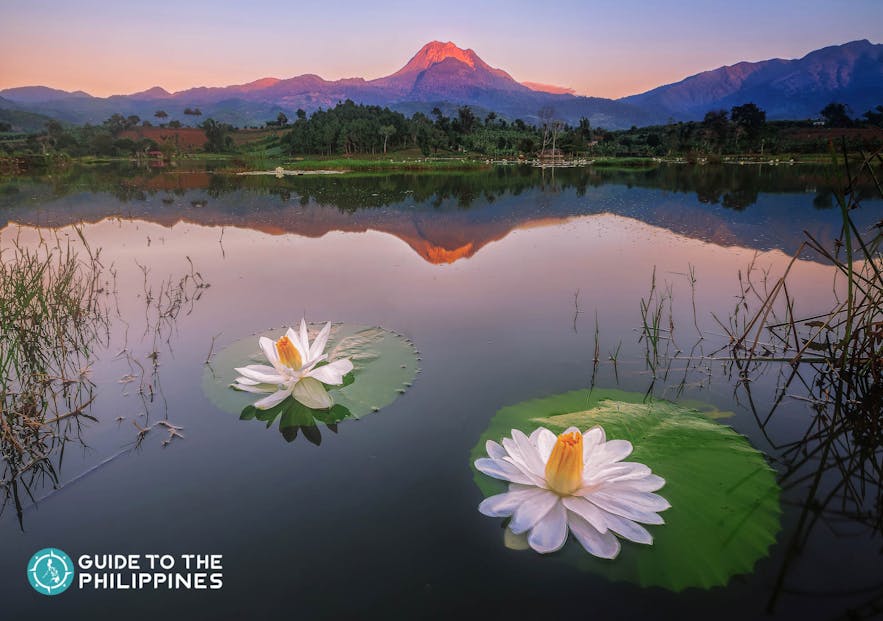
Visit Davao and be surprised by how much is in store for you. Find the top things to do in this beautiful province and what food or drink you should try while in the area by checking out this guide.
Davao City is one of the most well-known destinations in the Philippines . The city is the right mix of both natural and man-made attractions, and Davao Airport makes it accessible from other tourist destinations.
- Looking for a return ticket? Check out flights to Manila for a hassle-free Manila-Davao trip
- Book Davao City airport transfers
From parks, beaches, conservation centers of rare animals, outdoor adventures, unique local cuisine, top-notch Davao hotels , and the famous Kadayawan Festival , the province has it all for you. Read on to find out what top activities and attractions in Davao you should definitely add to your bucket list.
See our popular Davao Tours and Activities
Davao city tour b with transfers | philippine eagle center, people's park, malagos garden resort, 3-day stress-free package to davao at seda abreeza with breakfast & airport transfers, davao city tour d with transfers | crocodile park, people's park, d' bone collector museum.
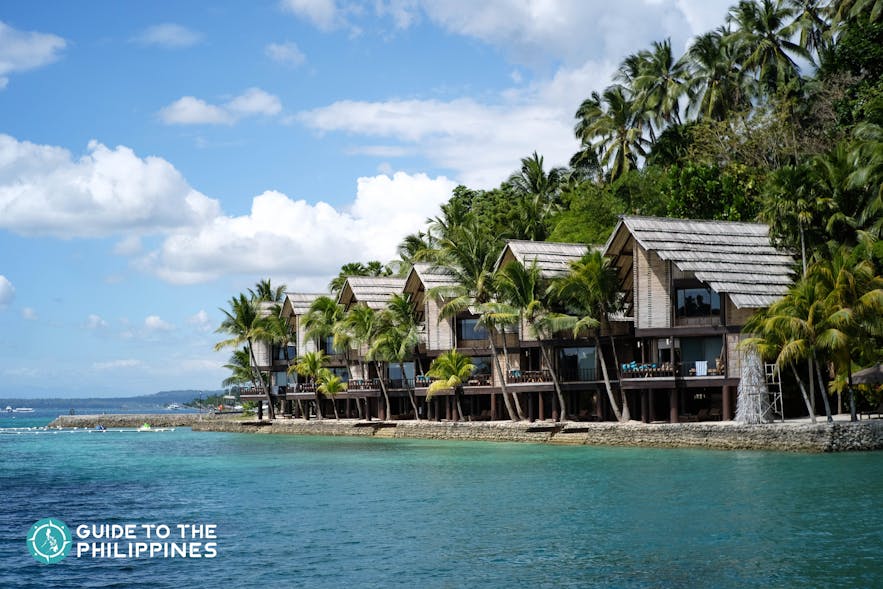
Hagimit Falls is a beautiful place to relax and unwind. The falls may be too developed for some, but it still has its natural charm. Jump off one of the tiers into the pool, go swimming, or take photos.
- Samal Davao island-hopping tour
- Samal Island tour
Climb up Mt. Puting Bato to break a sweat or get beautiful overlooking views. There are several beaches and resorts here where you can get a tan, bum around, or wade in its waters.
You can also add Monfort Bat Cave to your itinerary. They have a night immersion wherein you get to see them emerge from inside the caves! It's a great way to get close to these species. However, flash photography is not allowed, as this would disturb them.
Samal is easy to reach. From Davao City first, then make your way to the Sta. Ana Wharf for the ferry to the island. You can also join a Samal Island tour or a Samal island-hopping tour if you want a hassle-free experience exploring the various attractions in and near Samal Island.
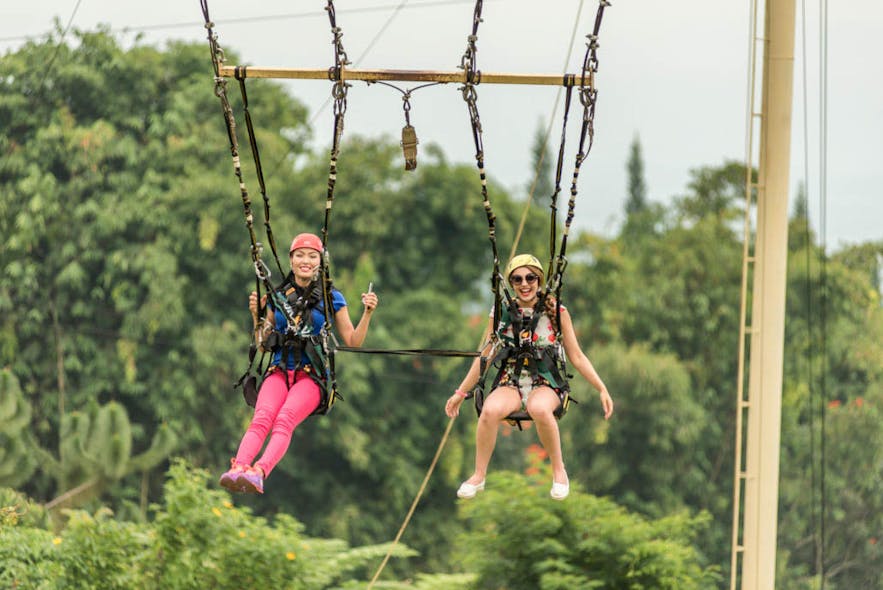
If you want to commune with nature, you have to visit this next destination. Eden Nature Park and Resort in Davao City was named after the famed Biblical Garden.
Trying out Eden Nature Park activities is highly recommended because its serenity and tropical forest climate will remove anybody's anxiety from the stress and noise of the busy city.
Whether you want to meditate alone or take a break with your family and friends, a tour in Eden Nature Park is worth it.
The Amphitheater, Lola's Garden, the Flower Garden, Plaza Maria, Mayumi's Well, and others are all tourist spots in the nature park.
Have a look at the lives and lifestyles of the Mindanaoan ancestors, and take a walk to Tinubdan and enjoy their swimming pools, playgrounds, cottages, souvenir shops, accessible areas, and a wireless internet business center.
The nature park is also a resort. They have a 24-hour front desk, an outdoor pool, and buffet breakfast. Their rooms are equipped with a flat-screen TV, a wardrobe, and an en-suite bathroom.
Staying at the park means direct access to everything it offers, which is a great way to spend time with your loved ones during your trip to Davao.
3. Unwind at Malagos Garden Resort and Chocolate Museum
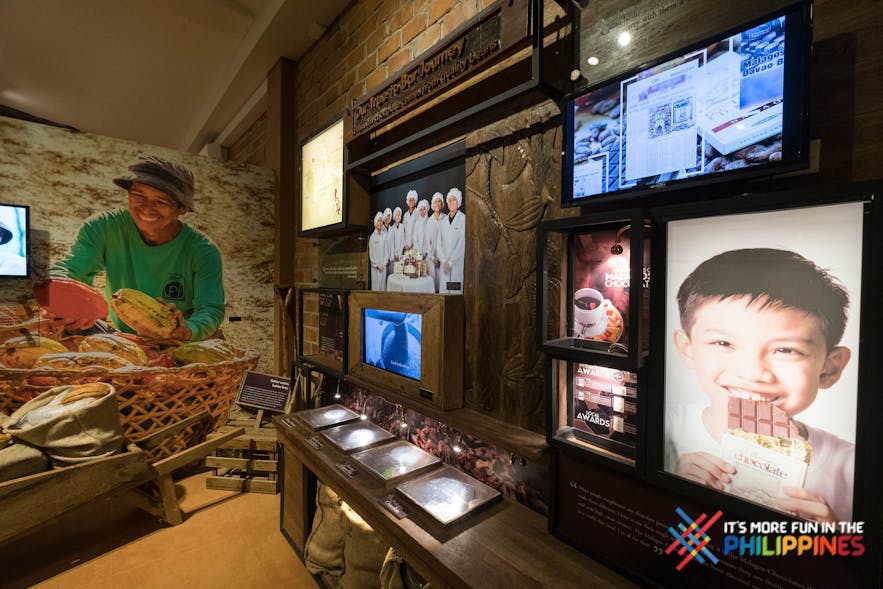
One of the best attractions in Davao is the Malagos Garden Resort . It's a 12-hectare Davao nature theme park and is a one-stop destination for travelers wanting to enjoy the environment and at the same time, find refuge in the serenity of the area.
You can encounter bird species that you can feed as you interact directly with them at the bird feeding dome.
Get close to other animals at the petting zoo, know the habits of butterflies in the butterfly sanctuary, and simply enjoy the great outdoors when you try a Malagos Garden tour .
Along with these natural locations, Malagos is also home to the Philippines' first chocolate museum. The famous tree-to-bark chocolate from Malagos is manufactured in Davao and sold to other countries like Japan.
Malagos also houses the Mindanao Contemporary Art Gallery, which showcases art and history that tackle Mindanao's rich culture.
See our popular Davao Vacation Packages
4. see the reptiles at crocodile park .
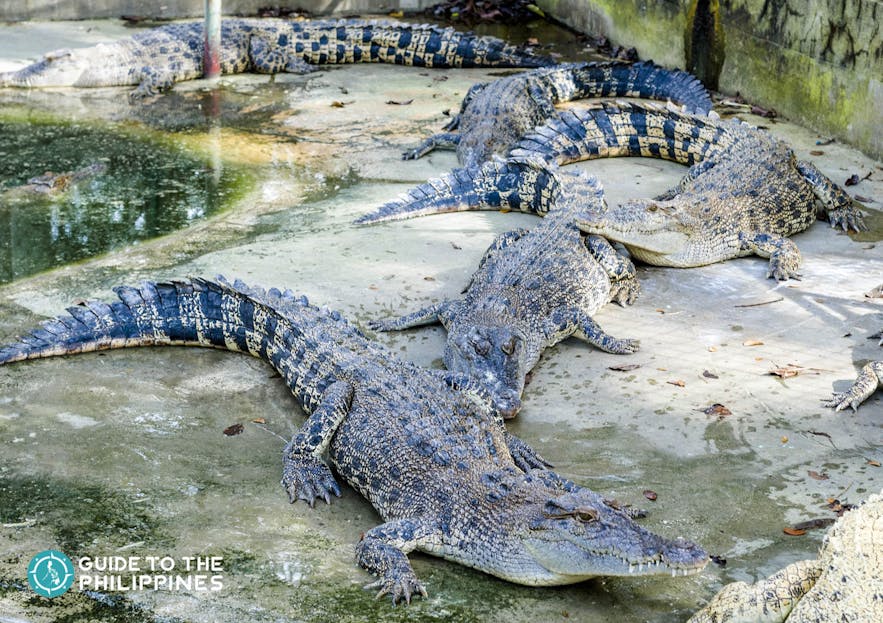
The Davao Crocodile Park is one of the popular tourist spots included in a Davao City Tour C . This destination showcases state-of-the-art crocodile farming in the country and is complete with modern equipment and facilities.
This park is home to thousands of crocodiles, both the freshwater and saltwater kinds, which are bred and born on site. Visitors can also tour the incubator room, where hundreds of crocodile eggs are cared for.
Other than crocodiles, the Davao Crocodile Park is also home to different species of birds, monkeys, snakes, and other reptiles. They also offer lectures, educational experiences, and wildlife conservation awareness.
There are several food stalls and souvenir shops just outside the park. If a culinary experience is what you are after, there is a guy selling an unusual variety of ice cream like crocodile tea, durian crocodile, crocodile roll, and chocolate ostrich at one of the food stalls.
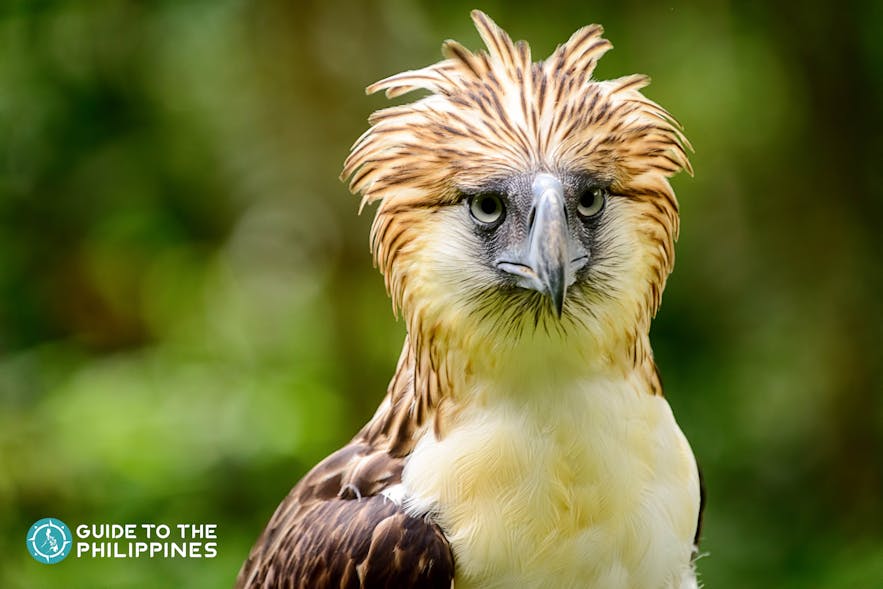
Every cent that is donated to the Philippine Eagle Center is spent on the conservation of the country's national bird. This center has dedicated effort and time to protect the endangered species while providing an exciting and fun platform for locals and visitors.
The center is home to 36 Philippine Eagles, with 18 of them being captive-bred. It is also a sanctuary for ten other species of birds, four species of mammals, and two species of reptiles. It's a well-known sustainable attraction included in the usual Davao City tour .
Visitors can watch these birds eat raw meat by slicing it with their beaks and claws. This center also provides an opportunity to watch these eagles fly freely around the property and take up close photos.
6. Relax at People's Park Davao
Visit Davao People's Park, one of the Philippines' most coveted parks. It's one of the cleanest and greenest parks in the country. The Durian Dome is one of the park's highlights and is one of the most photographed landmarks in Davao. A fitness center is also located here for everyone interested in getting active.
On one side of the complex is a learning center for children and adults. The Sunken Garden, the garden haven, and the Children's Library are located in one corner of the park, where kids of all ages can read their books whenever they like.
The Philippine Eagle replica is the most important of the major sculptures. Children can play with swings, slides, monkey bars, and much more in the children's playground.
4D3N Davao Budget Vacation Package | Hotel + Daily Breakfast + Tours + Transfers
Relaxing 3-day tour package to davao with dusitd2 hotel with airfare, breakfast & airport transfers, 7. see panoramic view at jack's ridge.
Jack's Ridge is the way to go to get the full eagle-eye views of Davao City. Other than the marvelous views, visitors can also find two restaurants here: Karlo's Gourmet, which serves coffee and different baked treats, and Taklobo, which serves Philippine food in an open-air dining area with a majestic view of the whole city.
Jack's Ridge is also part of the history of the Philippines. It was initially used as the headquarters for fleeing Japanese during the Second World War.
There is a legend that somewhere in the caves here are gold bullion bars and other loot the Japanese took from different countries and brought to Davao.
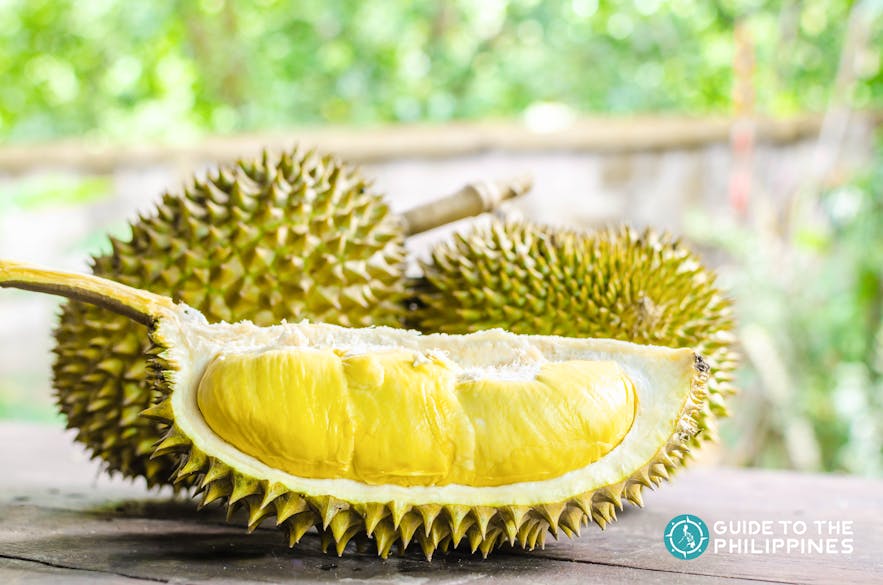
The region of Davao is generally free from typhoons. Throughout the year, the town has balmy weather. It has consistent rainfall, temperature, humidity, and air pressure distribution.
The rainy and dry season is not pronounced, and predictability in the climate makes agricultural production highly favorable. The temperature varies between 20°C and 32°C, with an average precipitation of up to 2,000 millimeters annually.
The fruit is well-known for its scent. The majority of people say it has an odorous flavor. You can try a lot of durian varieties, such as shakes, ice creams, and many more, during your trip to Davao.
Taste the different cuisines that Davao City has to offer through the Roxas Avenue Night Market. The various stalls in this famous night market are home to fresh and cooked kinds of seafood, veggies, meat, and more.
Sit down and savor a hot bowl of soup or talk to your friends while enjoying some grilled barbecue.
The prices are low, and the environment is vibrant and lively. Tables are kept close to each other for a more local feel. But, because there is no room to wash dishes, tables are wrapped in plastic, and consumers can eat with thin plastic gloves on their fingers.
Once the food stalls are closed, the clothes and accessories shops open. If you want to spend some time shopping, go for it!
The Roxas Avenue Night Market is located between the ADD University and Aldevenco Shopping Center. Spend the daytime sightseeing and doing some pasalubong shopping, and then stop by the night market after to satisfy your hunger.
The Museo Dabawenyo, or also known as the Museum of the People of Davao, is one of the most known museums in the country. This building is formally known as the Court of First Instance and was restored and rehabilitated to showcase the diverse cultural heritage and the rich history of the city.
Within the museum, visitors can see stilt house replicas, weapons, and musical instruments used by indigenous people. It also houses a full gallery of antiques like armors, chairs, crowns, and lamps of Moro People as well as traditional Filipino clothing, Filipino bills, musical notes, clothes, and more.
The Dabawenyo Museum is located on Fr. Salga Road, which is on Pichon Avenue, only a few meters from the Bonifacio Rotunda and the Osmeña Park. It is accessible from 9 AM to 12 NN from Tuesday to Sunday and from 1 PM to 6 PM on Mondays.
Local holidays wherein the museum accepts visitors are Holy Week, All Saints Day, Christmas Day, and New Year's Day.
11. Trek Mt. Apo — The Highest in the Philippines

Photo from the Philippine Department of Tourism
A trip to Davao City is not complete without a visit to the King of Philippine Peaks or Mount Apo.
Mount Apo is on top of the list of the highest mountains in Southeast Asia, and it has an elevation of 10,311 feet. Before reaching the top of Mount Apo, there is a crater lake naturally created by volcanic activities.
Seven peaks can be spotted at Mt. Apo's summit. You can see the beautiful sunset and sunrise in good weather. You'll be treated to a panoramic view of South Cotabato's Mt. Matutum, Lake Venado, and many more.
Going to Mt. Apo is one of the must-try activities while in Davao. There are various trails you can choose from, and it depends on the level of difficulty.
This mountain also houses rubber plantations as well as the Tudaya Falls, along with wild deer and boars. Experienced mountain explorers can climb the summit for March, April, and October. Various tour and mountain climbing groups organize mountain climbing events. You can also book a Mount Apo camping package for a hassle-free experience.
12. Visit Davao Butterfly House
The Davao Butterfly House is a protected sanctuary for different species of butterflies, flowers, and plants, as well as exotic species of insects and animals.
In addition to displaying colorful butterflies to the public, Davao Butterfly House also breeds them in the Learning Garden.
They allow such butterflies to help pollinate flowering plants of Davao City and to attract domestic and international travelers. Butterflies take one month to grow from eggs.
The best time for visiting the area is in the morning when it is not hot and butterflies are the most active. It is the time when these beautiful insects dance, match, and date. In the heat of the day, many species take shelter under the leaves. It's a great chance to watch and photograph them.
13. Try Civet Coffee
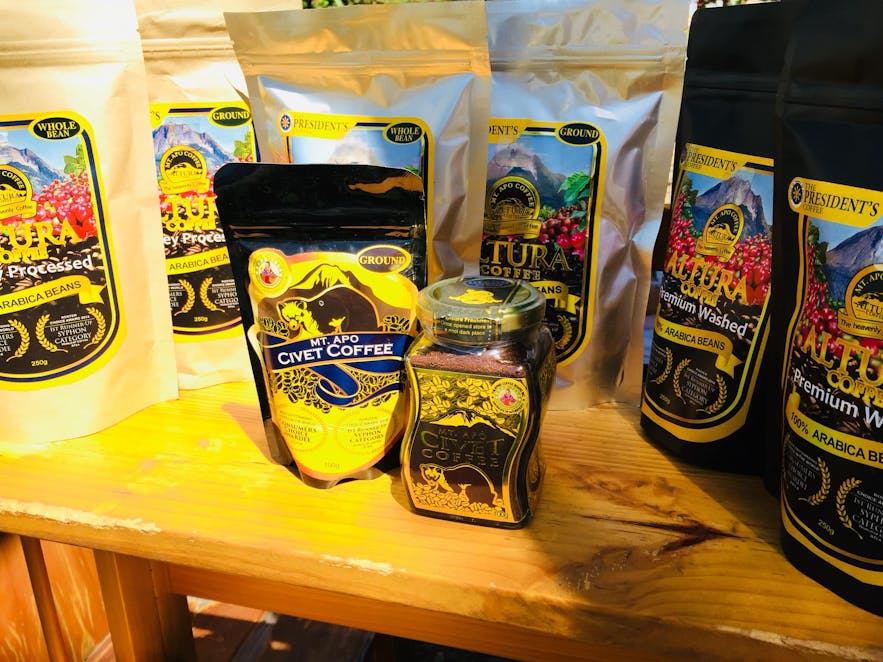
Photo from Mt. Apo Coffee
Civet Coffee is one of the most unique yet expensive coffee in the world, not only because of its taste but also the way it is prepared.
Civet Coffee is made with the help of a civet, a cat-like wild animal that is native to the country, particularly in Davao. It eats the sweet coffee cherries and then poops the beans.
This organic process gives the coffee beans a more profound and smoother flavor with no bitter taste, making it a favorite among coffee lovers. However, purchasing it in Europe or America can cost a fortune!
Getting it from the source is a less expensive option. Mt. Apo has a cafe where visitors can buy a cup and take home a bag of beans of this world-class coffee.
The strength of its dark chocolate-like scent is so natural that it tastes like roasted hazelnuts. It's a must-try drink during your stay in Davao.
14. Immerse in the Kadayawan Village
The Kadayawan Village at Magsaysay Park shows how houses of the eleven indigenous and Moro groups in Davao City are constructed. It's a popular attraction in Davao as it gives visitors not only a deeper appreciation of the indigenous and Moro's history but also an appreciation of Philippine architecture.
Here, you can get a glimpse into the Lumad and Moros’ lives and traditions. Most of the ethnic groups, such as Ata, Ovu Manovu, Bagobo-Klata, Bagobo-Tagabawa, and Matigsalug, are in the lower part of the house with a veranda or a waiting shed.
Besides the unification of these eleven communities, the village will always be witness to the heritage and culture of Davao.
15. Visit Nearby Tourist Spots in Davao Region
Explore nearby tourist spots outside the city and Samal Island. If you're up for an adventure, you can visit two of the popular attractions, Dahican Beach and Aliwagwag Falls! It's the perfect way to make your trip to Davao as complete as possible.
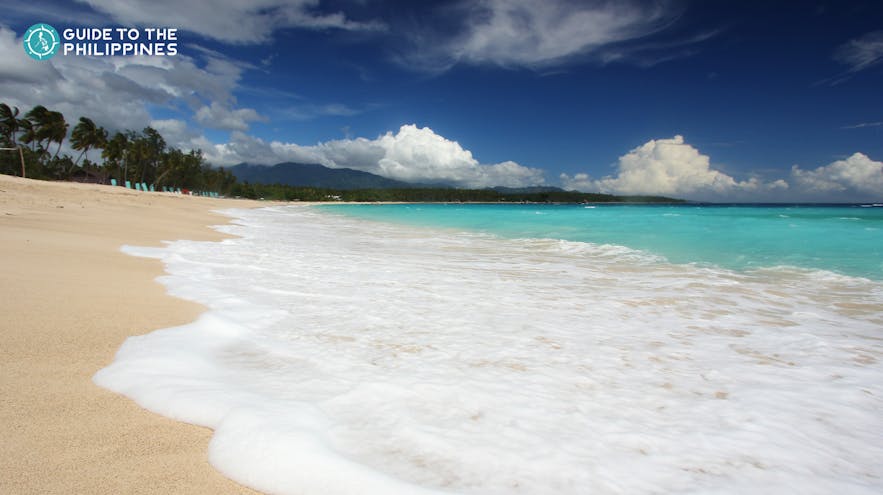
Visitors can rent a lounge chair and relax for a day or soak up the sun and explore the 7-meter-long sandbar and the crystal-clear turquoise water.
This is one of the most popular natural sights in Davao Oriental. It is also considered the highest waterfall in the Philippines. The cascades, comprising more than 100 waterfalls, are situated just 30-40 minutes from the municipality of Cateel.
See our popular Davao Hotels
Visit and Explore Davao
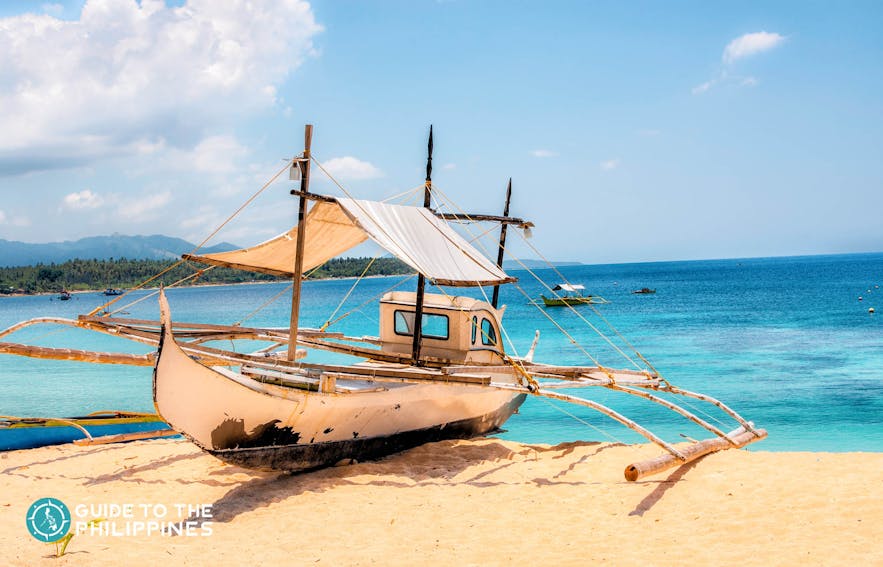
- Book flights to Davao
Explore Davao and everything it has to offer! Look into Davao tours and activities that you can add to your itinerary. You may also check out options if you want to rent a car in Davao for a hassle-free trip. Just make sure you have all the requirements to rent a car in the Philippines .
Popular articles

Best Palawan Guide: Top Tours, Where to Stay, How to Get Around
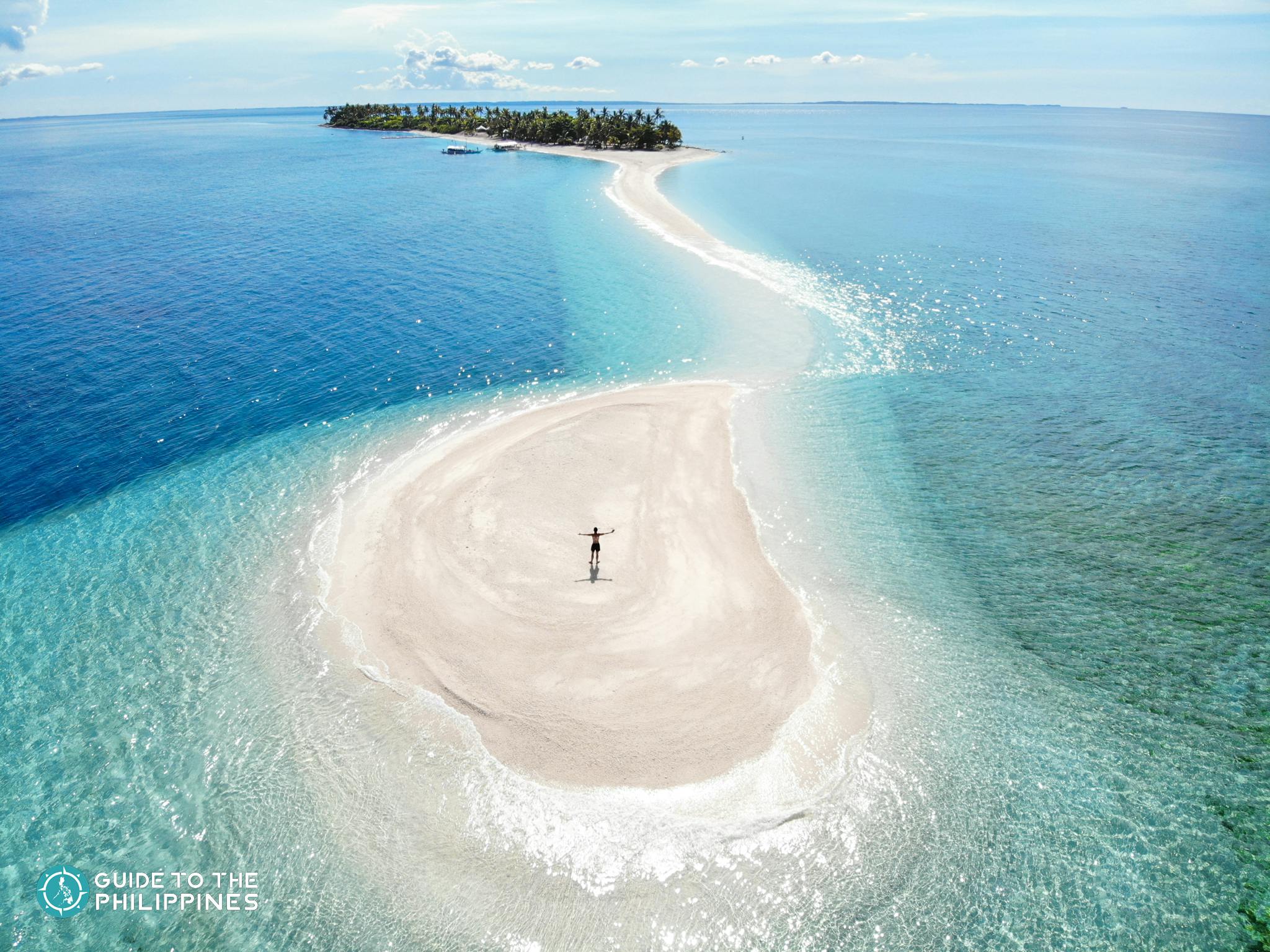
20 Most Beautiful Sandbars in the Philippines: White Sand, Longest, Vanishing
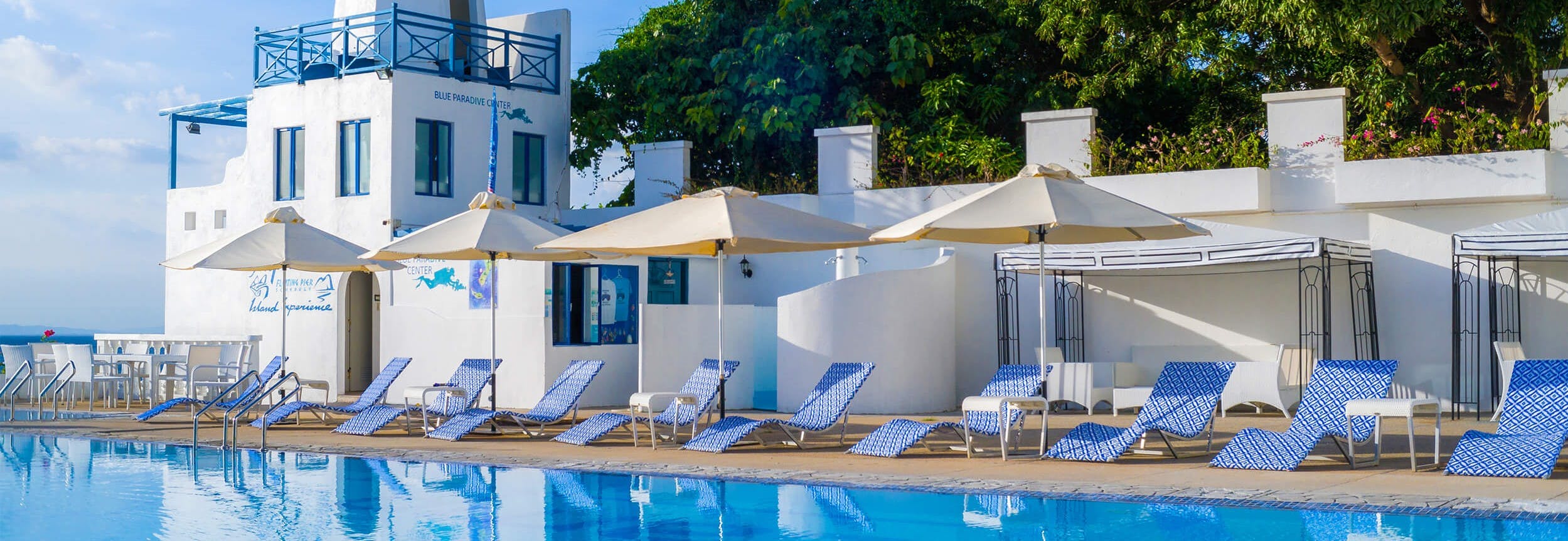
11 Best Santorini-Like Resorts in the Philippines: Near Manila, Cebu, Palawan, Vigan
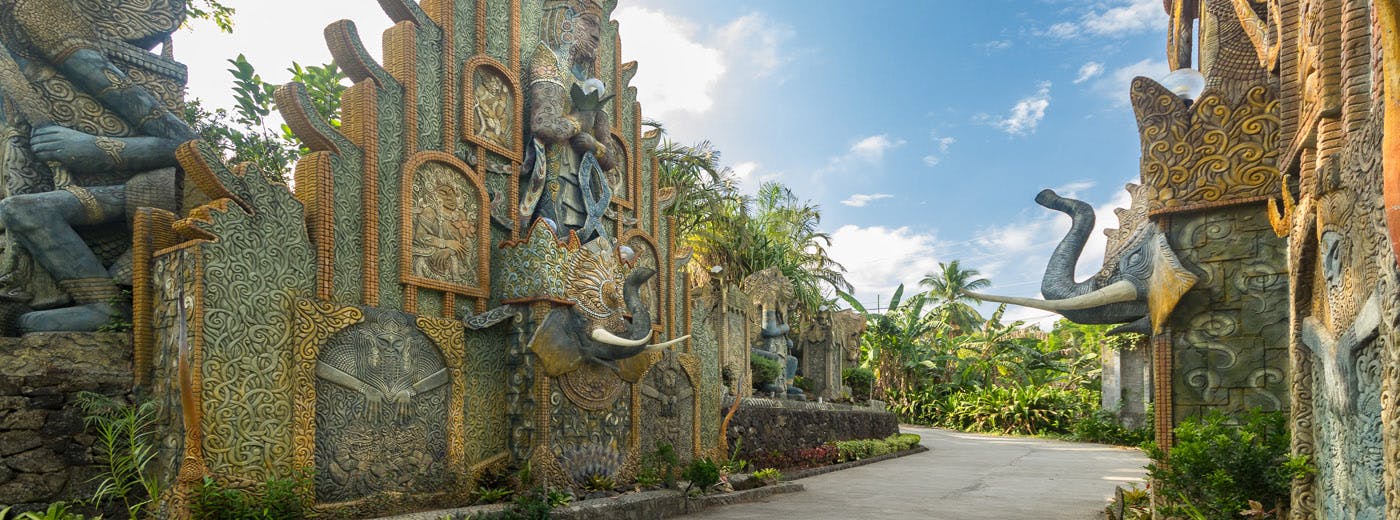
15 Best Tropical Bali-Like Resorts in the Philippines: Near Manila, Siargao, Cebu, Bohol
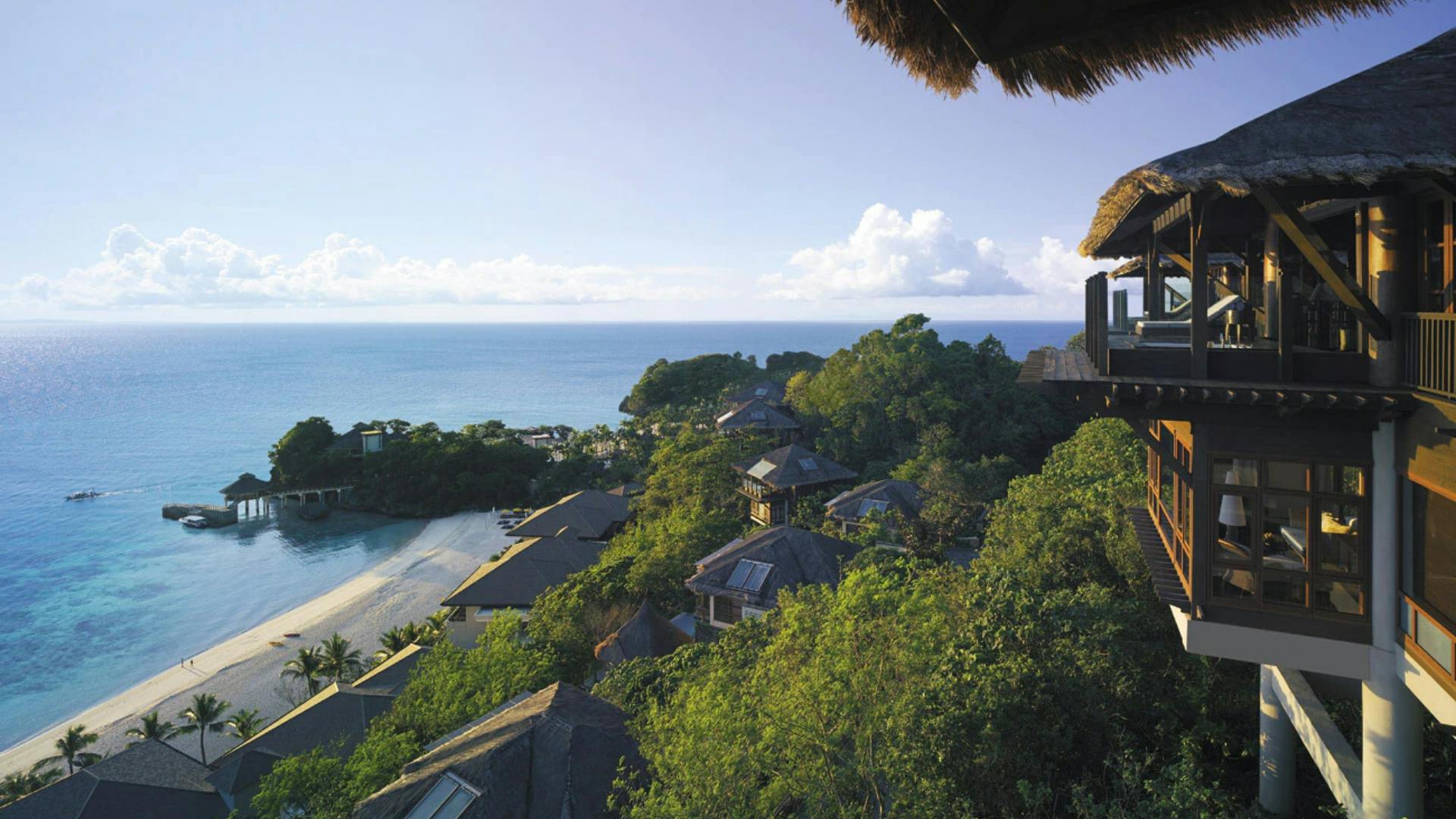
10 Best Treehouse Resorts in the Philippines for a Scenic Getaway at Mountains, Beaches & Rivers
Other interesting articles.
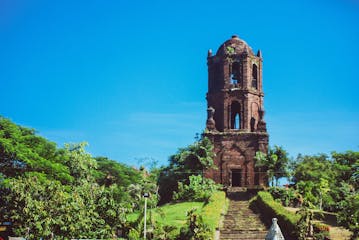
Top 10 Activities and Tours in Vigan Ilocos Sur UNESCO World Heritage Site
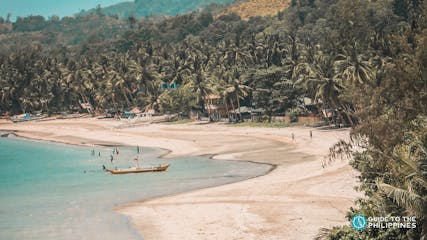
12 Best Aklan Tourist Spots: Boracay Island, Beaches, Nature Parks
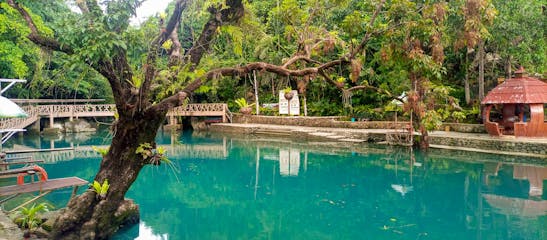
12 Best Philippines Cold Spring Resorts: Cebu, Antique, Sorsogon, Iligan
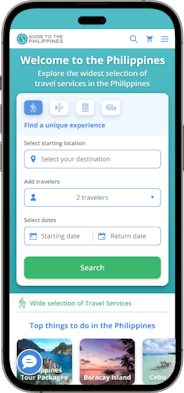
Download the Philippines’ biggest travel marketplace to your phone to manage your entire trip in one place
Scan this QR code with your phone camera and press the link that appears to add the Philippines’ biggest travel marketplace into your pocket. Enter your phone number or email address to receive an SMS or email with the download link.
Top things to do in the Philippines
Discover all the adventures you can experience in the Philippines
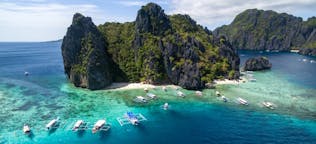
Philippines Tour Packages
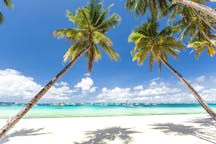
Boracay Island
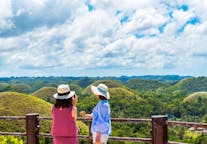
Bohol Island
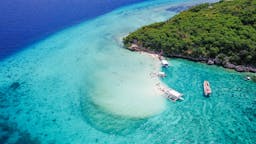
Cebu Island
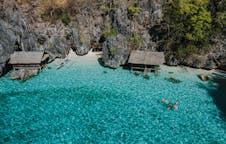
Coron Palawan
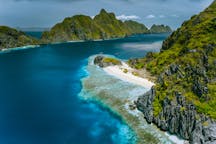
El Nido Palawan
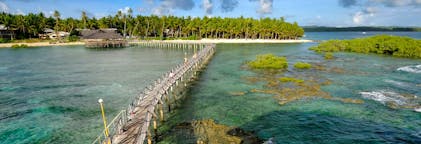
Siargao Island
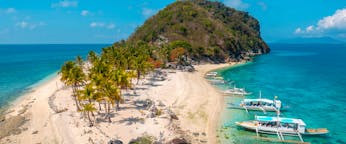
Iloilo City and Nearby
15 Best DAVAO CITY Tourist Spots (Heritage, History & Nature)
Davao City is undoubtedly one of the most popular urban cities in the Philippines along with Metro Manila and Metro Cebu where the majority of the country’s economic developments are concentrated. Davao is also the most populous city on the island of Mindanao where more than 1.7 million Filipinos live and thrive. Aside from the bustling economic activities, grand infrastructure projects, and thousands of thriving businesses in Davao, another special reason to love it more is the fact that it is one of the safest places to live in the country. This is why more and more Filipinos and even foreign investors are attracted to visit the hometown of our country’s president, Rodrigo Roa Duterte.
Despite Davao’s continuous economic growth, the city still managed to perfectly preserve its breathtaking natural wonders! From stunning tropical islands, majestic mountains, and hidden gems of tourist destinations, Davao is indeed one of the best places to visit in the Philippines. The city’s rich culture and history also play a huge role in attracting the interests of not only Filipinos but also people from different parts of the world.
So, what are you waiting for? Come and join me as we both explore all the best places of “King City of the South”. These are the 15 Best Tourist Spots in Davao City!
1. Eden Nature Park and Resort
The Eden Nature Park and Resort of Davao City is truly a paradise you shouldn’t miss. Named after the biblical Garden of Eden, this park is nestled 3,000 feet above sea level where towering trees, lush forests, and stunning landscapes are found. The park is indeed a perfect place to explore and appreciate the beauty of our nature and embrace the peaceful ambiance.
There are a lot of things to discover here in Eden Nature Park and Resort such as colorful species of flowers, incredible designs of native houses like the Balai-Kalimudan, and also the Prayer Garden where everyone can take their time to offer prayers and meditate.

The Eden Nature Park and Resort is truly a wonderful place for soul-searching and knowing more about Davao City’s rich culture. But not only that, but there are also a lot of fun and exciting activities to do here such as horseback riding, camping, swimming, and oh, taking on the challenge of trying to conquer your fear of heights in their famous SkyRider! CHECK THE BEST HOTELS IN DAVAO HERE
2. Samal Island
The Island Garden City of Samal or simply known as the breathtaking Samal Island is the largest resort city in the entire country. There are approximately 100 registered resorts scattered all around the island with a combined capacity of more than 1,000 rooms! Yup, expect to enjoy everything about an island getaway adventure here on Samal Island such as island-hopping, exploring sparkling waterfalls, and discovering the beautiful world underwater.

From its pristine white-sand beaches, turquoise waters, and all the unforgettable activities waiting for you, I’m sure that visiting Samal Island for your next summer adventure will be one of the best decisions you’ve ever made in your life.
There are countless Samal Island travel guides out there but here are some of the must-visit destinations you shouldn’t miss: Hagimit Falls, Mt. Puting Bato, Monfort Bat Cave, Kaputian Beach, Talikud Island , and many more!
READ THE BLOG POST: Samal Island Experience
3. Monfort Bat Sanctuary
One of the most popular tourist attractions in Davao City is the incredible Monfort Bat Sanctuary which is also found on the famous Samal Island. This 245 feet long cave is said to be housing more than 2.3 million Rousette Fruit Bats which is the largest colony in the whole world! The experience only gets better when the colony leaves the cave by dusk or approximately at 6 PM.

Photo by Mindanao Recreational Hub
The best part? Visitors are allowed to witness this amazing phenomenon every day but only to a limited capacity. This is to protect the ecosystem and the surrounding animals as well. There are also several educational posters on your way to the cave itself to learn more about the bats so be sure to read them when you have the chance!
4. Davao Crocodile Park
Another amazing attraction in Davao City is the famous Davao Crocodile Park where the impressive state-of-the-art crocodile farming system of the Philippines is showcased. Of course, it is the perfect place for visitors to meet the lovely reptiles up close from saltwater crocodiles, freshwater crocodiles, pythons, and other wild animals as well.
The crocodile park also features a lot of educational attractions like the Butterfly Museum, the Tribu K’Mindanawa Cultural Village, and also a chance to meet Pangil, the largest saltwater crocodile in captivity! I’m sure that everyone, especially children, will have a wonderful time here in Davao Crocodile Park.

Oh, and the park is also an established field laboratory that helps young professionals like biologists, zoologists, and veterinarians to master their crafts and learn more about the animals. So all in all, visiting the Davao Crocodile Park is both an educational and entertaining experience!
5. Jack’s Ridge
Well, nothing compares to the excitement we feel whenever we’re about to try the signature foods of a new place, right? Here at Jack’s Ridge Resort and Restaurant, tourists are given the chance to enjoy a gastronomic adventure featuring the delicious treats and delights of Davao while looking at the breathtaking view of the city’s landscape.
There are several fine dining restaurants and coffee shops here like Kai’s Bar and Grill, Taklobo Restaurant, Karlo’s Gourmet and Coffee, and many more! After eating, you can also explore and wander around the resort to enjoy the views, discover the historic Lumad Statues, visit the Amphitheater, and many more!

Jack’s Ridge really is a beautiful laid-back place where guests can just sit back and relax while enjoying everything that Davao has to offer. The best part? You can book a room or cottage here to further maximize all of the facilities and amenities of the resort!
6. Philippine Eagle Center
The Philippine Eagle, also known as the Monkey-Eating Eagle is considered the largest eagle in the world when it comes to overall length and wingspan. The eagle served as the country’s face and pride in many aspects which highly speaks of its significance to the whole Philippines.

Photo by Philippine Eagle Foundation
Unfortunately, due to heartless hunting activities and habitat loss, the Philippine Eagle has become one of the most endangered species in the world. This is why the establishment of Davao City’s Philippine Eagle Center gives us high hopes of preserving the lives of these beautiful animals. The center is nestled within a rainforest covering a huge area of 8 hectares where the eagles can fly around safely.
Of course, the Philippine Eagle Center also gives tourists a chance to explore the beauty of not only our country’s avian wildlife but also other animals as well like monkeys, crocodiles, and many more!
7. Malagos Garden Resort and Chocolate Museum
For those who don’t know, Davao City is hailed as the “Chocolate Capital of the Philippines” because it is the Philippines’ biggest producer of cacao. Well, this is also one of the major reasons why the famous Malagos Garden Resort and Chocolate Museum was established in 2017!
Covering a huge area of more than 12 hectares, the resort features countless fun and exciting activities that will let them enjoy everything that Davao City has to offer! From horseback riding, calesa rides, bird feeding, visiting butterfly sanctuaries, and many more, the Malagos Garden Resort definitely offers an all-in travel experience to everyone!

You can create your own chocolate at Malagos Chocolate Museum.

Photo ops with my chocolate. LOL
Aside from the already spectacular attractions that Malagos Garden Resort offers, it also opened the first-ever chocolate museum in the country in 2017. The Malagos Chocolate Museum beautifully displays everything to know about Davao City’s thriving chocolate businesses. The museum is actually divided into four (4) phases namely: Museum Section, Interactive Zone, Chocolate Bar, and the Malagos Chocolate Laboratory where guests are given the chance to make their very-own chocolates! See? Such a fun-filled and educational experience indeed!
The “Tree to Bar” experience brought by the Malagos Chocolate Museum truly is an unforgettable adventure, especially for children! So be sure not to miss visiting the amazing Malagos Garden Resort and Chocolate Museum, okay?
8. People’s Park
One of the best things to do when visiting a new place is to interact with the locals because it gives us a chance to know more about the rich culture and history of the place. Well, the best place to do that in Davao City is at the People’s Park. It’s a four-hectare cultural theme park featuring some of the most impressive attractions you’ll ever find in the country.

Credit: Davao City Gov
There’s the Mini Forest, Giant Durian Dome, Children’s Playground, the Philippine Rainforest, and many more! The prestigious park actually offers a lot of fun and exciting memory-making opportunities for both children and adults because you can easily spend a whole day at this park and still be able to constantly discover new things!
So whether you’re looking for the most beautiful places to take pictures, buy souvenirs, or watch entertaining performances, People’s Park Davao is definitely the perfect place to be. Oh, and you know what the best part is? The entrance fee is absolutely free-of-charge!
9. Davao Cathedral | San Pedro Cathedral
Another prominent landmark in Davao City that should be included in your itinerary is the San Pedro Cathedral or better known as the Davao Cathedral. Built way back in 1847, the cathedral is considered the oldest one in Davao City. It is also hailed as a Natural Cultural Treasure and treated as a very important piece of Davao’s religious and cultural history.

Credit: San Pedro Cathedral Parish
What captures the attention of everyone visiting the cathedral is its unique architectural design featuring a frontal-curved solid facade which is genuinely fitting to be the center of a thriving community. Taking a nice picture here would be a great proof of visiting Davao City!
10. Mount Apo
Ah, of course! Davao City is known for a lot of things but probably the most significant of those is the fact that the tallest mountain in the Philippines, Mount Apo, is situated here. Towering with an elevation of 2,954 meters above sea level, the mountain sits on top of the list of all mountaineers and hikers all over the country. It is the ultimate dream of each and every one of them to conquer the highest peak in the country. With Mount Apo’s lush forests, abundant wildlife, and breathtaking sea of clouds, having the chance to hike atop the highest mountain in the country truly is an experience you won’t forget.

Photo by Mount Apo Natural Park RXII
Oh, and don’t worry! If you’re not into mountain-climbing and hiking activities, you can still admire the beauty of Mount Apo by visiting Mount Apo Natural Park. This enormous park spans an area of more than 64,000 hectares where tourists can enjoy the firsthand experience of exploring the mountain’s incredible natural features such as its beautiful flora and fauna, the 272 bird species living in it, and the several indigenous tribes inhabiting the area.
11. Museo Dabawenyo
Part of exploring and visiting a new place is learning more about its culture and history. And aside from interacting with the locals, one way to do it is by visiting a museum. So for our next destination, we’ll be exploring Museo Dabawenyo which is famous for depicting the city’s rich history through fifty (50) incredible artifacts.

Photo by Davao City Gov
Yup! From its history, culture, and art, to the latest technology and environmental developments of Davao City, everything is covered and beautifully displayed in this museum. All the prominent figures in history, historical places, and events are represented here at Museo Dabawenyo.
12. Davao Durian and Fruit Stands
Aside from being known as the Chocolate Capital of the Philippines, Davao City is also hailed as the Durian Capital of the Philippines thanks to its abundant supply of the Durian fruit and other products made of Durian. Although it is popularly known for its strong and funny smell, Durian is considered the “King of All Fruits” because it is said to contain very high levels of nutrients.

Despite its reputation, Durian is still one of the most significant attractions in Davao City, and your trip wouldn’t be complete without buying it as your pasalubong! So don’t forget to buy Davao Durian and other local fruits from any fruit stand you can come across during your trip, okay?
13. Davao Butterfly House
The Davao Butterfly House is also a wonderful experience for people of all ages thanks to the colorful exhibit of live butterflies wandering around the house. It’s definitely a must-visit attraction, especially for butterfly enthusiasts but I’m sure that everyone will have a good time viewing the aesthetic species of flowers along with other wonderful insects like crickets, tarantulas, and scorpions, and many more.
The Davao Butterfly House is just nearby the Davao Crocodile Park so be sure to pay a visit when you have the chance!
14. Roxas Night Market
Just like what we’ve mentioned earlier, Davao City is also one of the highly-developed metropolises in the country. So aside from the stunning natural wonders and its rich history, Davao City is also the perfect place to have some fun!

Well, the best place to do that in Davao City is no other than the famous Roxas Night Market. It is the most popular place in Davao City where you can truly immerse yourself in the Dabawenyo culture featuring their food delicacies, fashion, and even wellness experiences. Hundreds of vendors and massage therapists have their own stores here at the Roxas Night Market so be sure to drop by and have some fun during your visit!
15. Kadayawan Village
Ah, yes! Finally, our last destination is the beautiful Kadayawan Village located at Magsaysay Park where tourists are given a chance to witness how the native houses from the 11 indigenous groups are constructed. It gives us a glimpse of how significant these indigenous groups are to the culture and history of our country as a whole.
The incredible exhibit also showcases how the location of each tribe in the country plays an important role in preserving and promoting the indigenous culture of Davao City.
FAQ: Best Tourist Spots in Davao City
1. What are the top natural attractions in Davao City? Davao City is blessed with stunning natural attractions. Eden Nature Park and Resort is perfect for a serene mountain retreat. For beach lovers, Samal Island offers beautiful beaches and clear waters. Mount Apo, the highest peak in the Philippines, is a must-visit for trekkers and nature enthusiasts.
2. Are there any unique wildlife experiences in Davao? Absolutely! The Monfort Bat Sanctuary is known for its massive colony of fruit bats. For a more diverse wildlife experience, the Davao Crocodile Park is home to crocodiles and other exotic animals. Also, don’t miss the Philippine Eagle Center, dedicated to the conservation of the majestic Philippine Eagle.
3. Can you recommend places for cultural and historical experiences? Davao’s rich history and culture can be explored at several spots. The Museo Dabawenyo offers insights into the region’s history and culture. San Pedro Cathedral is an iconic historical landmark. For a glimpse into the local indigenous cultures, visit Kadayawan Village.
4. Where can I enjoy local food and night markets in Davao? The Roxas Night Market is a must-visit for food enthusiasts. It’s famous for its street food and local delicacies. For fruit lovers, Davao’s Durian and Fruit Stands are ideal to taste the famed Durian and other tropical fruits.
5. What are some family-friendly spots in Davao City? Families will enjoy the Malagos Garden Resort and Chocolate Museum, where you can learn about chocolate making. The Davao Butterfly House is also great for kids, offering a chance to see various butterfly species up close. People’s Park, with its beautiful landscapes and art, is perfect for a family day out.
6. Is there any place in Davao for scenic views or relaxation? Jack’s Ridge offers breathtaking panoramic views of Davao City. For a peaceful escape within the city, People’s Park is ideal with its lush greenery and artistic installations.
7. Are there any hidden gems in Davao City I should know about? While not as widely known as other spots, the Malagos Garden Resort and Chocolate Museum is a delightful hidden gem, especially for chocolate enthusiasts. Also, exploring the local fruit stands for exotic fruits can be a unique experience.
8. Is Davao City suitable for adventure seekers? Yes, adventure seekers will find Mount Apo an exhilarating challenge. Additionally, Samal Island offers various water activities like diving and snorkeling.
More Davao and Mindanao Blog Posts
- 10 Best Beach Resorts in Samal Island
- 15 Best SARANGANI BEACH RESORTS (Diving & Snorkeling in Mindanao)
- El Don Resort in Davao Oriental
- 5 Festivals in Davao City
- 15 Best Camiguin Tourist Spots
- Dahican Beach in Davao Oriental

previous
PITX to MOA By Modern Jeepney (Guide, Tips & More)

newer
15 Best BICOL TOURIST SPOTS (Heritage, Islands & Nature)
You might also like.

5 Best FESTIVALS in DAVAO City (vibrant celebrations)
Leave a reply cancel reply, privacy overview.
14 Things to do in Davao + Tourist Spots

Davao City is the largest urban center in Southern Philippines and the third-largest metropolitan area in the Philippines after Manila and Cebu. Davao is famous for its natural attractions, many of which are easily reached from the city center.
Within an hour’s travel from the airport or Davao City hotels, you can already enjoy the pristine white sand beaches of Samal Island or visit the highland nature parks at the foot of Mount Apo, the Philippines’ tallest peak. A trip to Davao isn’t complete without a taste of the iconic Durian fruit and meeting the gigantic Philippine Eagle, the country’s national bird.
Davao City is also the gateway to surrounding provinces in the Davao Region as well as nearby regions in the southern & eastern parts of Mindanao.
Here’s a list of beautiful places to visit in Davao including top things to do & the best Davao tourist spots.
To make your trip planning easy, I’ve added links to the locations on Google Maps. Feel free to click/tap on the links posted. Then, use the “save” feature on the Google Maps app. Seeing all your saved locations on the map will help you get started on planning your Davao itinerary and know the best areas to stay, near places you want to go.
See also: Best Travel Apps .
View all travel tips on: Davao .
1. Philippine Eagle Center

Philippine Eagle Center in Davao City, Philippines
Location : Barangay Malagos, Calinan district, Davao City . Save on Google Maps .
Mindanao’s rainforests are home to the great Philippine Eagle, the country’s national bird and one of the largest eagles in the World. Visit the Philippine Eagle Center and meet the critically endangered Philippine Eagle. Here, the eagles are bred for eventual release into the wild. Resembling a typical rain forest, it’s a great place to get a feel of nature. There’s a number of other birds, mammals and reptiles as well, most of which are endemic to the country and some are considered rare.

Book your trip to Davao
Before you start ticking goals off your bucketlist, here are travel essentials & discounts you’ll need to check. Pre-book online for a hassle-free trip! Click below to compare rates & read reviews:
Davao Hotels Tours + discounts Flights
Popular tours & discounts booked by other travelers:
Davao (DVO) Airport to Hotel/City Private Transfer
Davao 24hr COVID-19 RT-PCR and Rapid Antigen Testing
Davao COVID-19 Rapid Antigen Testing
For more travel inspiration, follow Detourista on :
Instagram Facebook Tiktok Pinterest
2. Eden Nature Park

Davao City skyline view from Eden Nature Park, in Davao City, Philippines
Location : Barangay Eden, Toril, Davao City . Save on Google Maps .
Explore a pine forest, breathe the cool mountain air, and enjoy the breathtaking viewpoints. Eden Nature Park is a relaxing highland area that you can easily visit from the city center. This park resort offers homey accommodations, various restaurants that use ingredients food freshly harvested from gardens in the area, fun outdoor activities, hiking trails, and a cultural village.

Samal Island
Location : Island Garden City of Samal (IGaCOS), Davao del Norte . Save on Google Maps .
Looking for a beach near Davao City? Samal Island is the go-to destination for locals and visitors alike. Samal, officially the Island Garden City of Samal (IGaCOS) is part of Metro Davao and Davao del Norte Province. Easily reached from the city, it is known for its many white-sand beaches, beautiful resorts, island hopping tours, and inland attractions.
Samal Travel Essentials
Where to stay
Top discounts
Philippines Unlimited Data eSIM (QR Email Delivery)
Philippines 4G Data eSIM (QR Email Delivery)
Asia 4G LTE WIFI Hotspot (Manila Airport Pick Up)
3. Samal Beach Resorts
Samal Island is home to one of the most famous luxury resorts in the Philippines — The Pearl Farm Beach Resort, a former pearl farm made iconic by its stilt-house inspired villas. You can also find more beach resorts dotted around the island…. from accommodations offering peaceful retreats to resorts featuring fun water sports and activities.
Popular resorts in Samal
Pearl Farm Beach Resort Location: Kaputian, Samal Island. Save on Google Maps . See room discounts
Isla Reta Location: Talicud Island. Save on Google Maps .
Bluejaz Beach Resort and Waterpark Location: Babak, Samal Island. Save on Google Maps . See room discounts
Paradise Island Beach Resort Location: Babak, Samal Island. Save on Google Maps . See room discounts
Maxima Aquafun Resort Location: Peñaplata, Samal Island. Save on Google Maps . See room discounts
Hof Gorei Beach Resort Location: Kaputian, Samal Island. Save on Google Maps . See room discounts
Chema’s by the Sea Location: Limao, Samal Island. Save on Google Maps . See room discounts
Bluewaters Village and Resort Location: Limao, Samal Island. Save on Google Maps .
4. Samal Islands & Beaches

Babu Santa Beach in Talikud Island, Samal, Davao del Norte, Philippines
Go on a tour of Samal’s beautiful white-sand beaches and underwater sights. There are many places to go in the main island of Samal, remote Talicud Island and off-short islets.
Beautiful islands, tourist spots and beaches in Samal
Kaputian Beach Location: Samal Island. Save on Google Maps .
Isla Reta Beach Location: Talicud Island. Save on Google Maps .
Babusanta Beach Location: Talicud Island. Save on Google Maps .
Coral Garden Location: Save on Google Maps .
Angel’s Cove Location: Save on Google Maps .
Wishing Island Location: Save on Google Maps .
Taklobo (Giant Clam) Sanctuary Location: Save on Google Maps .
Malipano Island Location: Save on Google Maps .

5. Monfort Bat Colony

Monfort Bat Colony in Samal Island, Davao del Norte, Philippines
Location : Monfort Bat Sanctuary, Babak, Samal Island . Save on Google Maps .
This is one of the most unusual sights in the Philippines! The Monfort Bat Colony is a must-visit when in Samal. Here, you can see small caves filled with millions of Geoffroy’s Rousettes fruit bats, which call the sanctuary home. The caves are so tightly covered with these bats that the cave walls look like one dark living mass.

6. Davao Crocodile Park

Crocodile Park, Davao City
Location : Riverfront, Corporate City, Diversion Highway, Ma-a, Davao City . Save on Google Maps .
The Davao Crocodile Park is one of Davao’s top tourist spots. Thousands of cultured crocodiles can be found here including Pangil, one of the largest captive crocodiles in the Philippines. If you’re fascinated with these giant reptiles, this is the place to go. Nearby, you can also visit the Tribu K Mindanawan Cultural Village and Davao Butterfly House.
Tourist spots near Davao Crocodile Park
Tribu K Mindanawan Cultural Village Location: Save on Google Maps .
Davao Butterfly House Location: Save on Google Maps .
Davao City Center
Travel Essentials
Where to stay Tours + discounts Check Fares
See more : Davao City Center travel tips
7. People’s Park

People’s Park in Davao City, Philippines
Location : Palma Gil Street, Poblacion, Davao City . Save on Google Maps .
A well-maintained public park in the city center, People’s Park features a gigantic statue of the Philippine Eagle, a Durian-inspired dome, fascinating sculptural works by local artists, and paved walking paths covered by shady trees.

8. Davao Cathedral (San Pedro Cathedral) & San Pedro Street

Davao Cathedral, Davao City
Location : San Pedro Street, Poblacion, Davao City . Save on Google Maps .
The oldest church in Davao City. The Davao Cathedral, also known as San Pedro Cathedral, is a historical landmark, recognized as a National Cultural Treasure. One of the first things you’ll notice is its distinct curved roof said resembling a vinta (traditional sailboat)
Other places of interest in San Pedro Street area
Davao City Hall Location: Save on Google Maps .
Osmeña Park Location: Save on Google Maps .
Rizal Park Location: Save on Google Maps .
Quezon Park Location: Save on Google Maps .
Commemorative Monument of Peace and Unity / Davao City Council Location: Save on Google Maps .

9. Jack’s Ridge

Jack’s Ridge in Davao City, Philippines
Location : Shrine Hills Road, Matina . Save on Google Maps .
Make your way up the mountain and get a panoramic view of Davao City while enjoying a sumptuous dinner at Jack’s Ridge. Taklobo restaurant offers open-air dining and Filipino comfort food while Karlo’s Gourmet serves coffee and pastries.
10. Davao Durian & Fruit Stands

“Tastes like heaven but smells like hell”, Durian is considered as the symbol of the city. There’s no better place to try the exotic Durian than at the fruit markets in Davao. Head to the street-side fruit stalls fronting Magsaysay Park and have the sellers crack open a fruit. After you get used to the strong signature odor, take a pinch of the golden pulp and savor the creamy goodness. Bangkerohan Market is also a great place to go for a more local market feel.
Where to buy durian and fruits in Davao City
Magsaysay Park Location: Quezon Boulevard-Leon Garcia Street. Save on Google Maps .
Bankerohan Market Location: Marifori Street. Save on Google Maps .
Madrazo Fruit Stands Location: C. Bangoy Street.

11. Chinatown

Davao Chinatown Unity Archway in Davao City, Philippines
Location : Ramon Magsaysay Avenue, Poblacion, Davao City . Save on Google Maps .
Davao’s Chinatown is the largest in the Philippines by land area and the only one in Mindanao. It is the primary residential area of the Filipino-Chinese community in the city. There are four Chinese-style archways in Davao Chinatown. A large arch is located across the street from Magsaysay Park). Within the area, you can go the temples including the Long Hua Buddhist Temple, Polian Temple and Mindanao Taoist Temple.
12. Mount Apo

Mount Apo view from Davao International Airport, Davao City, Philippines
Location : Near Davao City-Kidapawan City, Cotabato border . Save on Google Maps .
13. Malagos Garden Resort & Chocolate Museum
Location : Malagos, Davao City . Save on Google Maps .
After a visit to the Philippine Eagle Center, drop by Malagos Garden Resort. This 12-hectare nature park is a popular tourist spot for its butterfly sanctuary, waling-waling orchid forest, a bird feeding dome, and the Chocolate Museum.
14. Davao Malls & Shopping

Davao is not spared from the mall-craze in the Philippines. Huge shopping malls can be found all over the city offering cool comforts, great shopping, food courts, and a wide selection of restaurants.
Popular malls and shopping centers in Davao
Abreeza Mall by Ayala Location: Abreeza Ayala Business Park, J.P. Laurel Avenue, Poblacion. Save on Google Maps .
SM Lanang Premier Location: Daang Maharlika Highway, Lanang. Save on Google Maps .
Gaisano Mall of Davao (G-Mall) Location: J.P. Laurel Avenue. Save on Google Maps .
SM City Davao Location: Ecoland Drive, Matina. Save on Google Maps .
NCCC Mall Location: MacArthur Highway. Save on Google Maps .
Aldevinco Shopping Center Location: C. M. Recto Street. Save on Google Maps .
Other places of interest in Davao City

Giant Durian Sculpture at Davao International Airport, Philippines
Durian Monument Location: Davao-Francisco Bangoy International Airport grounds, Buhangin, Davao City. Save on Google Maps .
Shrine of the Holy Infant Jesus of Prague Location: Shrine Hill, Talomo. Save on Google Maps .
Apo ni Lola Durian Factory Location: San Miguel village, Talomo. Save on Google Maps .
House of President Duterte Location: Doña Luisa Subdivision Phase I, Davao City.
Davao 911 Center
Davao Museums
Museo Dabawenyo (temporarily relocated to Philippine Women’s College Mindanao Folk Arts Museum)
Philippine Women’s College Mindanao Folk Arts Museum Location: Juna Subdivision, Talomo. Save on Google Maps .
Davao Museum of History and Ethnography Location: Insular Village, Lanang. Save on Google Maps .
D’ Bone Collector Museum Location: San Pedro Street, Poblacion, Davao City. Save on Google Maps .

Aliwagwag Falls

Aliwagwag Falls in Cateel, Davao Oriental, Philippines
Location : Cateel, Davao Oriental . Save on Google Maps .
Aliwagwag Falls is one of the most beautiful waterfalls in the Philippines. It is truly a must-visit for all waterfall lovers. This is Aliwagwag Falls, often remarked as the “Highest Waterfall in the Philippines.” Unlike most falls with only one or a few vertical drops, Aliwagwag Falls is composed of 84 steps with a combined height of 340 m (1,110 feet), and what’s more, it is surrounded by one of the largest remaining blocks of tropical lowland rainforest in the Philippines.
How to go :
Aliwagwag Falls is located in the quiet town of Cateel in Davao Oriental Province. The drive from Davao City to Aliwagwag Falls is around 4 to 5 hours. You can get a nice view on the bridge along the Compostela-Cateel Road. No hiking required!

Explore more spots near Davao
General Santos

General Santos Fish Port (Tuna Market) in General Santos City, South Cotabato, Philippines
Location : South Cotabato Province . Save on Google Maps .
Located 2 to 3 hours away from Davao by land, General Santos City is the “Tuna Capital of the Philippines” and the gateway to the Soccsksargen Region, which occupies the South Central part of Mindanao Island.
General Santos Travel Essentials
Where to stay Check Fares
Paragliding Experience in South Cotabato
See discounts
See more : General Santos travel tips

Visit the scenic lakeside town of Lake Sebu known for its beautiful waterfalls, 180-meter high 7 Falls zipline (the highest in Asia), and T’boli mountain tribe culture. Travel time from General Santos to Lake Sebu is around 2 hours.
Lake Sebu Travel Essentials
See more : Lake Sebu travel tips

Balut Island & Sarangani Islands
Location : Sarangani (islands), Davao Occidental . Save on Google Maps .
Go on an adventure to remote Balut Island in Davao Occidental Province. Go on a trek to the forest-topped summit of Balut Volcano, see the Sabang Hot Spring and go on an island hopping tour to see the pink sand beach in Olanivan Island.

Beyond Davao

Virgin Island in Bantayan, Cebu, Philippines
Location : Central Visayas region, central Philippines . Save on Google Maps .
Cebu Travel Essentials
Where to stay Tours + discounts Tours + discounts Check Fares
See more : Cebu travel tips

Location : Metro Manila, Luzon, northern Philippines . Save on Google Maps .
Manila Travel Essentials
Manila-Luzon Shuttle – Tagaytay, Baguio, Laguna, La Union & more
Enchanted Kingdom Admission Ticket
Manila Ocean Park Attraction Pass
See more : Manila travel tips

What places have you added to your bucketlist? Have you been to beautiful places in Davao that should be on this list? Feel free to share your thoughts!
Places to visit in Davao
Davao tourist spots, things to do in Davao, where to go in Davao & more.
Note: Destinations featured above are not listed by rank.
Book your way to Davao
How much does it cost to travel to Davao? Click below to compare flight, ferry & buses fares posted on these booking sites:
Where to Stay in Davao
Click below & search recommended Davao hotels/hostels/home rentals within your budget. Remember to set your min/max price , travel dates, and sort by review ratings . I often book online with these trusted booking sites below for rock-bottom prices & convenient bookings.
Agoda Booking.com
Book sooner rather than later if you already have your dates set. Cheaper-priced rooms and hotels with high reviews tend to get fully booked faster, especially during busy days like weekends, holidays & peak tourist seasons.
Where to Stay in Samal
Click below & search recommended Samal hotels/hostels/home rentals within your budget. Remember to set your min/max price , travel dates, and sort by review ratings . I often book online with these trusted booking sites below for rock-bottom prices & convenient bookings.
Don’t Stop Here
Click below for more travel inspiration:
Don’t leave yet. There’s more!

Discover more blogs and travel tips in:
- Southeast Asia
- Philippines
Leave a Reply Cancel reply
Your email address will not be published. Required fields are marked *
This site uses Akismet to reduce spam. Learn how your comment data is processed .
February 22, 2019 at 6:11 pm
Davao is my all time fav city
February 23, 2019 at 12:53 am
Awesome Levia! What do you like most about Davao City?
April 18, 2019 at 12:48 am
Wow!! so many great things It is Very helpful for planning a trip to davao. Thanks for sharing this.
April 20, 2019 at 4:55 am
My pleasure! Thanks for visiting abdou :)
April 21, 2019 at 7:37 am
Thanks a lot your blog, It’s Very helpful for planning a trip
June 3, 2019 at 4:10 pm
I’ve been eyeing for Davao for quite a while now and this post inspired me. Thanks for this informative post, Sir Marcos! :)
June 13, 2019 at 2:55 am
Thanks for visiting by travel blog Dea!
September 16, 2019 at 10:25 am
How far are these tourist spots from Buhangin Davao?
September 19, 2019 at 11:21 am
Hi Pauline! Google Maps is really helpful with this. I use it always when I plan my trip! Just save all the locations on Google Maps to have a quick overview of how close destinations are to each other.
October 22, 2019 at 9:15 pm
Hi! Your blog is very helpful and informative for a first-timer in Davao! Thanks for sharing!
November 21, 2019 at 12:26 pm
12 out of 14. I’m almost complete in experiencing the beautiful Davao.
March 6, 2020 at 4:32 pm
Very informative!
March 6, 2020 at 4:39 pm
September 9, 2020 at 3:55 pm
Davao does hold a lot of cultural places and most of them are accessible. I hope I could travel there again when this pandemic is over.
February 18, 2021 at 1:46 pm
Agree. Hoping that this pandemic will end soon so that you can explore more in Davao City
June 27, 2023 at 2:15 pm
You should add Governor Generoso area to your list of areas near Davao. Its truly an amazing place and not well known, other than people in Davao. So it doesn’t get as many people as all the popular spots in the Philippines.
- Travel with Us

Breaking News
The philippines.

From Islands to Highlands: Discover the Diverse Landscapes of Davao Region
Davao Region, officially designated as Region XI, is a sprawling administrative region in the Philippines that covers a vast territory in the southeastern section of Mindanao. It encompasses 5 provinces, namely, Davao de Oro (Compostela Valley), Davao del Norte, Davao del Sur, Davao Occidental, and Davao Oriental, as well as 1 highly urbanized city, the City of Davao. With its rich cultural heritage, stunning natural landscapes, and warm, hospitable people, the Davao Region has much to offer for travelers and adventure-seekers alike.

In this comprehensive guide, we will take you on a journey through the best of the Davao Region. From the bustling cityscape of Davao City to the pristine beaches of Samal Island, the stunning highlands of Mt. Apo, and the majestic waterfalls of Davao del Sur, we will highlight the most popular tourist destinations, local delicacies, and cultural attractions that make this region a must-visit destination in the Philippines.
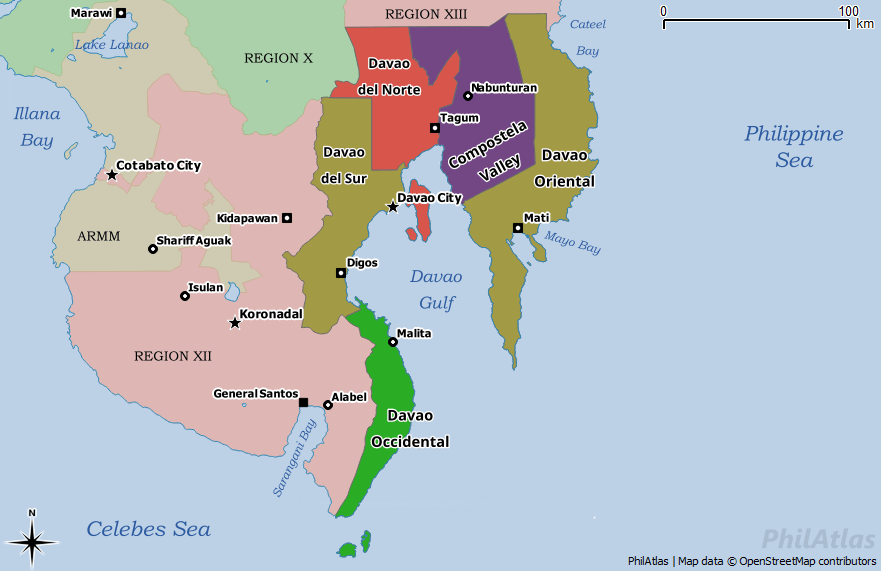
The Heart of Davao: The City of Davao
The City of Davao, also known as the "Crown Jewel of Mindanao," is the center of commerce, education, and tourism in the region. It is home to some of the most iconic landmarks in the country, such as the Philippine Eagle Center, Davao Crocodile Park, and the Durian Dome. Visitors can take a stroll in the sprawling People's Park, enjoy a night out in the bustling Roxas Night Market, or visit the numerous museums and art galleries that showcase the rich cultural heritage of the Davao people.
A Paradise of Islands: The Samal Group of Islands
Just a short boat ride away from Davao City lies the Samal Group of Islands, a pristine paradise of white-sand beaches, crystal-clear waters, and lush tropical foliage. The island is home to some of the most luxurious beach resorts in the country, such as Pearl Farm Beach Resort and Bluejaz Resort. Visitors can indulge in a variety of water sports, including scuba diving, snorkeling, and island hopping, or simply relax and bask in the warm sunshine.
A Hiker's Paradise: The Mt. Apo Natural Park
For outdoor enthusiasts, the Mt. Apo Natural Park is a must-visit destination. Located in Davao del Sur, Mt. Apo is the highest peak in the Philippines and offers breathtaking panoramic views of the surrounding landscapes. Visitors can go on a trek to the summit, passing through scenic forests, gorges, and waterfalls along the way. The park is also home to a diverse array of flora and fauna, including endemic species of birds, mammals, and reptiles.
A Journey to the Past: The Museums and Heritage Sites of Davao
The Davao Region is steeped in a rich cultural heritage, with a diverse mix of indigenous tribes, colonial influences, and contemporary art and music scenes. Visitors can explore the various museums and heritage sites scattered throughout the region, such as the Davao Museum, the Mindanao Folk Arts Museum, and the Kadayawan Village. These sites offer a glimpse into the unique customs, traditions, and beliefs of the Davao people, from their ancient rituals and dances to their modern art and cuisine.
Social Media Platforms
- facebook count=1k; Follow
- youtube count=2.8k; Follow
Like Us on Facebook 👍

Recent Posts
Featured posts, welcome back to the philippines.
your next adventure with Tour Guide Philippines
Are you sick of traveling to the same old places for your vacation? Are you excited to try something new? TourGuidePh.com should be your first and only stop. Our website is committed to providing you with the most recent travel trends, recommendations, and insights in order to assist you in discovering the undiscovered treasures that the Philippines has to offer.
Join us on a journey to discover new destinations, immerse yourself in new cultures, and experience all the Philippines has to offer. From the stunning beaches of Palawan to the rolling hills of Batanes, TourGuidePh.com is your go-to resource for all things travel in the 11 provinces of the Philippines. Our team of expert guides are passionate about showcasing the best that our country has to offer and sharing their local knowledge with our visitors.
Whether you're a seasoned traveler or just starting out, our website offers a wealth of information on the best destinations, culture, and experiences in the Philippines. With our insider knowledge and expert guides, we'll help you plan the trip of a lifetime that perfectly suits your interests and travel style.
Our website is your go-to source for all things travel in the Philippines. We've got the resources and information to help you plan your dream trip. So what are you waiting for? Let's explore the Philippines together! Get inspired for your next adventure today with Tour Guide Philippines.
Top Things to Do in Davao City
Things to do in davao city, explore popular experiences, top attractions in davao city.

Other Top Attractions around Davao City
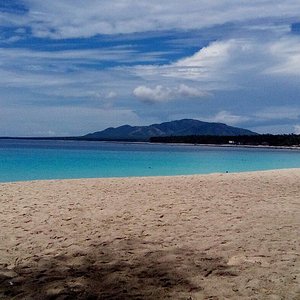
What travelers are saying

- Philippine Eagle Center
- D' Bone Collector Museum
- Ayala Malls Abreeza
- Davao Crocodile Park
- Malagos Garden Resort
- People's Park

Davao Oriental Travel Guide: 3D2N Itinerary [Top Tourist Pots]
![region 11 tourist spots You are currently viewing Davao Oriental Travel Guide: 3D2N Itinerary [Top Tourist Pots]](https://www.escapemanila.com/wp-content/uploads/2022/03/davao-oriental-guide.jpg)
- Post author: Glen Nomad
- Post comments: 2 Comments
- Post last modified: June 12, 2023
It’s been a while since I last visited Davao Oriental. So, when I got an invite from the Department of Tourism Region XI for a Familiarization Tour, I immediately said yes. I wanted to explore the province since it has become a go-to place for people within the region to unwind during the pandemic.
Here’s our 3D2N Davao Oriental itinerary for your reference if you plan to explore the province.
Day 1: From Davao to Governor Generoso
We left Davao City early in the morning around 5:00 AM. There was obviously no traffic yet, so we arrived in Banaybanay just in time for breakfast. We first dropped by at the province’s welcome signage for a quick photo op before heading to Kagan Cafe also in the town of Banaybanay.

At Kagan Cafe, we were served with a sumptuous platter of continental and Filipino breakfast. We enjoyed the meal, had a little chat, get to know each other, and ended up with a quick tour of a nearby mosque.
Mt. Hamiguitan Natural Science Museum
After breakfast, we headed to the town of San Isidro to visit Mt. Hamiguitan Natural Science Museum, an interactive facility that not only showcases the wonders of Mt. Hamiguitan (the only UNESCO inscribed World Heritage Site in Mindanao) but also advocates for people’s participation in the mountain’s conservation efforts by introducing them its rich flora and fauna, and what it means for the humanity.

El Don Beach Resort
We stopped for lunch at El Don Beach Resort, one of the top beach resorts in Governor Generoso. The resort offers a buffet lunch set up featuring local dishes and a variety of desserts.

After filling our tummies, we also had a quick resort tour to see the rooms, the beach, and the resort’s amenities.

Cape San Agustin
Our next stop after lunch was at Cape San Agustin. It is the southernmost part of the town of Governor Generoso in Davao Oriental. It is where the southeasternmost point of the country is situated extending into the vast Celebes Sea on one side and Davao Gulf on the other.

Resort Hopping in Lanca
Our last activity for the day before heading to our accommodation was resort hopping in Lanca. Although part of Mati City, this emerging beach destination in the region is accessible via Governor Generoso.
We visited the newly built South Point Beach Resort, a small resort featuring small but pretty villas that can accommodate up to four people.

Our second stop was at Kojo Beach Resort situated on a long stretch of white sand beach in Lanca. It is one of the top beach resorts in the area offering comfortable room accommodation.

Camp San Bernardino de Lavigan
We capped the night at Camp Bernardino de Lavigan, one of the top beach resorts in Governor Generoso featuring air-conditioned glamping tents and a white sand beach.

Aside from the airconditioned big tents, the resort also offers small non-airconditioned beachfront tents good for two people.

Camp Bernardino de Lavigan is situated about 4-6 hours drive from Davao City.
Day 2: Governor Generoso to Mati City and Caraga
Sleeping dinosaur.
Mati City’s sleeping dinosaur is a popular stopover for visitors and locals bound for the city coming from different parts of the Davao region. The view deck along the road offers a stunning view of a plesiosaur-shaped dinosaur from a distance.

OK Hotel and Resort
Before heading to the city proper, we dropped by at the newly opened OK Hotel and Resort situated along Badas Road, less than 30 minutes away from Mati city proper. It offers affordable rooms with an overlooking view of Pujada Bay.

Lunch at Ciangi
Ciangi is a popular restaurant in Mati City situated near the bay walk area. It offers delectable Filipino comfort food like sisig, adobo, humba, and many others. Its signature dish is bakareta , a kind of beef stew that is also referred to beef caldereta .

Subangan Museum
Dubbed as the largest museum in the Davao Region, Subangan Museum features the rich cultural and natural heritage of the Province of Davao Oriental. The museum houses collections of treasured relics, photos, videos, interactive visuals, documents, fabrics and other products, testaments to the province’s rich culture and history, allowing visitors to experience the natural and cultural wonders of the province.

Dahican Beach
After visiting the Subangan Museum, we went to Dahican Beach, one of the most popular tourist spots in Davao Oriental. It is a stretch of long white sand beach in Mati City facing the Pacific Ocean. It has become famous to both locals and tourists because of its white sand beach and big waves ideal for surfing and skimboarding.

Resort Hopping in Dahican
Our Davao Oriental itinerary includes a visit to numerous accommodation establishments along the coastline of Dahican.
Our resort hopping activity includes a visit to Pacific Breeze Resort, Dahican Cove Beach Resort, Aloha Beach House Mati, Surf’s Up Resort, and Sheepy’s Surfside Beach Resort.

Pusan Point
After Mati, we continued our journey to the town of Caraga. We visited Pusan Point which is considered the easternmost inland point of the Philippines. It is basically the place where the sun first rises in the Philippines. A Jubilee cross was erected right along Pusan Point’s rugged limestone cliffs and an Eco-park and Science Discovery Center can be enjoyed by the tourists.

San Salvador del Mundo Church
Our second stop in Caraga before heading to Baganga was San Salvador del Mundo Church. Itis the only church in the whole Davao Region with a historical marker inscribed by the National Historical Commission of the Philippines. Its construction began in 1877 and was completed in 1884. It is built of wood, corals, and stones. It served as a mission station for Spanish Missionaries in propagating Christianity in Eastern Mindanao.

After a quick visit to Caraga, we finally head to our accommodation for the night in Baganga – MYMS Apartelle. It was already past 7:00 PM when we arrived in town. We immediately checked in and went to Zorbox for our dinner.

Day 3: Exploring Baganga
Playa del rosario.
We started our day with a breakfast at Playa del Rosario located in Brgy. Salingcomot, Baganga. We had their breakfast platter – adobo, daing na bangus, dried danggit, sausages, eggs, and lots of rice to power us up for the day.

@escapemanila Pinoy breakfast platter! Mabubusog ka talaga! ♬ Tchu Tcha Tcha(抖音原版) – 苏瞳
Curtain Falls Eco-Park
After the power breakfast at Playa del Rosario, we visited Campawan Curtain Falls which is considered as Davao Region’s widest waterfalls. It derived its name from the formation of the waterfalls itself. The cool falling waters come from the river above and the large flat rock causes it to flow in a curtain-like pattern. The waterfall from a distance of around 20feet in height and width of around 50 to 60 feet.

San Victor Island
Our next stop in Baganga was at the famous San Victor Island, one of Davao Oriental’s unique landforms facing the Pacific Ocean. It is a 3-hectare island located in Barangay San Victor about 20 minutes from Baganga’s town proper. It is considered as the Island Jewel of Baganga and is on the list of the top must-visit tourist spots of Davao Oriental and the Davao Region.

Our lunch was served at San Victor Island. We feast on mouthwatering seafood and lechon!

Poo Sandbar
The last stop before heading back to Davao City was at Poo Sandbar located in Brgy. Kinablangan, Davao Oriental. It is a community-based eco-tourism site managed by the barangay. We arrived just after the low tide so we weren’t able to see the sandbar. If you are going there, make sure to check the low tide so you can enjoy walking on the sand bar.

So that was our 3D2N Davao Oriental itinerary. We were supposed to drop by at Aliwagwag Falls for a quick photo op but it was already dark when we passed by. Aliwagwag is still undergoing rehabilitation and is closed to tourists.

The Davao Familiarization Tour that I joined was sponsored by DOT XI and hosted by the Provincial Tourism Office of Davao Oriental. Thank you, Kat Anuta and Al Olden of DOT XI and Maribeth Villaceran and Krestta Narciso of the Provincial Tourism Office.
Thank you also to our guide, Olan Emboscado, and to all the tour operators I was with the entire trip – Ms. Cynthia, Monena, Charlie, Ruben, and Rex! To our official photographer, Jett and our drivers Nico and Tatang, thank you! I hope to see you all again!

Glen Nomad is a travel blogger and the founder of Escape Manila, one of the top travel blogs in the Philippines. He has visited all 82 provinces in the Philippines and has explored 53 countries across Asia, North & South America, East Africa, Europe, and Australia. Follow him on IG at @escapemanila

This Post Has 2 Comments
Just be sure to pack all the essentials before you go on your way. After all, with the country’s wealth of beautiful beaches, you definitely have a lot of beach camping options.
does El Don beach resort accepts tent pitching?
Leave a Reply Cancel reply
You must be logged in to post a comment.
- Best Travel Apps
- Bus & Ferry Tickets
- Cheap Flights
Privacy Overview
Davao Region (Region XI)
Davao Region , officially designated as Region XI , is an administrative region in the Philippines occupying the southeastern section of Mindanao . It covers 5 provinces , namely, Davao de Oro (Compostela Valley), Davao del Norte , Davao del Sur , Davao Occidental , and Davao Oriental , as well as 1 highly urbanized city. The regional center is the City of Davao .
Its population as determined by the 2020 Census was 5,243,536. This represented 19.97% of the overall population of the Mindanao island group, or 4.81% of the entire population of the Philippines. Based on these figures, the population density is computed at 257 inhabitants per square kilometer or 665 inhabitants per square mile.
Davao Region is bordered, clockwise from the North, by Caraga , the Philippine Sea, Davao Gulf, Celebes Sea, SOCCSKSARGEN , and Northern Mindanao .
Local government units
Davao Region has 5 provinces , 43 municipalities , and 6 cities (1 of which is a highly urbanized city administered independently from any province). The total number of barangays in the region is 1,162.
Demographics
Population by age group.
According to the 2015 Census, the age group with the highest population in Davao Region is 5 to 9 , with 535,293 individuals. Conversely, the age group with the lowest population is 80 and over , with 32,003 individuals.
Historical population
The population of Davao Region grew from 65,463 in 1903 to 5,243,536 in 2020, an increase of 5,178,073 people over the course of 117 years. The latest census figures in 2020 denote a positive growth rate of 1.47%, or an increase of 350,218 people, from the previous population of 4,893,318 in 2015.
The total number of registered voters or electorate in Davao Region for the year 2019 was 3,026,393.
- Unless otherwise specified, population count (excluding percentages) and land area figures are derived from the Philippine Statistics Authority.
- Data on registered voters is from the Commission on Elections.
- Maps utilize OpenStreetMap data available under the Open Data Commons Open Database License .

- Region 11 (Davao Region)

Davao Region has six (6) cities, namely:
1. Panabo City
2. Samal City
3. Tagum City
4. Davao City
5. Digos City
6. Mati City

Showcasing the Best of Off-Beaten Destinations
- Abra Province Tourist Spots
- Baguio City
- Mountain Province
- REGION I-ILOCOS REGION
- REGION II- CAGAYAN VALLEY
- REGION III – CENTRAL LUZON
- REGION IVA-CALABARZON
- REGION IVB – MIMAROPA
- REGION V – BICOL REGION
- REGION VI – WESTERN VISAYAS
- REGION VII – CENTRAL VISAYAS
- REGION VIII – EASTERN VISAYAS
- REGION IX – ZAMBOANGA PENINSULA
- REGION X – NORTHERN MINDANAO
- REGION XI- Davao Region
- REGION XIII-CARAGA
- Region XII-SOCCSKSARGEN
- BARMM – Bangsamoro
- Work with Me
- Blogging Resources
- Travel Musings

Davao Travel Guide: Top 20 Best Davao Tourist Spots & Things to Do
What are the best Davao tourist spots to visit, aside from the famous Samal Island? Find out more in this article.
Davao City is one of the few places in the Philippines which offer a mix of natural, historical, and cultural attractions. In just a day, you’ll discover a lot of interesting sights here and learn much about its rich culture and history.
Dubbed as the Queen City of the South, Davao City surely beams for its famous Durian or as a home to the Philippine Monkey-Eating Eagle. There are also tons of unusual and fun-filled activities to do here.
Without further ado, here are some of the tourist spots in Davao City. Take note. Most of the attractions included in this article relate to environmental preservation and cultural promotion. Some of which, are off-beaten destinations.
Here we go.
1. Philippine Eagle Centre

If you are looking for a rustic experience near the city center, this is the perfect place for you.
The center provides a safe refuge for the country’s national bird, the Philippine Monkey-Eating Eagle. It is a critically endangered species with less than 400 pairs left in the wild.
The sanctuary has around 36 eagles, 10 other bird species, 4 species of mammals, and 2 reptile species including huge snakes.
When you visit here, you’ll not only appreciate nature and its wildlife. You also contribute to the saving of the Philippine Eagles. Every penny you give helps in the protection and conservation of these rare and endangered birds.
The entrance fee here is Php 250. You can add more if you want to help fund the conservation of these majestic eagles.
The center is one of the top tourist spots in Davao City.
2. Roxas Avenue Night Market

Come and experience various culinary specialties of Davao here at the Roxas Night Market. If you’re looking for budget-friendly clothes or souvenir items, don’t worry. You can find them all right here.
Stroll along with the market and prepare to savor fresh and cooked seafood such as tuna and squids. Experience fresh Durian treats or you can try Durian shakes at a relatively cheaper price.
If you like something different, they have charcoal ice cream and different butchi flavors.
The market opens at 6 am and ends at midnight.
If you are fond of local cuisine, this is among where to eat in Davao.
3. Samal Island
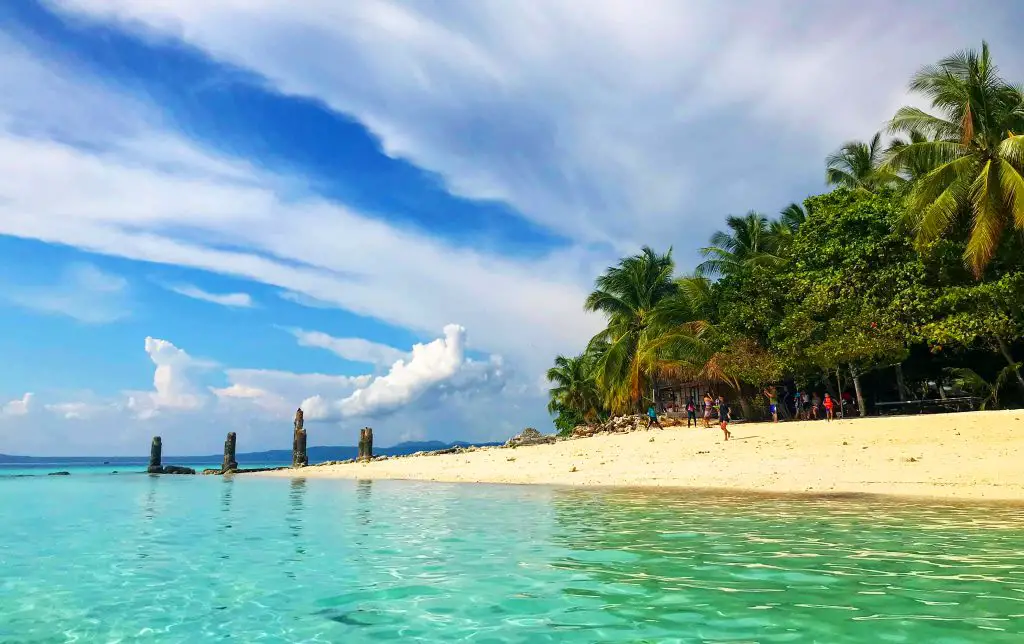
This one piece of tropical paradise is just a 15-minute of boat ride away from Davao City. Enjoy a ride around the island and drop by one of the numerous white, pristine beaches.
As you gaze at the crystal-clear blue waters, you can’t help but take a plunge and enjoy a refreshing swim.
There is a cave on the island where you can find millions of bats. Thankfully, these are protected and allow the local community to earn through ecotourism.
The island is also home to the biggest clams in the world. These are grown in a nursery, helping boost the conservation of these endangered species.
The island is one of the most beautiful Davao tourist spots.
4. Crocodile Park

Davao City may not only be the Durian Capital of the Philippines. It is also the land of crocodiles. Located just within the city proper, the Crocodile Park hosts thousands of crocodiles, both saltwater and freshwater species.
These crocodiles are bred and born on site. There is an incubator room where you’ll find hundreds of crocodile eggs and hatchlings. You’ll walk along the life cycle of a crocodile while you are here.
Visiting this park will also give you the realization that crocodiles are creatures to appreciate, instead of to fear.
Aside from the crocodiles, the park also homes different wildlife species such as monkeys, snakes, birds, and other reptile species. This is a great spot to visit if you want to learn about the importance of conserving wildlife.
The park sits near the Riverfront Hotel along the Corporate City Diversion Highway in Ma-a, Davao City. It is included in the Davao tour packages.
5. People’s Park Davao City
If you are looking to commune with nature, you don’t have to go far. Within the city proper, the People’s Park gives you that feeling like you are in the wilderness.
Established in 2007, the park covers 4 acres and contains a beautiful rainforest, man-made pools, cascading waterfalls, and some of the Philippine Monkey-Eating Eagles.
Feeding the pigeons is another adorable activity you can do here. You can also jog around the colorfully-paved paths, or join a public Zumba class every Sunday at 6 am.
There is just nothing like it when nature gives you a space to breathe and relax amidst a sprawling urban metropolis.
6. Magsaysay Fruit Stand
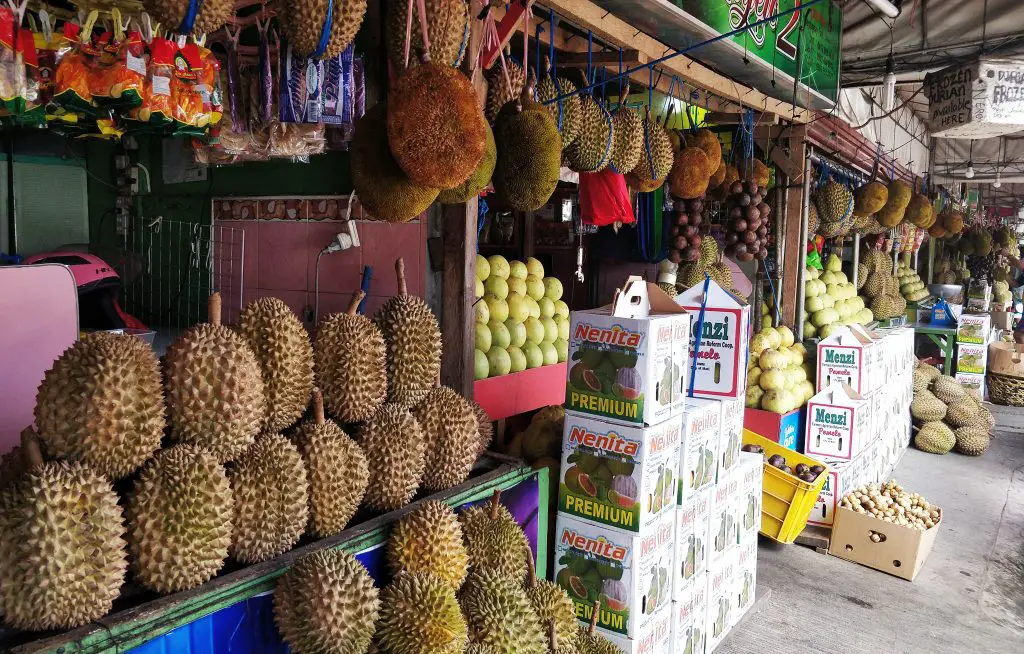
Just along a local highway, this is one of the best sites to buy the famous fruits of Davao City such as Durian, mangosteen, marang, and rambutan. You’ll have dizzying options but the good thing, is you can be sure that the fruits are of good and fresh quality.
Different fruits treat such as candies, jams, and crackers are also available here.
If you feel hungry after haggling across the stalls, there is the nearby Fishcado, an open-air seafood resto that offers various seafood specialties. Don’t forget to try the famous tuna here.
During the late afternoon, more and more food stalls and snack carts open and come streaming in, creating a paradise of street foods. You’ll surely feel like you are in Bangkok.
7. Jack’s Ridge
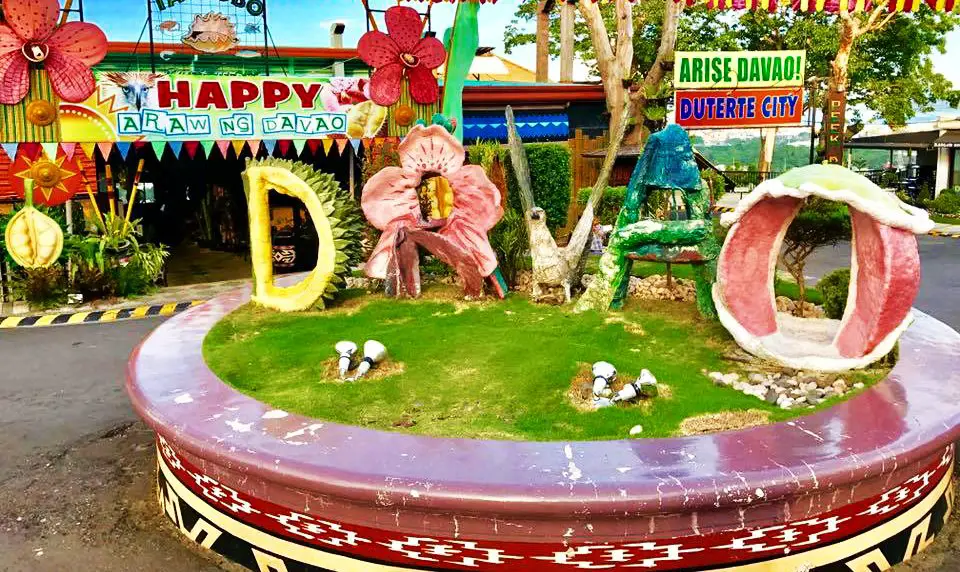
Coming here would give you a full bird’s eye view of Davao City, both during the night and day. It’s a great place to unwind and relax because of the abundance of trees and flowers. The landscapes here are also a sight to see.
Aside from the views, you can dine in two restaurants here. The first is Karlo’s Gourmet which serves brewed coffee and baked delicacies. The other option is Taklobo which offers an open-air dining area where you can immerse in sumptuous Filipino meals.
Also, you can spend an overnight in one of the cottages next to a pool. Catch sight of a beautiful sunrise the following morning.
Jack’s Ridge has also historical tales to tell. During World War II, the retreating Japanese used it as a headquarter because of its strategic location.
You can read about all these at Jack Ridge’s Monument. The ridge is one of the famous tourist spots in Davao City.
8. Davao City Butterfly House
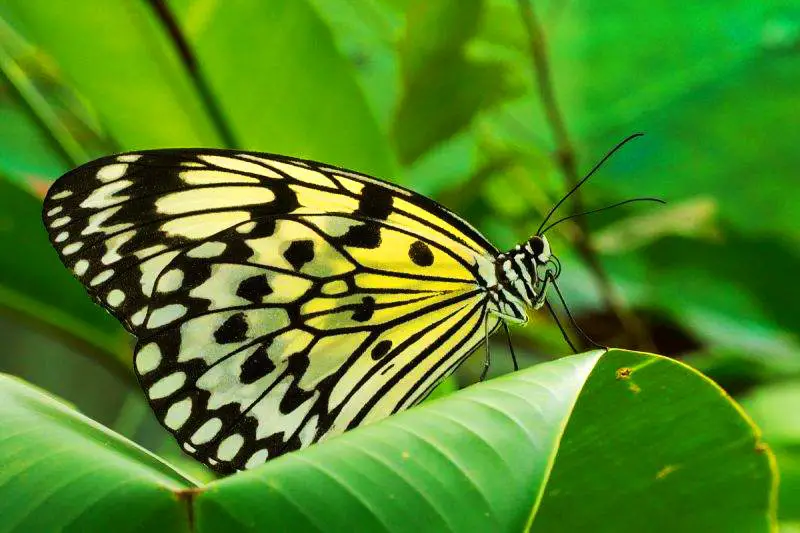
Just like the Philippine Eagle Center, this is also a sanctuary within the city. It serves as a refuge for various species of butterflies, plants, and ornamentals, including exotic animal and insect species such as fish, birds, scorpions, and a lot more.
Experience trailing along with towering trees, relaxing grass, and colorful flowers as you tour around the sanctuary.
It is best to come here during the morning because the butterflies are most active during this time of the day. You can find their dating, mating, and dancing. You’ll surely catch a lot of photographic memories.
9. Davao Museum
If you love to learn about local culture and history, then do visit the Davao Museum. Here, you’ll find an extensive collection of artwork and memorabilia, showcasing the culture of the different indigenous peoples (IPs) of Mindanao such as the Manobo tribes. As you tour around, the more you’ll get into a fascination with such varied and beautiful cultures.
The museum also contains historical maps of Mindanao, centuries-old artifacts, modern paintings, and hand-carved artifacts. Each of these has an interesting story to tell. So don’t forget to ask your guide for stories.
Photography is prohibited here. The showcased materials are merely for your eyes only. Do respect that.
By the way, the museum is included in the Davao city tour package.
10. Mt. Apo

The King of the Philippine Mountains, Mt. Apo rises to more than 3,144 meters above sea level, making it the highest in the country. It is a premium mountaineering destination, attracting hundreds of both local and foreign hikers.
The number of hikers is limited to protect the mountain and the tours are organized to ensure compliance and safety.
Near the peak of the mountain, there is a 500-meter-wide crater lake where you can rest for a while or even camp as you enjoy the serene environment. For the Manobo tribes, the mountain is sacred. They believe that it is where one of the local gods resides.
To get to Mt. Apo’s summit, you’ll need to hike for hours/days along with grasslands, dipterocarp forests, and mossy forests.
While atop, you can catch a breathtaking view of the lowland farms, cities, towns, and other towering peaks of Mindanao. You’re even luckier if you chance on a stunning sea of cloud formations.
The mountain is also a haven for the critically-endangered Philippine monkey-eating eagle and numerous other species. Tracks of wild deer and boar can also be seen.
11. Tudaya Falls
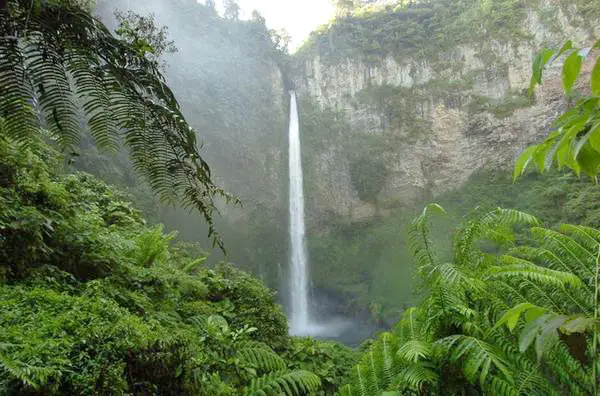
Tudaya falls ranks as one of the highest falls in Davao, measuring more than 100 meters high. It drops like a bridal veil on the face of a massive cliff towards a beautiful pool. It is also one of the most popular in Mindanao and is frequented by both local and foreign hikers.
It may take hours of a hike along jungle trails to reach Tudaya falls. But the reward you get is superb. The trail itself communes you with nature and you’ll feel refreshed and invigorated. If you’re lucky, you’ll catch sight of endemic flora and fauna such as different species of birds and beautiful orchids and flowers.
Once you reach the falls, you can’t help but take a plunge in the crystal-clear waters. There’s more. The waters emanate from mossy forests upstream and it’s refreshingly cold!
If you’re not into swimming, you can just gaze at the falls, meditate, and feel your worries away with the caressing mists.
12. Eden Nature Park
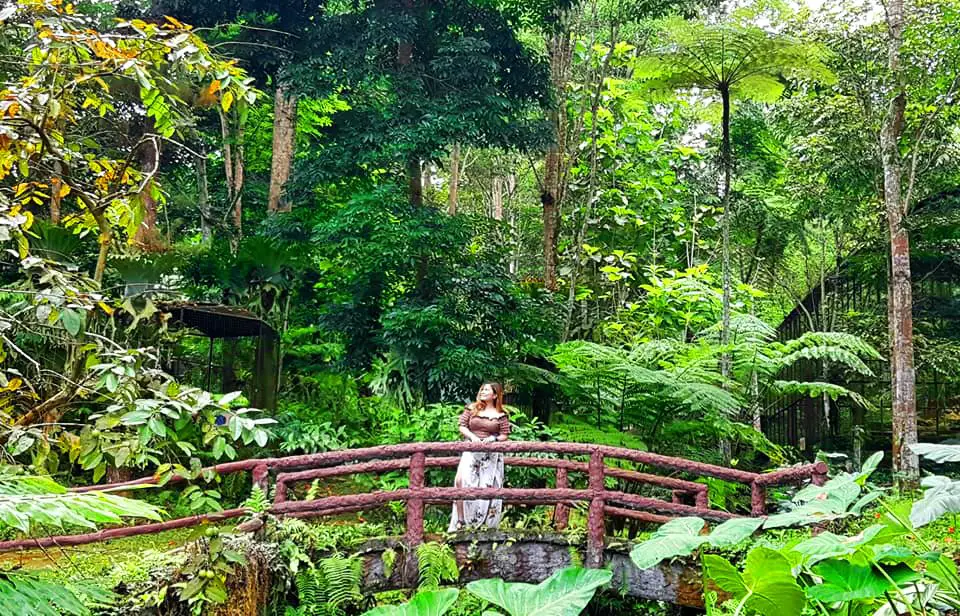
When planning your Davao city tour itinerary, don’t forget Eden Nature Park.
Nestled at the foot of majestic Mt. Talomo, Eden Nature Park is a man-made park covering 80 hectares. It features thousands of forest trees and pine trees, most of which are introduced species to the area. You can also spot exotic wildlife species such as birds, flowers, and numerous kinds of insects.
This is a perfect getaway if you’re looking for a nature immersion without the need for extensive hiking. You’re on a relaxed pace here. Stroll around and smell the pine-scented breeze, giving you a mystifying and healing experience.
The park also offers a 45-minute shuttle tour to some of its best spots.
13. Museo Dabawenyo
Just like the Davao Museum, Museo Dabawenyo showcases the rich culture and history of the locals of Davao and neighboring provinces. Here, you can find various artworks, informational monuments, and historic photos.
The Museo Dabawenyo also contains four major galleries.
· Indigenous People’s Gallery – houses various materials of the different Lumad tribes such as native house replicas, bamboo and bronze instruments, and native-style weapons
· Contemporary Gallery – showcases traditional Filipino fashion, mostly leased with a cultural touch
· Memorabilia Gallery – presents Filipino old bills, musical notes, and clothes
· Moro People’s Gallery – displays the antiques of the Muslim people such as lamps, chairs, armors, and royal crowns
14. Mt. Talomo

Mt. Talomo stands adjacent to Mt. Apo. It also ranks as one of the top ten highest peaks in the Philippines. Many hikers take the Mt. Talomo to Mt. Apo traverse route to experience a more extreme adventure.
This traverse is one of the most difficult in the Philippines and would take days to complete.
Just like Mt. Apo, Mt. Talomo is rich in biodiversity, although many species are threatened with extinction. Much of the lower patches of the mountain have already been cleared for agriculture and logging.
There is then the need to set up and enforce conservation measures to protect Mt. Talomo.
Mt. Talomo also features beautiful mossy forests, huge dipterocarp trees, and views of stunning sunrise and sea of cloud formations.
Along the lower slopes of Mt. Talomo, one can find cascading waterfalls with pristine waters. This is one of the most pristine tourist spots in Davao City.
15. D’Bone Collector Museum
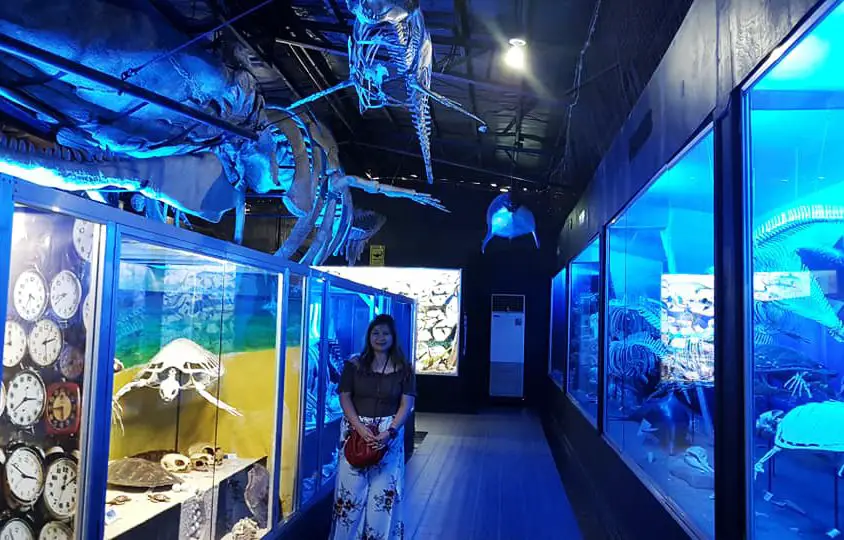
There is such a museum in Davao City!
It has an extensive collection of skeletal bones from various animal species. The highlight of which, is the skeleton of a 41-feet Sperm Whale, an endangered species.
The bones represent species from different stages and in varied environments.
An American missionary established the museum in 2012. Every year, the collection grows. That means you’ll discover and learn something new every time you visit.
So don’t hesitate to ask questions from the curator and listen intently to his/her stories.
16. Philippine-Japanese Historical Museum
Davao City served as a strategic base for the Japanese during World War II. The museum, therefore, chronicles the different happenings during this period. Here, you will find a camera, beddings, trinkets, and many other materials the Japanese used during the war.
There are also retrieved relics such as guns, ammunition, and army clothing. You’ll also see replicas of the living quarters of the Japanese during the war and until the time, they worked on abaca plantations.
This is a must-see Davao City attraction if you want to learn more about the Japanese’ conquest and retreat. It is one of the historical tourist spots in Davao City.
17. Malagos Garden Resort
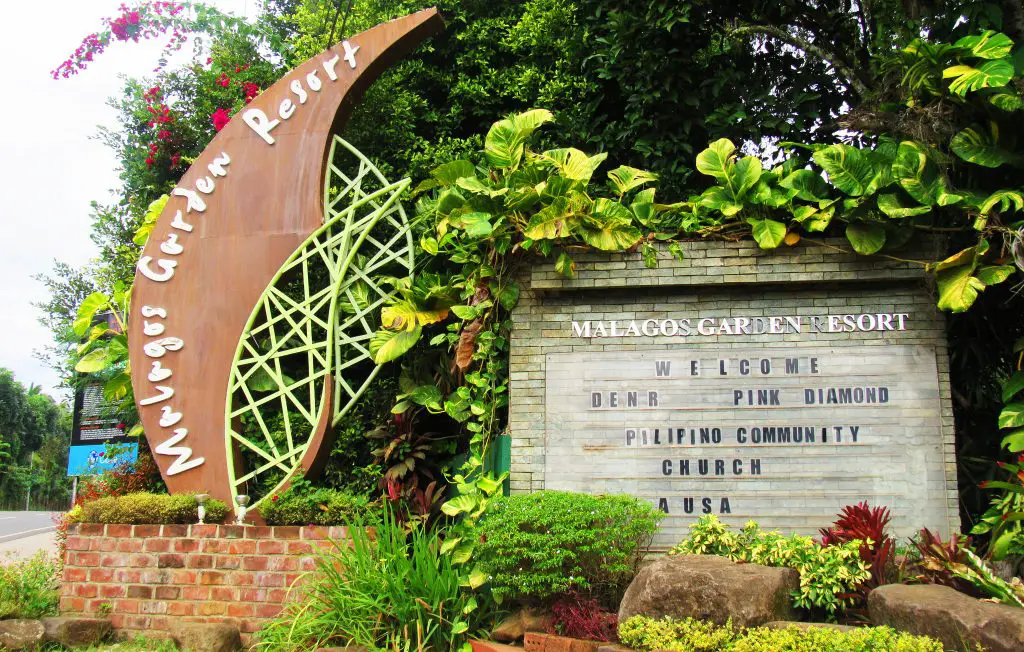
This is one of the most visited tourist spots in Davao City.
The resort covers around 12 hectares and provides a perfect respite away from the hustle and bustle of city life. Experience magical moments with nature here especially during the early morning when the mists waft around. The sunrise view is also spectacular. Stroll around and catch sight of beautiful flowers and refreshing trees.
To get here, you need to take 30-45 minutes of ride from the city proper. It is around 32 kilometers away from the Davao International Airport. Getting here is easy and you can just ask around for directions.
You may also access their website to know more about arrangements and other basic information.
18. Japanese Tunnel

Carved along the slopes of Matina Balusong, this tunnel was built by Prisoners of War during World War II. It served as a hide-out and escape route for the Japanese. They also used this to transport military supplies while mobilizing their forces against the invading American forces.
You may feel a bit eerie coming here given the casualties and brutalities. But, you’ll learn a lot about history as well as important lessons about wars. Therefore, if you are historical savvy, this should make up for your Davao tourist spots itinerary.
19. Blue Post’s Boiling Crab and Seafood
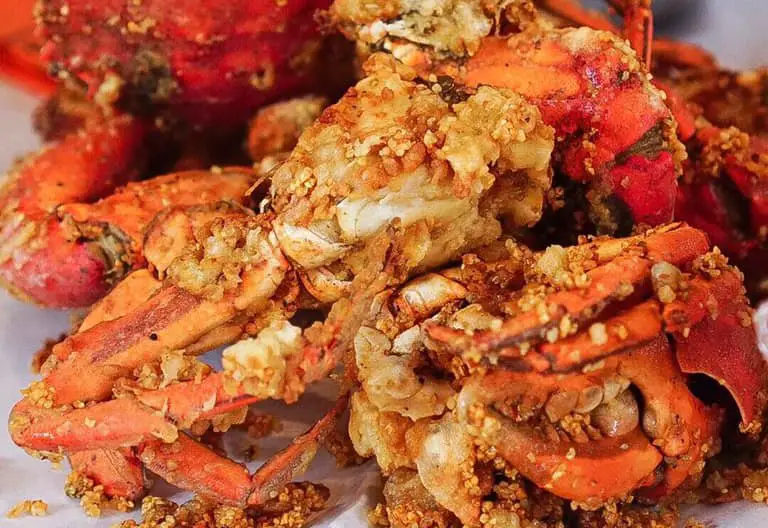
If you want to experience seafood royalty, then do visit this favorite seafood spot in Davao City. But be prepared to get messy and make your hands dirty.
Here, you eat with your bare hands like you are in a boodle fight. You have a wide range of seafood options to choose from – tuna belly and muscles, crab, clams, and many more.
These are placed in a large plastic bag filled with mouthwatering sauces and hunks of corn. Once you hit your order, these are then laid out on your table, ready for a sumptuous feast.
You’ll miss a lot from your Davao tour if you don’t try this seafood hub. After all, it is one of the premium culinary tourist spots in Davao City.
20. Sicao Falls
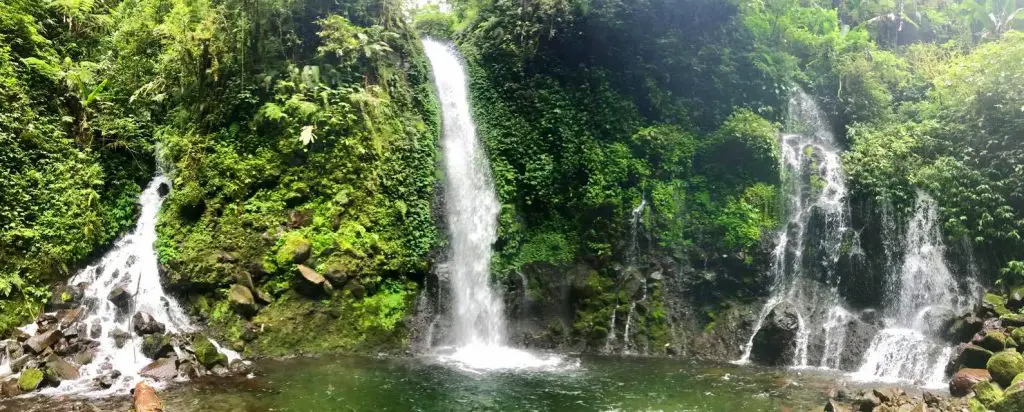
Davao City is home to numerous waterfalls. Some are just around the corners while a lot remains hidden on pristine sites. One of these is Sicao Falls, named after a local Lumad datu (chieftain).
To get here, one needs to hike for 4-5 hours from Purok 6, Tamayong which is the nearest jump-off point. There is a designated camping site where hikers usually stay before chasing the falls the following morning.
Along the trail, nature’s surprises wait. Just make sure you get your eyes or camera-ready, otherwise, you’ll miss some natural shows.
But no worries, the grandeur and sheer beauty of the waterfall are enough to make your long trek exceedingly worth it!
Sicao Falls is one of the most challenging tourist spots in Davao City.
Share this:
Leave a comment cancel.
Your email address will not be published. Required fields are marked *
Email Address *
Save my name, email, and website in this browser for the next time I comment.
Hi there fellow traveler! My name is Daniel although you can call me Kumafor. That's my indigenous name. I grew on a remote village called Lias in Barlig, Mountain Province.
Check Out our Latest Posts
- Top 18 Romblon Tourist Spots including natural attractions
- Top 14 Siquijor Tourist Spots: Island of Enchantment
- 19 Top Cebu Tourist Spots and Best Things to Do
- Top 20 Siargao Tourist Spots: Home of Waves and Beaches
- Best 22 Bohol Tourist Spots including the Things to do
Philippines tourist destination
Philippines tourist destination for all tourist attraction and festival in the Philippines, The Fabulous Tourist, Sightseeing Spots, Historical Sites & Sights
Wednesday, September 29, 2010
- Region 11 - Southern Mindanao
0 comments:
Post a comment.
- Comments RSS
http://philippinestouristdestination.blogspot.com/
- Adventure (2)
- Attraction (17)
- Beach Resort (21)
- Dive Spot (4)
- Festival (10)
- Historical Places (2)
- Mindanao (8)
- Samal Island (6)
Blog Archive
- ► November (2)
- ► October (48)
- The majestic Mt. Matutum
- Durian Garden
- My Polomolok
- Mindanao falls
- The Summer Capital of South Central Mindanao"
- Mindanao mini Boracay
- Autonomous Region in Muslim Mindanao
- Region XIII- CARAGA
- Region 12 - Central Mindanao
- Region X Mindanao
- REGION IX : WESTERN MINDANAO
- Philippines
- Mindanao Regions

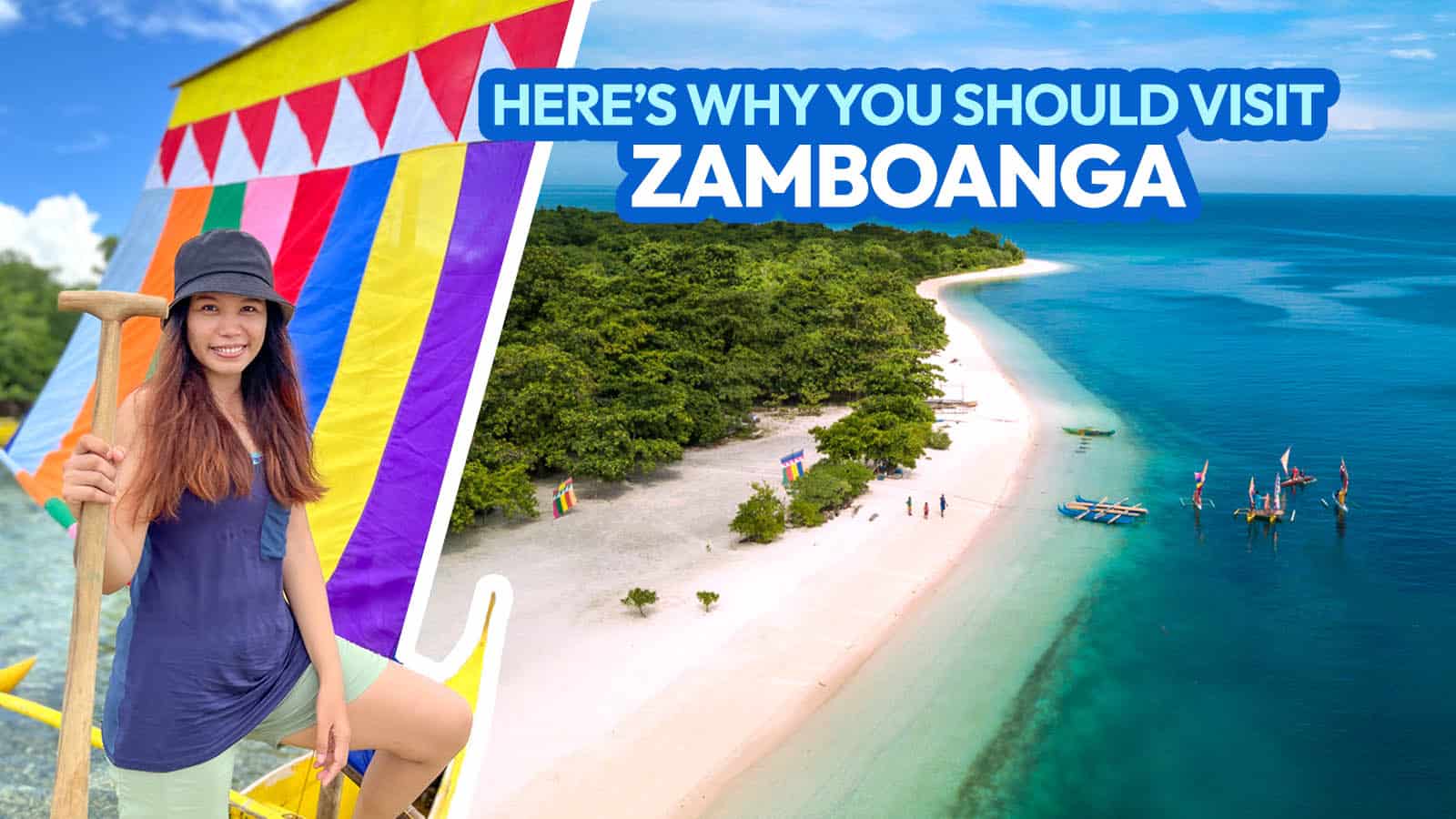
25 ZAMBOANGA CITY Tourist Spots & Things to Do

Whenever we’re asked what our favorite local destinations are, we always include Zamboanga City in the list. And almost always, we get a one-word follow-up question delivered with a lot of curiosity — “Why?”
In my circle of friends, I can count with my fingers those who have set foot in this corner of Mindanao. But what’s in Zamboanga? Why should you visit? As one of the biggest urban hubs in the Philippines in terms of land area (and population), Zamboanga City is brimming with attractions that are worth going the distance.
Zamboanga City’s travel scene has been developing fast over the past few years. It is, after all, Region IX’s primary gateway. Tours are becoming more organized. Promotion of the city has been relentless, especially after travel restrictions have eased. Most tourists flock to the islands and the beaches, but the local food scene is steadily drawing in more visitors, too.
The team has been to Asia’s Latin City five times already, but each time we felt like there was still more to see and discover! On our most recent trip, AirAsia , which now flies daily to Zamboanga, toured us around the city and we got to visit some attractions for the first time!
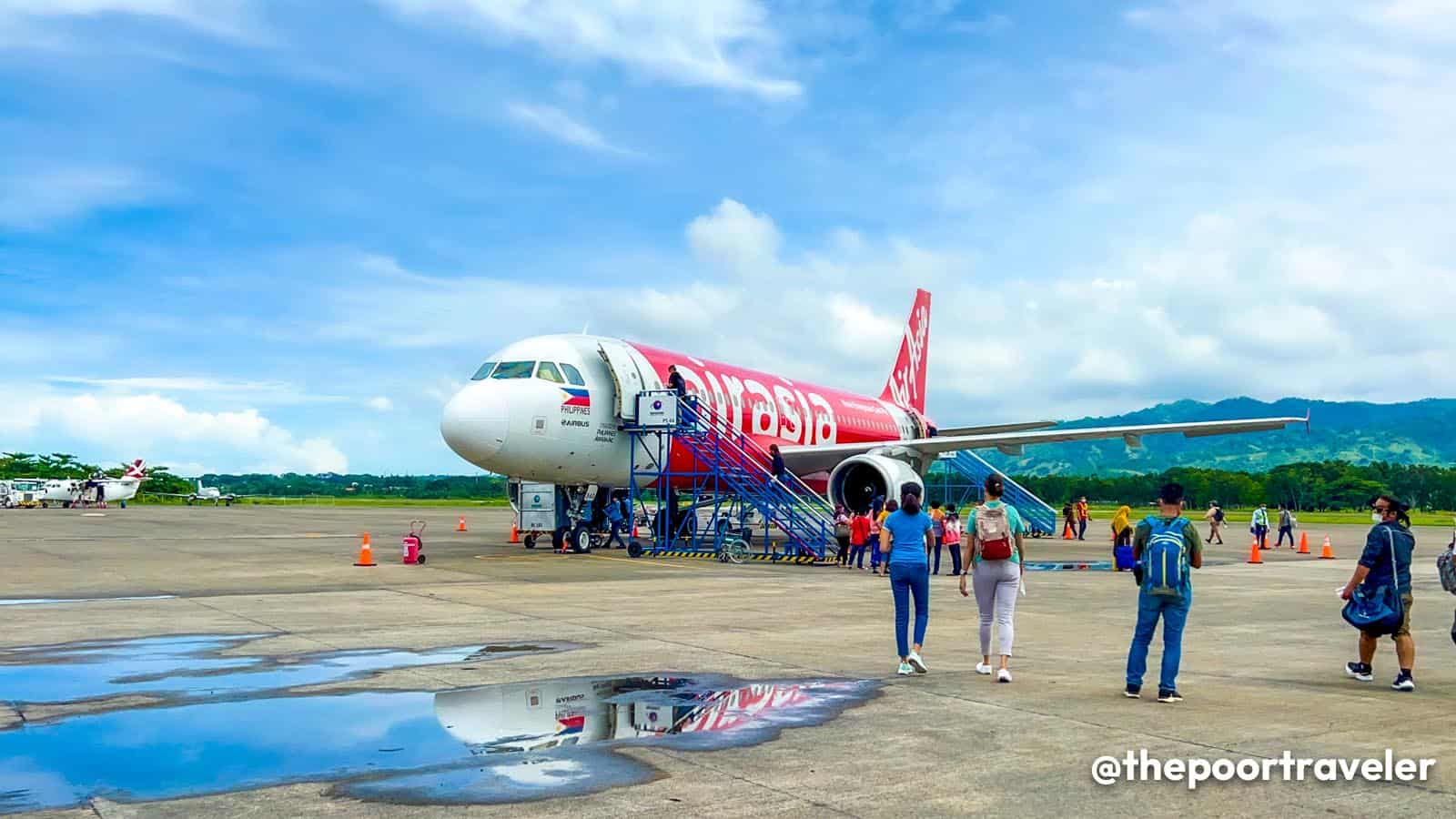
If you’re curious about what awaits you there, here’s a full rundown of the things to do and places to visit in Zamboanga City.
WHAT'S COVERED IN THIS GUIDE?
SANTA CRUZ ISLANDS
Pink beach (sta. cruz grande island).
Off the coast of Zamboanga Peninsula lies an island that, when kissed by the sun, glows with a natural rosy blush. Hailed by the National Geographic as one of the World’s 21 Best Beaches in 2017, Pink Beach is Zamboanga City’s most popular tourist attraction.
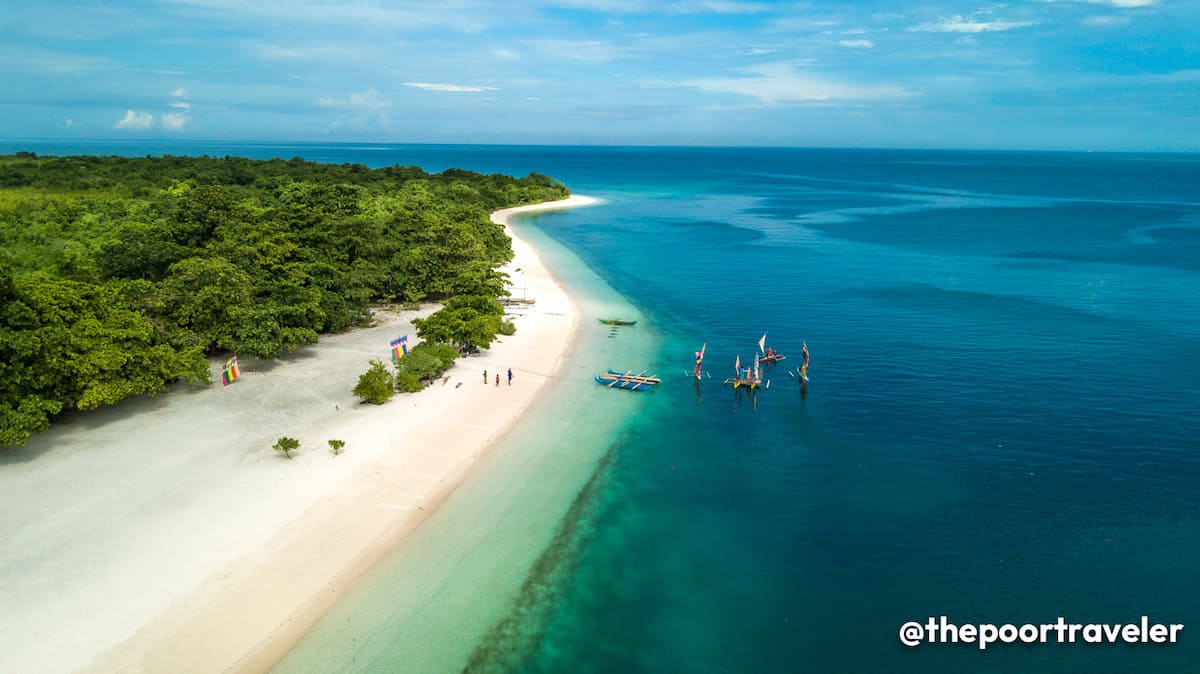
To manage your expectations, the pink hue isn’t vivid or bright. From afar, the sandy shore looks like the usual white beach, but the closer you get, the pink taint becomes more apparent. The sand’s pale pink tint is the result of the weathering of the red organ-pipe corals (tubipora musica) that were brought to the shore by the waves.
Punctuating the southeastern side of the peninsula, Zamboanga City’s Paseo del Mar is the main jump-off point to the island and its Pink Beach. Visitors can hire a tricycle from the city center to Santa Cruz Island Ferry Terminal in Paseo del Mar. The boat ride takes about 20 minutes.
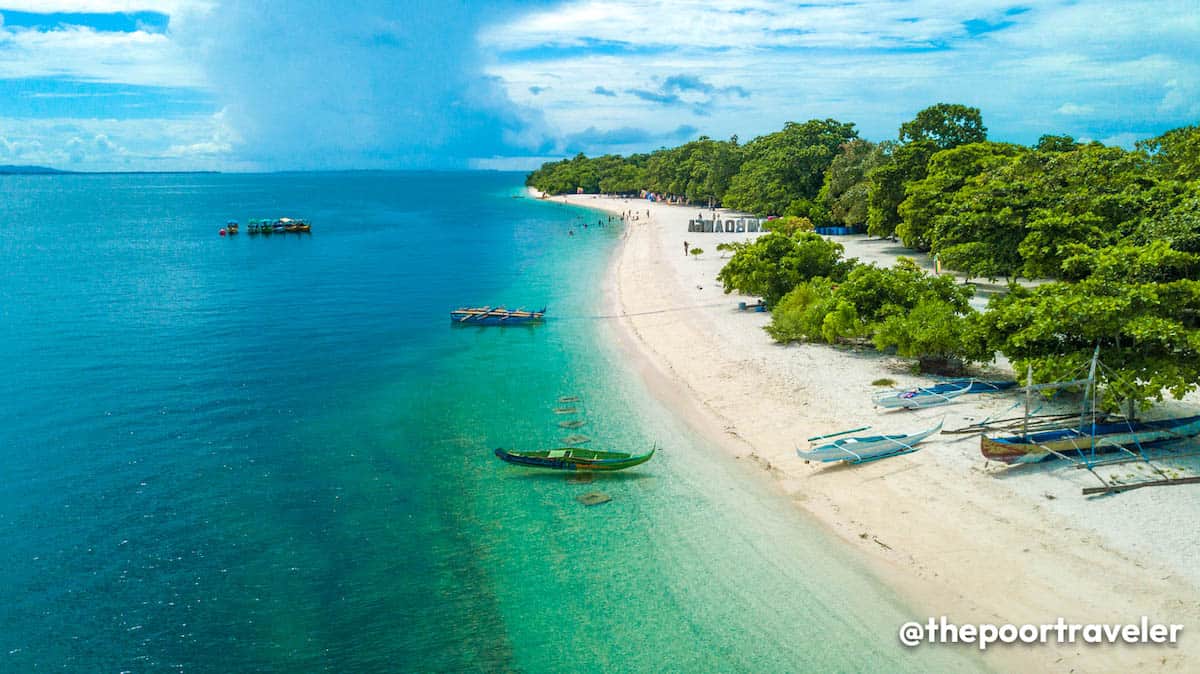
Because the number of visitors is strictly regulated, you need to register in advance before going. Registration and boat service start at 7:00 AM. Overnight stay is not permitted and only day tours are allowed.
Boat fee is P1000, good for up to 10 passengers. If your group is smaller, you’ll still need to pay the same amount.
Jump-off Point: Paseo del Mar (Santa Cruz Island Ferry Terminal) Day Tour Schedule: 7:00 AM – 2:00 PM (Tuesday-Thursday, Saturday – Sunday); CLOSED (Mondays & Fridays). Note that the schedule might change without prior notice, so check first before going. Entrance Fee: P20 + P5 (Terminal Fee) Boat Fee: P1000 (good for up to 10 pax) Cottage Rental Fee: P100 – P500 (depending on the size)
Mangroves Boat Tour (Sta. Cruz Grande Island)
While Grande Santa Cruz Island allures with its pink radiance, its beauty goes beyond appearances. It also keeps a trove of natural wonders. On the other side of the island is a lagoon fully adorned with mangroves, nourishing wildlife and promoting biodiversity.
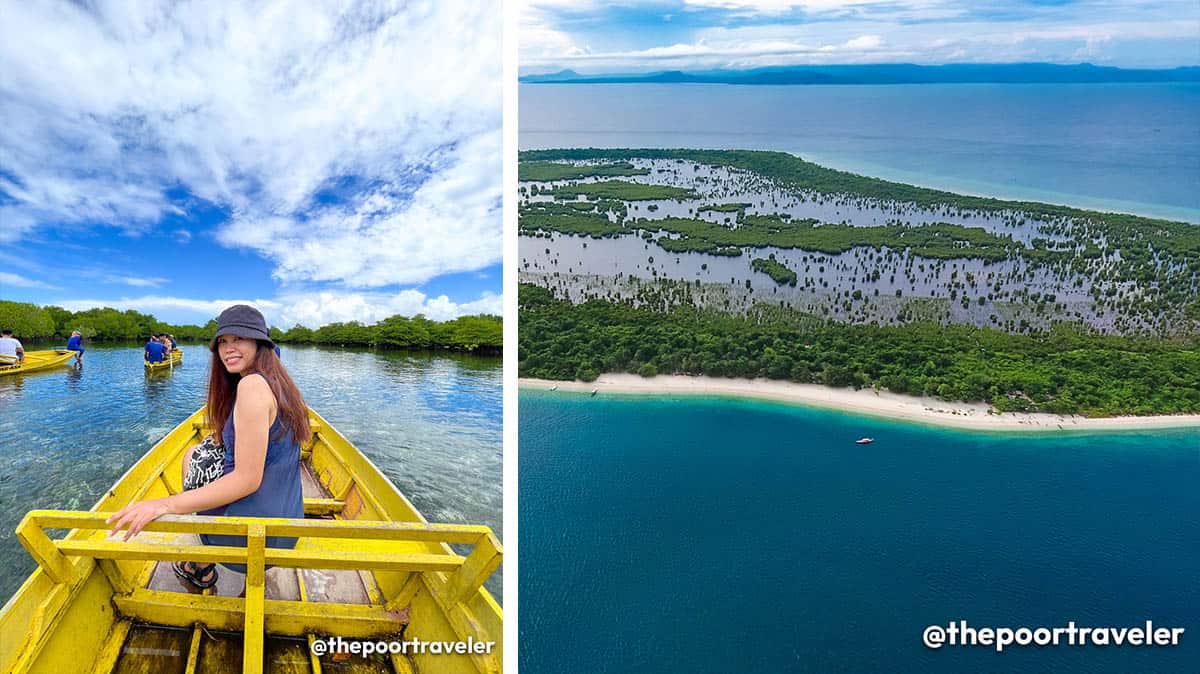
The lagoon actually dominates the whole island, occupying most of the surface. The best way to explore it is to take a guided boat tour. As your boatman paddles, a guide will lead you to a number of spots to explain just how important it is to protect this site. You’ll learn about the types of mangroves and meet upside-down jellyfish . Don’t worry, they’re not dangerous at all. They’re virtually stingless. But please don’t get them out of the water.
To join a lagoon boat tour, tell the boatmen that brought you to Pink Beach that you want to explore the lagoon. They will take you to a small community near the entrance to the lagoon. This transfer will cost you an additional P200.
Here, you’ll be transferring to a smaller “yellow boat.” Rental of each yellow boat costs P300, good for 2 passengers. Any given boat will be accompanied by 2 paddlers, each from a different family. (It’s a way of making sure everyone in the community benefits from the program.)
Tour guide fee is P300. A tour guide can lead up to 5 boats max. You can team up with other boats so you could split the guide fee.
Important: you can only arrange a tour before 12 noon! They won’t be accepting any booking beyond that time. Please follow the rules and regulations when exploring. The Grande Santa Cruz Island, together with the smaller Little Santa Cruz Island, is a protected area.
Here’s a summary of the lagoon tour expense.
Boat to entrance: P200 (boat can accommodate up to 10 pax) Yellow paddle boat rental: P300 (good for 2 pax) Tour guide fee: P300 (good for up to 5 boats)
Vinta Rowing
The vinta is the traditional outrigger boat that is common in Mindanao, especially in the areas of southern Mindanao, Sulu archipelago, and the Zamboanga peninsula. It is famous for its vividly colorful rhombic sail, adding a splash of color to the waters of Sulu Sea.
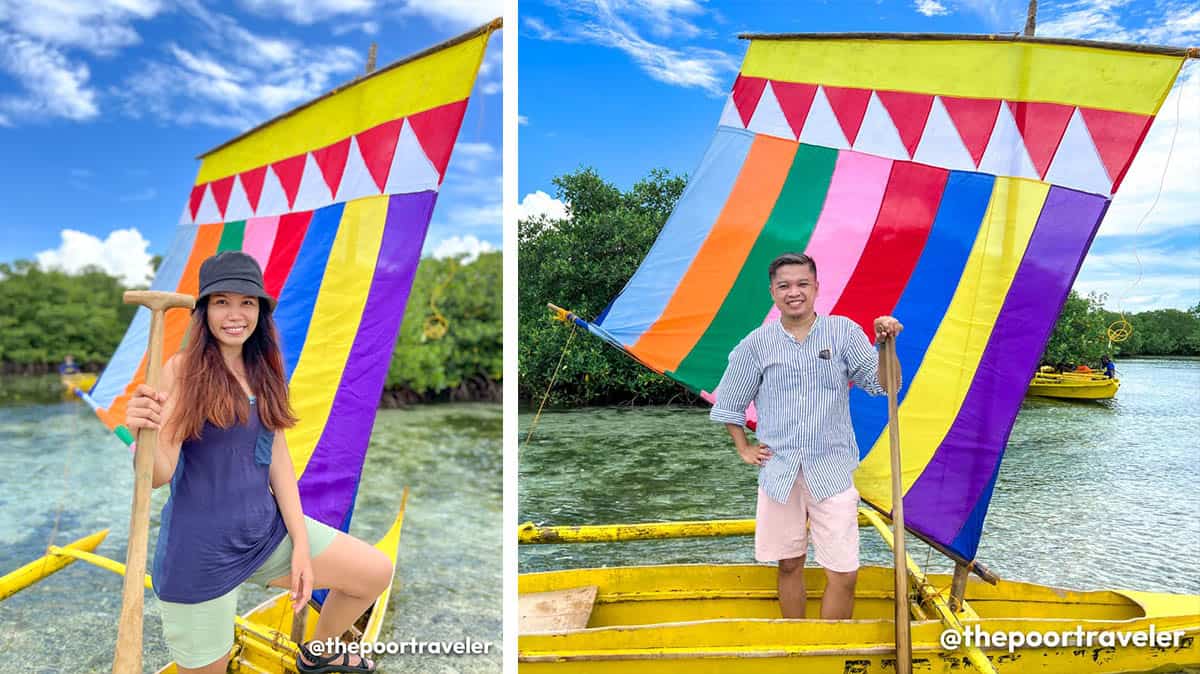
The vinta plays an important role in the livelihood of the locals — economy, trade, and transportation. It is historically used as a fishing vessel. Today, it also serves as a mode of transportation for people, as a cargo vessel to deliver products/goods, and as a tourist attraction.
If you want to experience rowing or riding a vinta , you may charter one in any of the barangays along the city’s coastlines or you can do it when you visit Grande Santa Cruz Island.
Little Sta Cruz Island & Sandbar
Sitting northwest of Santa Cruz Grande Island, Little Santa Cruz Island is like a quick dash of paradise off the coast of the Zamboanga peninsula. The most recognizable feature of the island is the sandbar trailing on the easternmost point.
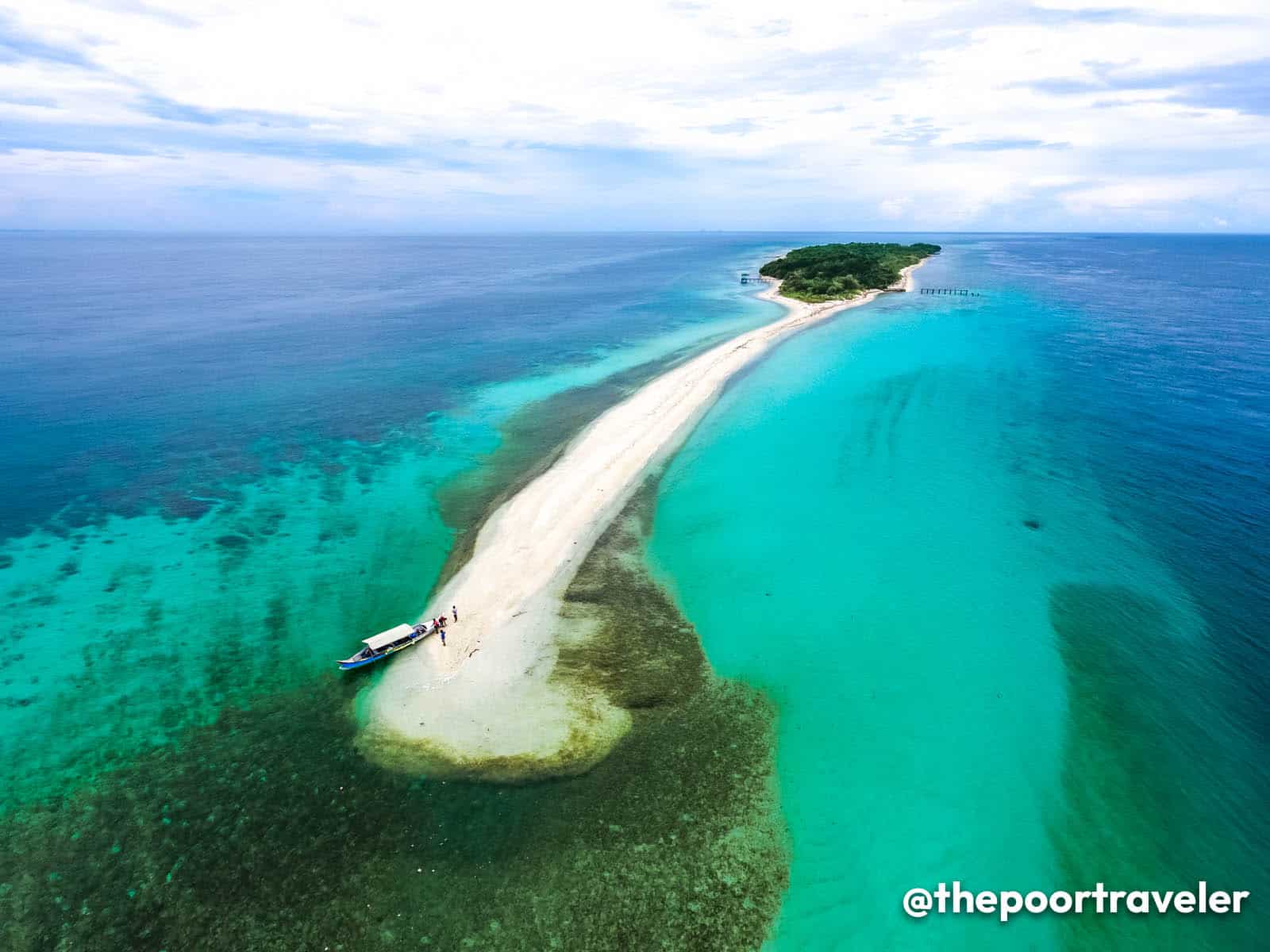
Although the island is fringed with fair sand, it is a mixture of fine and broken shells and corals. There are small lagoons, but tourists are not allowed to venture beyond sandbar. The surrounding waters are mostly deep, sea-grass-covered, and are not recommended for leisure swimming.
Visitors are only allowed to stay here for 10 minutes. But if you really want to make a stop here, a detour will cost you an additional P200.
Jump-off Point: Paseo del Mar (Santa Cruz Island Ferry Terminal) Additional fee if making a stop here: P200
ONCE ISLAS CRUISE (11 Islands)
A steadily rising tourist attraction is Once Islas (11 Islands), a string of islands and islets off the eastern coast of Zamboanga City. Not all islands are open to the public, but those that are accessible are great for swimming, sunbathing, and further exploring. There are designated snorkeling spots for those who want to take a peek into the underwater scene. Buh-Buh, Bisaya-Bisaya, Baung-Baung, and Sirommon are those that are accessible to the public.
The islands are only open for day trips. A limit of 200 visitors per day is implemented, so advance registration is required. You need to book online through [email protected] one week before your planned visit. Guidelines and steps will be emailed upon booking inquiry. Walk-ins are not entertained.
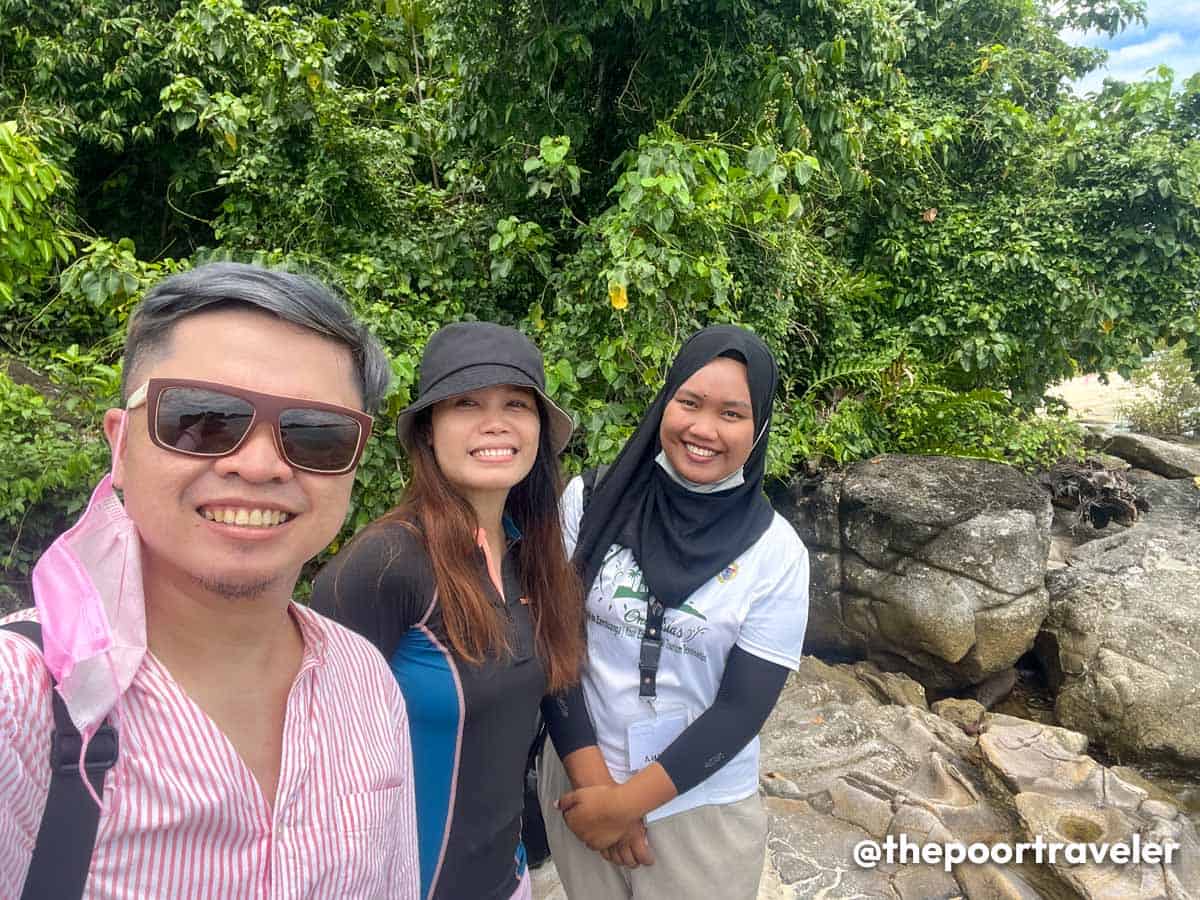
The jump off point is the Panubigan Ferry Terminal, roughly 1.5 hours from the city center.
Jump-off Point: Panubigan Ferry Terminal in Barangay Panubigan Operating Hours: 7:00 AM – 2:00 PM (Tuesday – Thursday, Saturday – Sunday); CLOSED (Mondays & Fridays). Note that the schedule might change without prior notice, so check first before going. Boat Rates: P1,200 (BiBa or Bisaya-Bisaya and Baung-Baung Route, good for 5 pax); P2,000 (Island Cruise, good for 5 pax) Fees: P100/head (Entrance Fee); P100/head (Environmental Fee); P300 (Guide Fee; good for 5 pax); P150 (Cottage Fee)
Below are the accessible islands:
Bisaya-Bisaya Island
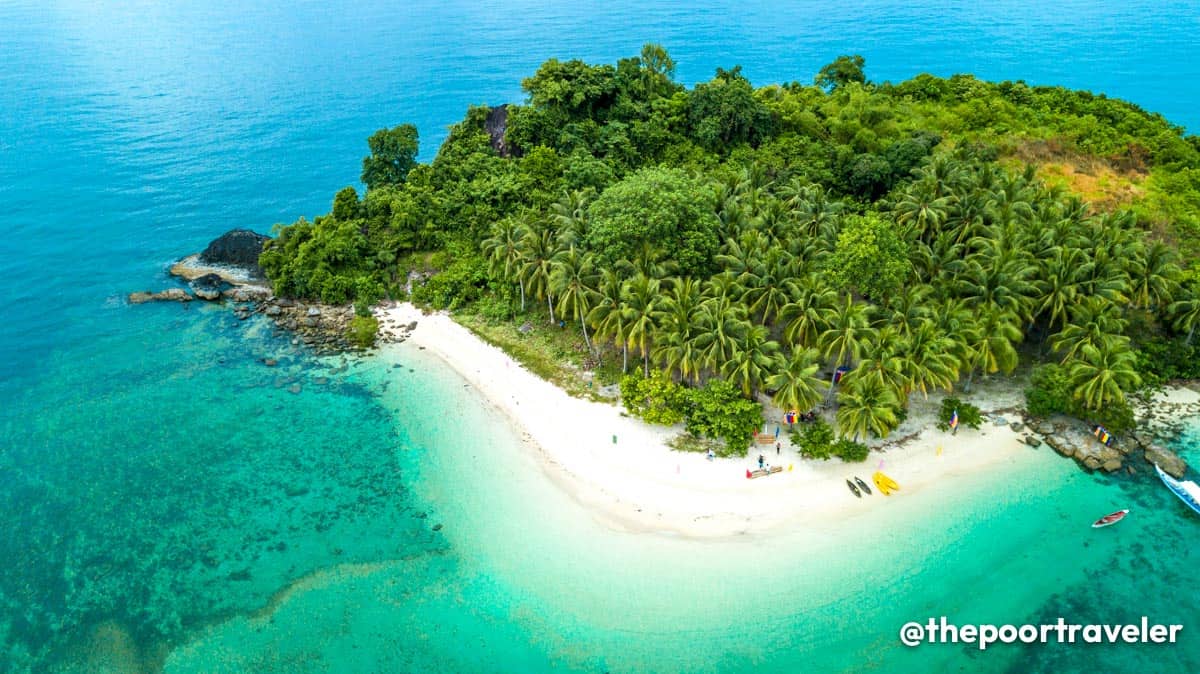
Bisaya-Bisaya Island is a two-faced island, with steep cliffs on one side but blanketed with fine white sand on the other. Its northern face is where you’ll find the sandy stretch, fringed with palm trees. From above, the beach area resembles a boomerang on patch of grass. In between the trees are a few huts where you could stay and enjoy coconut juice, which is for sale on site.
Not too far away is a smaller islet often dubbed a child of Bisaya-Bisaya. This one’s generally more rocky and jagged. It features a small natural pool that gets filled by the waves at high tide.
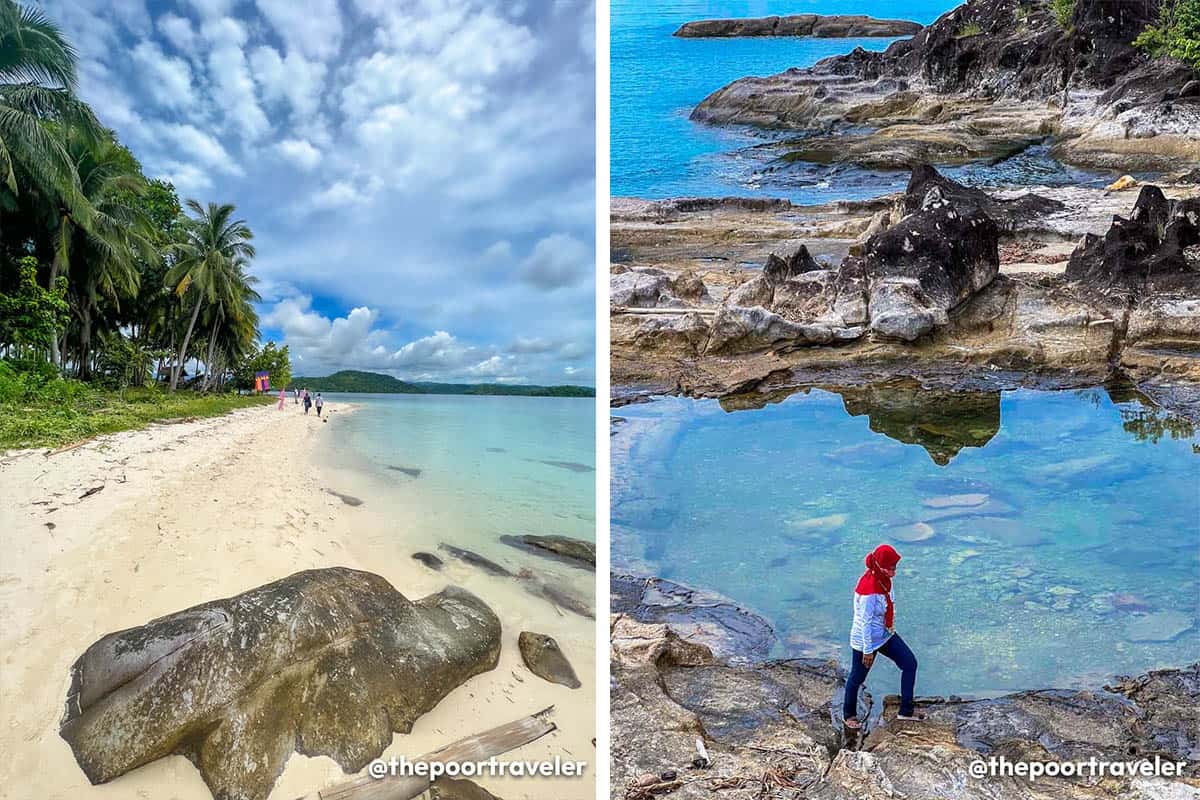
Our guide Sirna shared with us a folk tale about two fishermen, a Christian and a Muslim, who once stumbled upon the island that blessed them with fish. But the two did not agree on how they would divide the ocean bounty — since one of them caught much more than the other — so they decided to go their own way. According to our guide, “bisaya-bisaya” is the local term for “kanya-kanya” or not sharing.
Baung-Baung Island
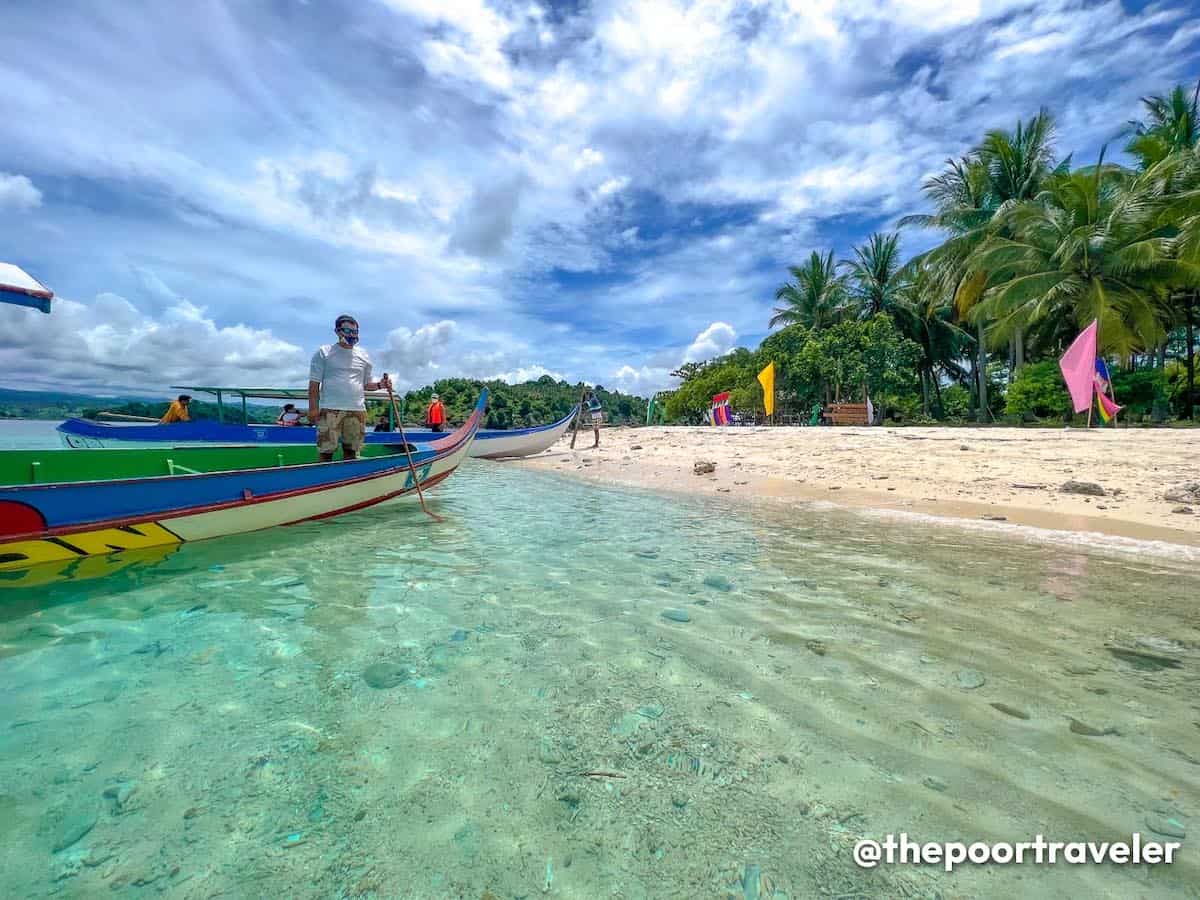
Baung-Baung Island is an almost rectangular island whose southwestern end shimmers with its fine white sand. It’s usually the stop right after Bisaya-Bisaya because of its proximity to it. In fact, Baung-Baung has a trekking trail that will lead you to a viewpoint that affords a majestic view of Bisaya-Bisaya and the other islets around it. On Google Maps, it’s marked “Baong Island”.
Sirommon Island
Sirommon Island is the usual lunch stop for boat tours; thanks to its spacious huts. It also has a wide strip of white sand and a sand bar, which is probably why most tourists spend the most time here. It’s also a great snorkeling stop.
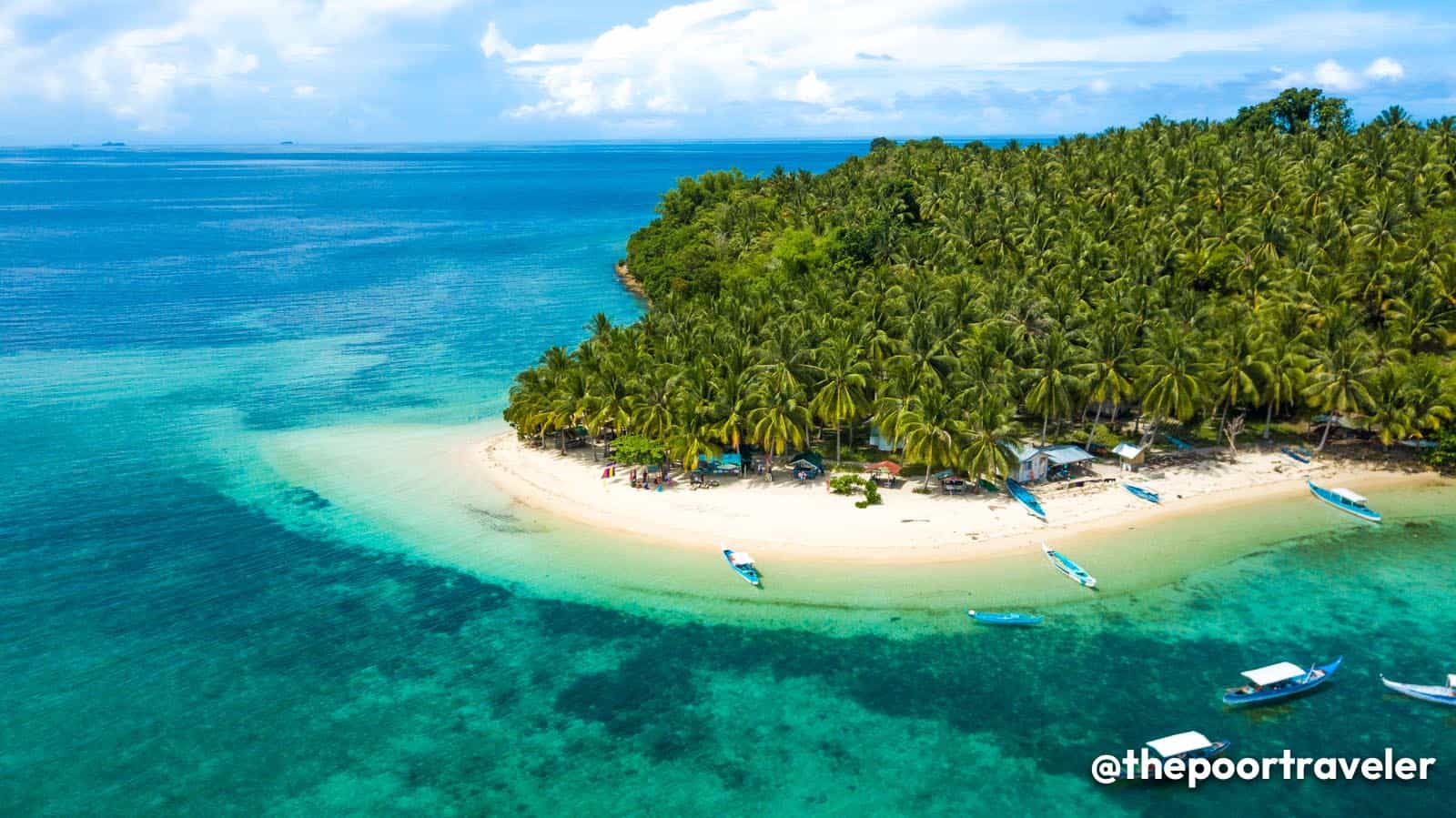
Buh-Buh Island
Buh-Buh Island is best known for its beachfront mosque. Pre-pandemic, tours would make a stop here, but we’re not sure whether or not it’s still the case. We didn’t set foot here, though.
ZAMBOANGA CITY HERITAGE TOUR
El museo de zamboanga.
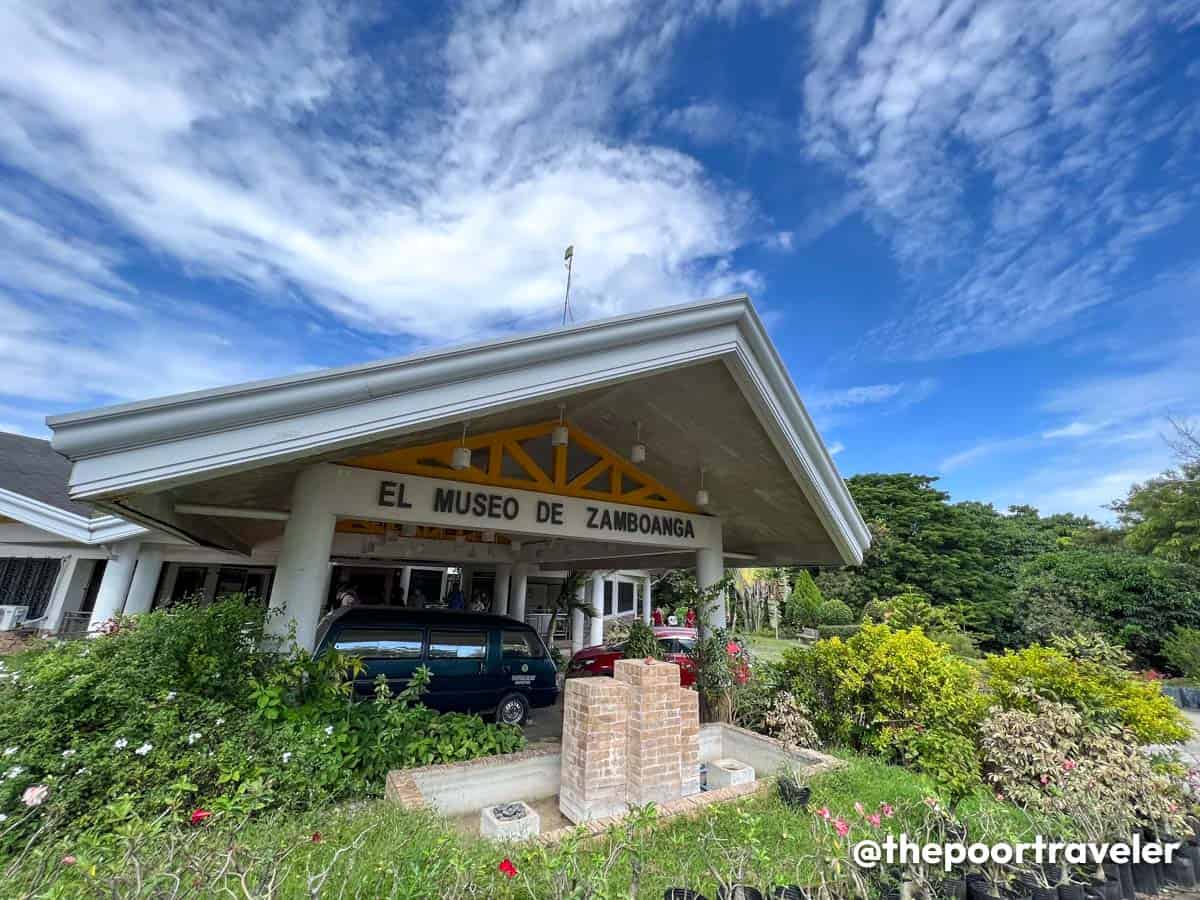
El Museo de Zamboanga should be the first stop of any city tour. It offers a quick overview of the history and heritage of Zamboanga City, which explains much of what you’ll see as you visit more places through the day.
It has two galleries — the main gallery, housing the permanent exhibition, and another one for the temporary or seasonal exhibits. It showcases historical items and artifacts that narrate the colorful story of the region, its people, and its rich culture from the pre-colonial period to the more recent decades. The museum is nestled in the extensive Pasonanca Park.
Location: Hardin Maria Clara Lobregat Complex, Pasonanca Park, Pasonanca Road, Zamboanga City Opening Hours: 9:00 AM – 5:00 PM (Monday – Saturday); CLOSED (Sundays). Note that the schedule may change, so check the official Facebook page for the latest update before going. Entrance Fee: P10 (Adults); P5 (Minors/Students/Seniors)
Pasonanca Park & Scout Limbaga Campsite
Opened to the public in the 1910s, the Pasonanca Park is another green space for nature lovers and those who want to have a quick escape from the much busier city center. It houses the Camp Limbaga (Scout Limbaga Campsite) with a convention center, an amphitheater, an aviary, a floral garden and butterfly sanctuary, and public swimming pools — a kiddie pool, a natural pool, and an Olympic-size pool.
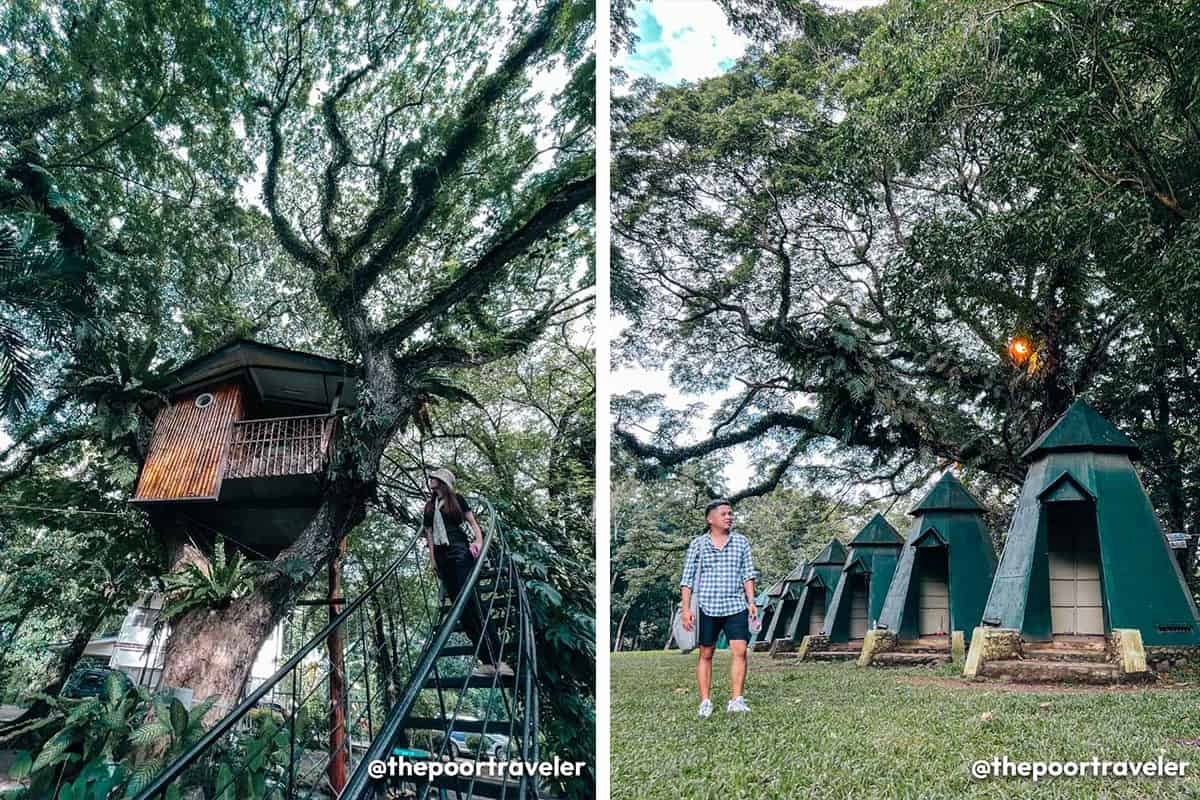
Probably the most famous attraction is the Pasonanca Treehouse. Constructed in 1960, it was originally built to serve as the Youth Citizenship Training Center. Today, visitors come here to take photos, but if you want to spend more time here, you can rent the treehouse too! Make sure to contact the LGU’s admin first to coordinate. You can buy food along the way from the sidestreet restaurants, stores, and BBQ stands.
Opening Hours: 6:00 AM – 6:30 PM (Daily). Note that the schedule might change without prior notice, so check first before going. Admission Fee: FREE. The park itself is free, but the attractions impose their own entrance fees, usually ranging from P10 to P25 per head.
Climaco Freedom Park
Formerly known as Abong-Abong Park, the Climaco Freedom Park is situated about seven kilometers north of the city center. Named after the late Zamboanga City Mayor Cesar Climaco, a local hero who was assassinated in 1984. The park also serves as his final resting place.
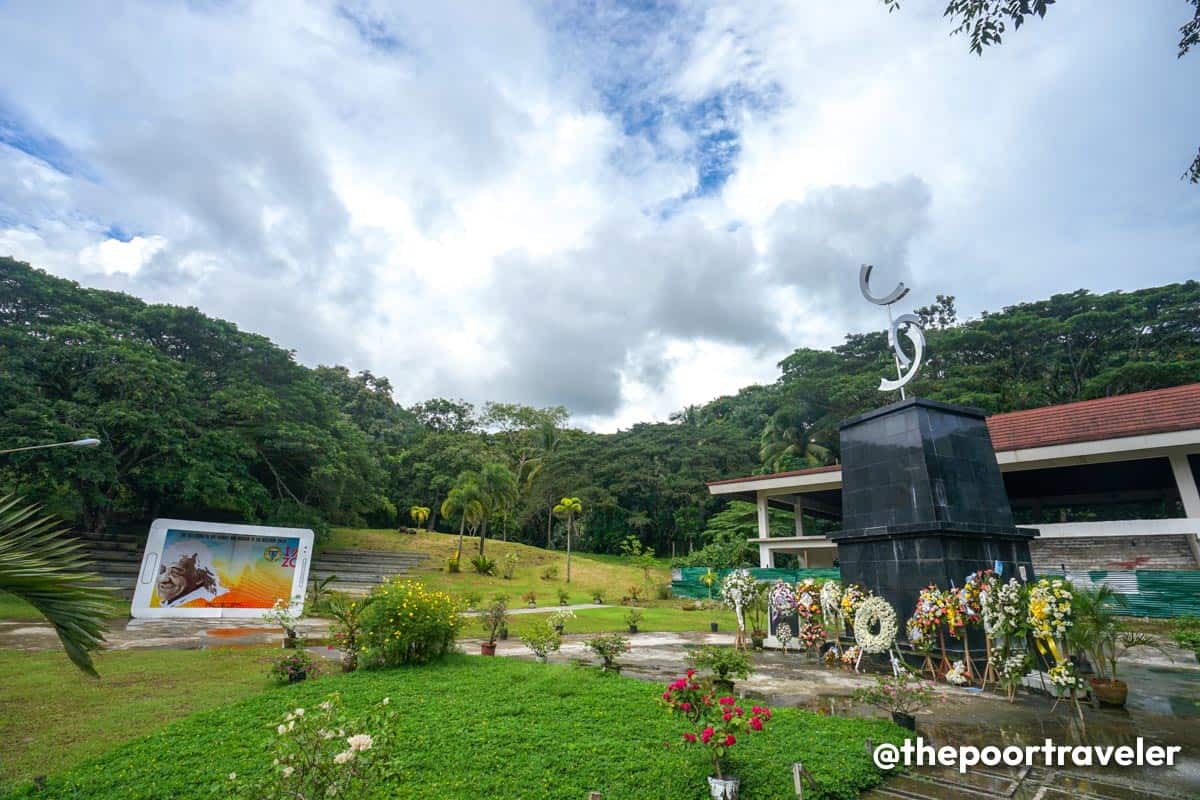
The freedom park is a popular weekend destination for the locals and one of the rising tourist spots, attracting nature lovers of all ages. It encompasses a garden, Chrislam Pool, Boy Scouts and Girl Scouts campsite, Heroes Hill, and the Holy Hill, which is the endpoint of the Station of the Cross trek.
Some of the things to do here are swimming, hiking, trekking, biking, having a picnic, and going on a religious pilgrimage and retreat.
Location: Climaco Freedom Park (Abong-Abong Park), Zamboanga City Opening Hours: 24/7 Admission Fee: P5-10
Fort Pilar Shrine and Museum
Also called Fortaleza del Pilar , Fort Pilar dates back to the 17th century, originally serving as a Spanish military defense post. Fast forward to the present, this bastioned fort is a major historical landmark of the city. Recognized as a National Cultural Treasure in 1973, the fort underwent restorations and is regularly maintained by the city.
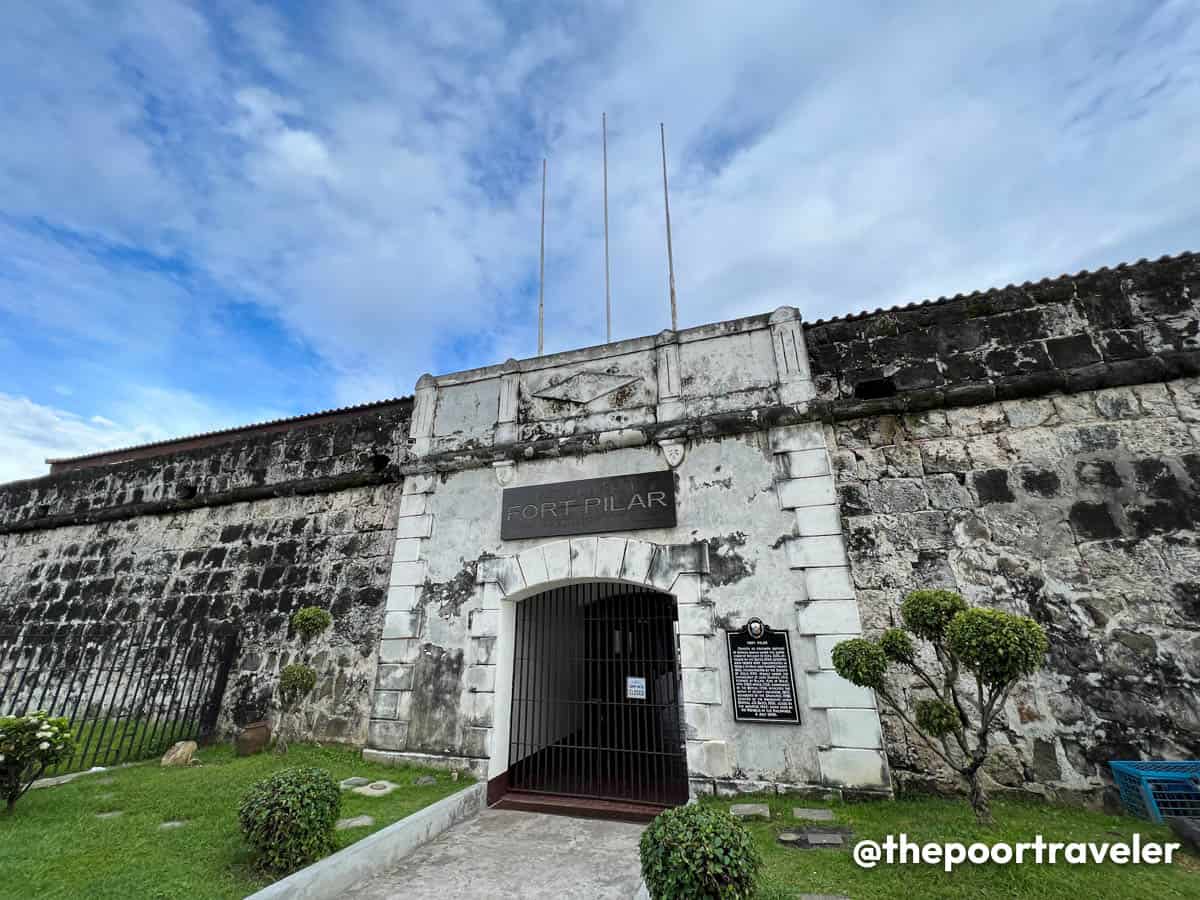
It cradles an open-air 18th-century Marian shrine — Our Lady of the Pillar — with an altar and stone seating for the devotees who want to pray and reflect. On Sundays, monoblock chairs dot the area for the regular mass.
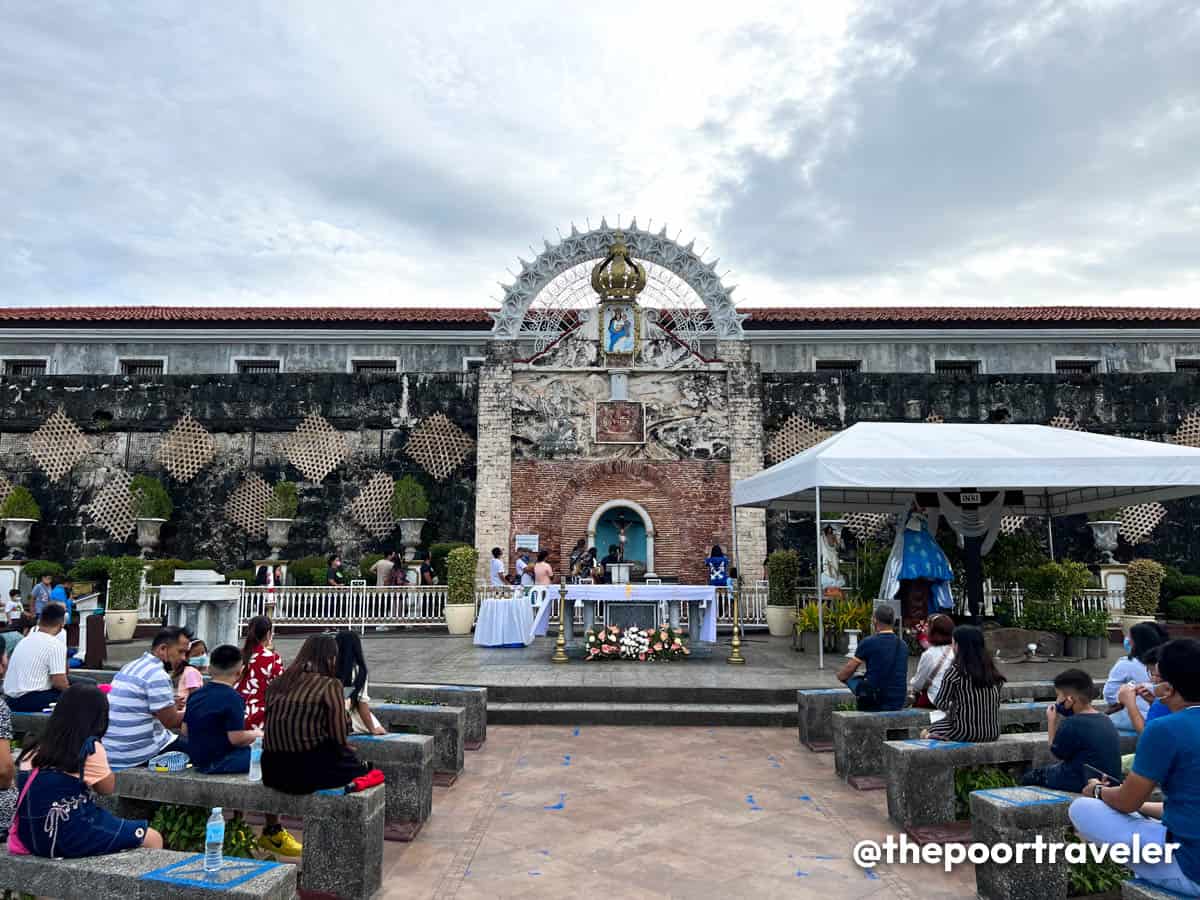
The fort also houses a regional branch of the National Museum of the Philippines, the bells of the Sanctuary to the Lady of the Pillar, and a fountain. The fort is located near Paseo del Mar and Zamboanga State College of Marine Science and Technology.
Location: N.S. Valderosa Street, Santa Barbara, Zamboanga City Opening Hours: Fort Pilar Shrine 9:00 AM – 5:00 PM (Daily); National Museum 8:00 AM – 4:00 PM (Monday – Friday), CLOSED (Saturdays & Sundays). Note that the schedule might change without prior notice, so check first before going. Admission Fee: FREE
ZSCMST Bird Sanctuary
Tucked within the Zamboanga State College of Marine Science and Technology , just a stone’s throw from Fort Pilar and Paseo del Mar, the bird sanctuary is a haven for nature lovers, particularly bird watchers.
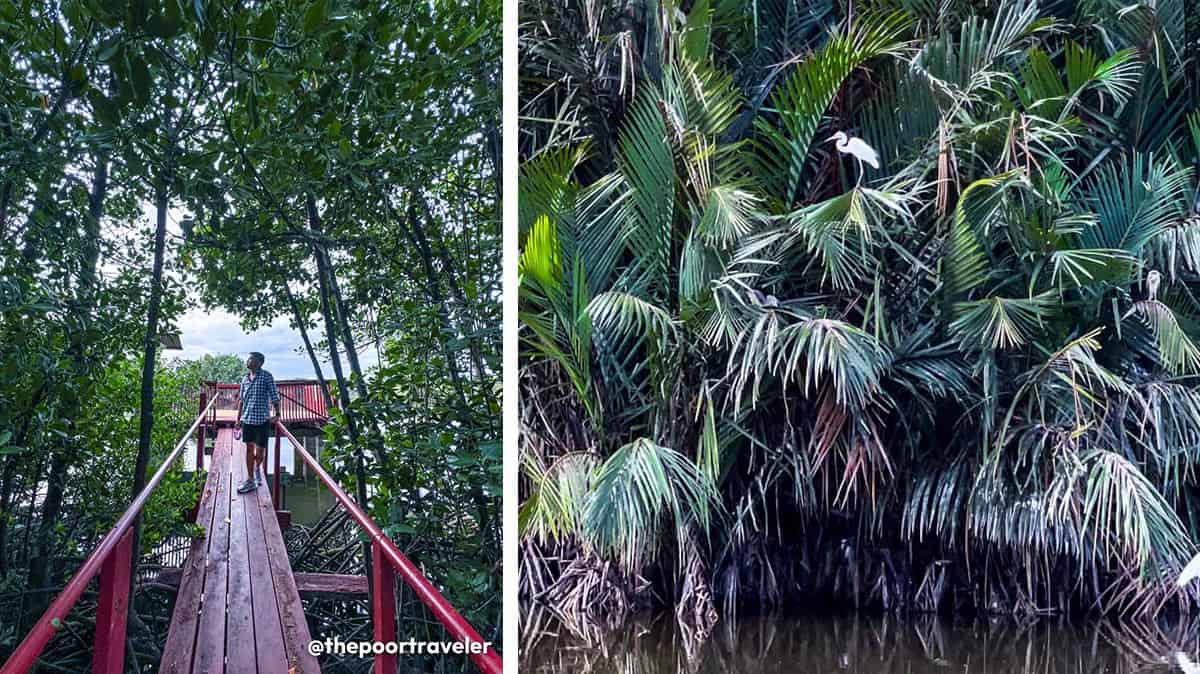
The vast mangrove-fringed pond is a protected area, where great white egrets breed and thrive. Other migratory birds also frequent the site.
Two designated view decks are accessible for those who want to spend some time here. The best time for birdwatching is early morning or late afternoon, while the best months are November to March.
Location: Zamboanga State College of Marine Science and Technology, Zamboanga City Opening Hours: 6:00 AM – 7:00 PM (Daily). Note that the visiting hours might change without prior notice. Check with the ZSCMST management for the updated schedule. Entrance Fee: FREE
Paseo del Mar
Just across Fort Pilar is Paseo del Mar , a waterfront recreational park facing the Basilan Strait. Aside from the souvenir shops, local food vendors, and eateries, the newly renovated park added a children’s playground and a skatepark, making it a favorite hang-out place for the locals.
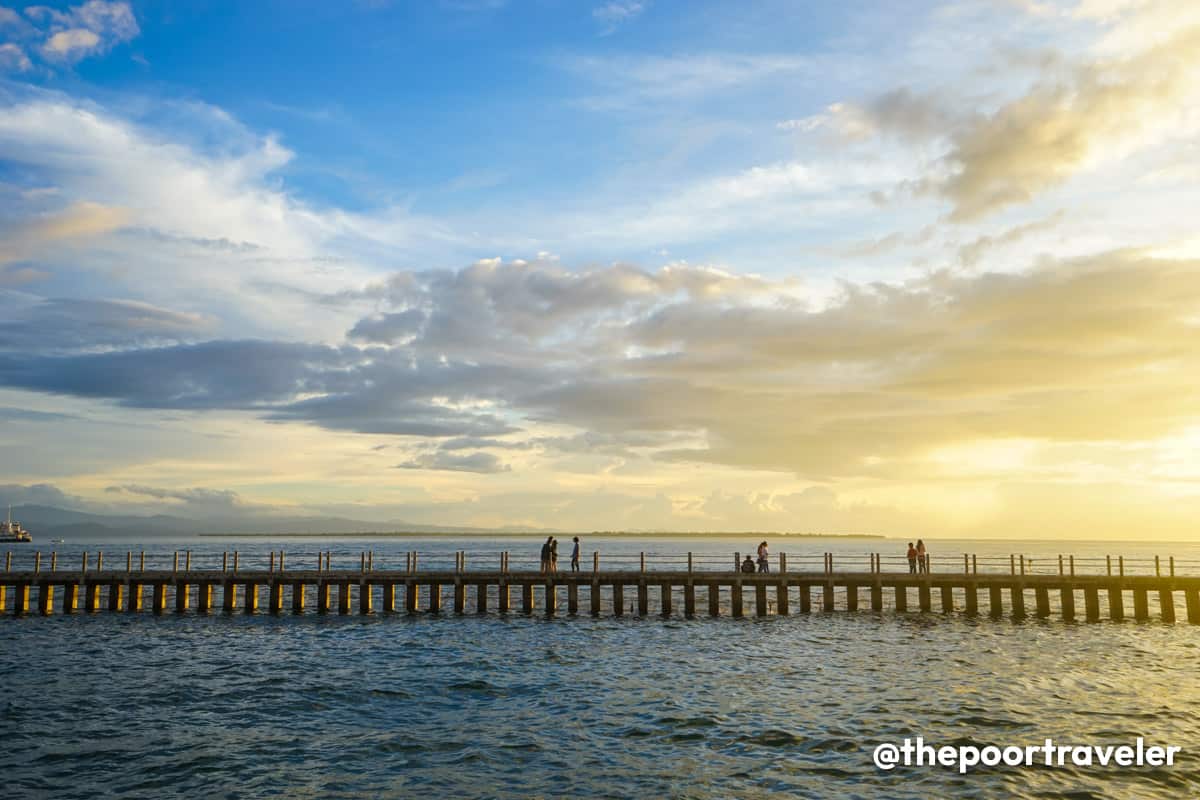
It caters not just to families, friends, and couples but also to those who want to spend their alone time or me-time. Several tables and chairs are arranged for those who like to go food tripping here. Local dishes, snacks, and street fare are available. Benches also line the boardwalk, where sunset revelers lounge to watch the sunlight paints the sky with a beautiful gradient of colors as the day turns into night.
Location: N.S. Valderosa Street, Santa Barbara, Zamboanga City Opening Hours: 6:00 AM – 12:30 AM (Daily). Note that the schedule might change without prior notice, so check first before going. Admission Fee: FREE
Canelar Barter Trade Center
OK, first things first, despite the name, you need cash when shopping here so please put down whatever it is you plan to trade. 🤣 The name is a nod to the trading system of exchanging goods that was widely practiced in this part of the world back in the day.
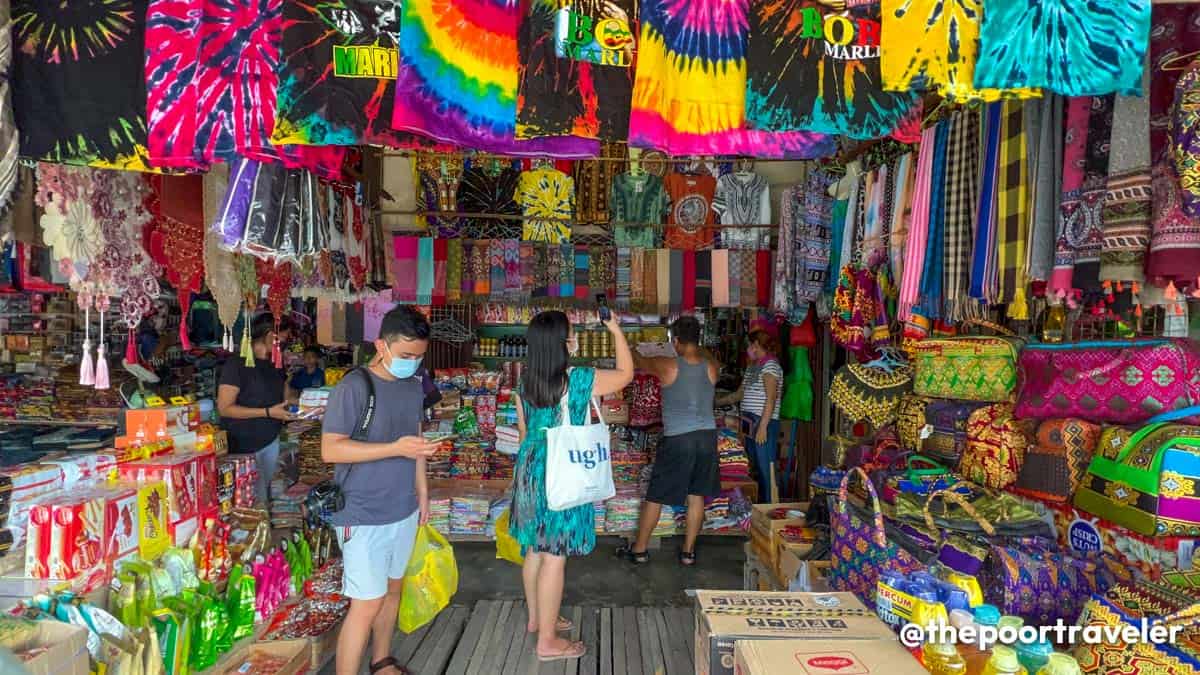
Today, however, it functions just like any other shopping center. Time to brush up on your haggling skills when you dive into this shopping paradise, tempting you with its cheap imported offerings from the neighboring countries Indonesia and Malaysia.
Alongside local products, a wide array of imported goods are sold here — souvenirs, food, clothes, fabrics, gadgets, accessories, among others. Get a hold of your favorite Malaysian or Indonesian chocolates, coffee brands (Old Town Cofee and others), and milk tea (teh tarik) at relatively cheaper prices. Lastly, don’t forget to pause and breathe. Good? Okay. Let the second wave of haggling and negotiating begin!
Location: Canelar Barter Trade Center, Zamboanga City Opening Hours: 8:00 AM – 5:30 PM (Tuesday – Sunday), 7:30 AM – 6:30 PM (Mondays). Note that the schedule might change without prior notice, so check first before going.
Zamboanga City Hall
Smack at the very heart of the city center, where well-preserved colonial structures are clustered, the Zamboanga City Hall is considered one of the important heritage sites in the city.
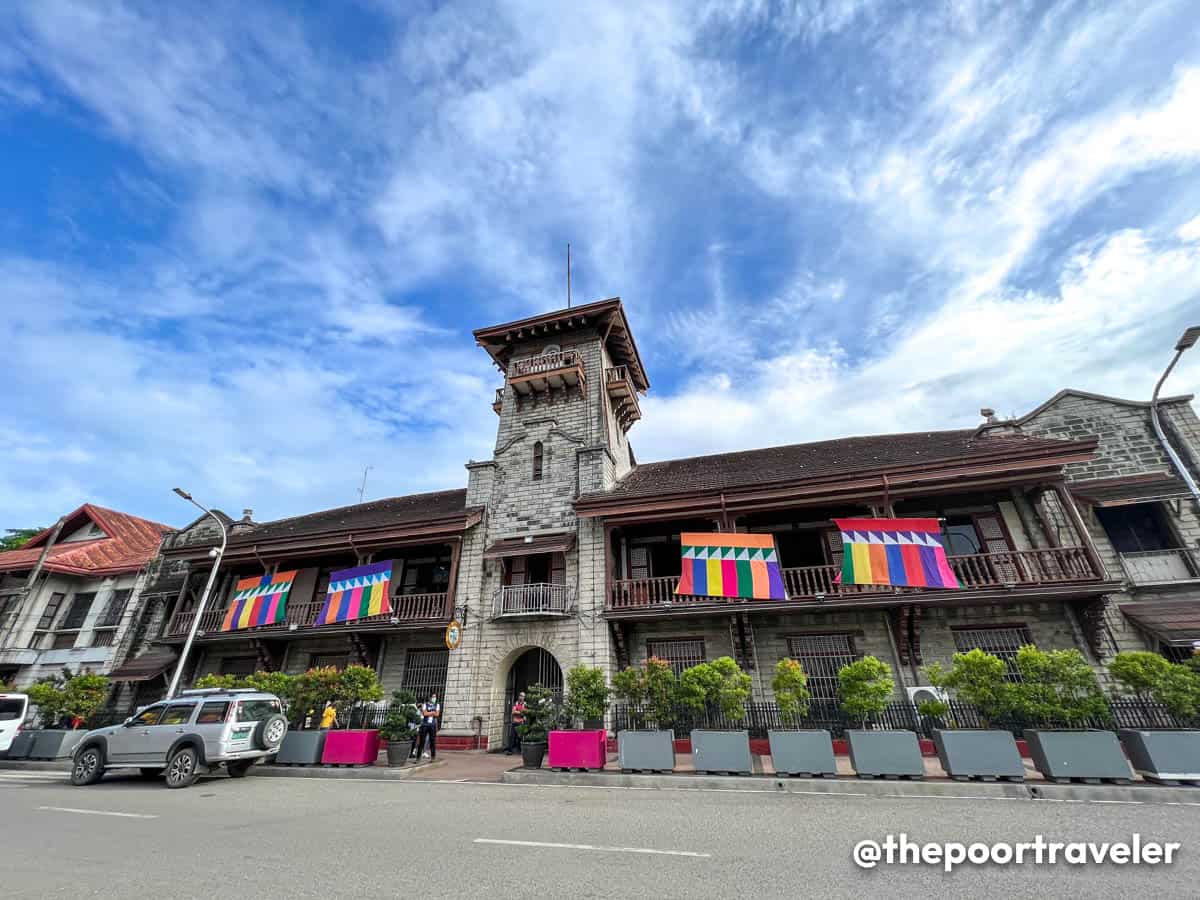
Recognized as a National Historical Site, it was originally used as the official residence of the US Military Governor of the then Moro Province. Later on, it became the government seat of the former Zamboanga Province. It has been serving as the administrative seat of Zamboanga City since 1937. Rizal Park or Plaza Rizal is just across the city hall.
Location: N.S. Valderosa Street, Zamboanga City Opening Hours: 8:00 AM – 5:00 PM (Monday – Friday), 8:00 AM – 12:00 PM (Saturdays), CLOSED (Sundays). Note that the schedule might change without prior notice, so check first before going.
Yakan Weaving Village
While in Zamboanga City, don’t pass up the opportunity to take home the best tangible souvenirs you can buy — products made from the exquisite Yakan fabric, which takes time to finish, depending on the intricacy of the designs and patterns. The Yakan are the traditional inhabitants of Basilan and other areas in this part of Mindanao.
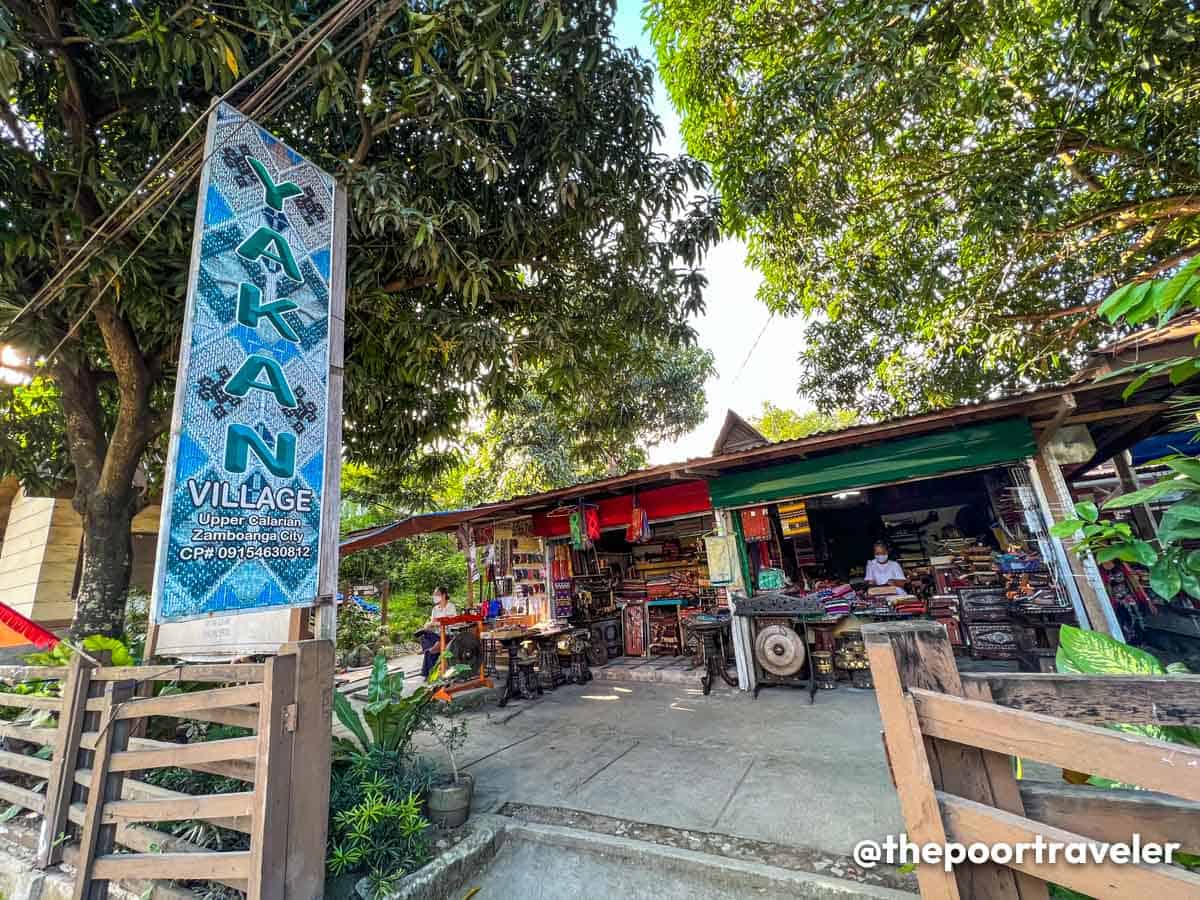
Here in Zamboanga City, you’ll find the Yakan Weaving Village , which harbors local shops selling traditional products and practical accessories including bags, purses, pencil cases, and even yards of Yakan fabrics. You can also watch (or try for yourself!) the traditional process of Yakan weaving.
Location: Upper Calarian, Labuan – Limpapa National Road, Zamboanga City Opening Hours: 8:00 AM – 8:00 PM (Daily). Note that the schedule might change without prior notice, so check first before going.
ZAMBOANGA FOOD TRIP
Curacha (spanner crabs).
Nope. We are not talking about the Filipino femme fatale movie character played by Rossana Roces nor actual cockroaches! Curacha means cockroach in the Chavacano language, but — before you lose your appetite — we’re not asking you to go full Fear Factor here. Instead, we’re inviting you to have a taste of the most mouth-watering crustaceans that Zamboanga has to offer — spanner crabs! (It got its name because of its spiky appearance.)
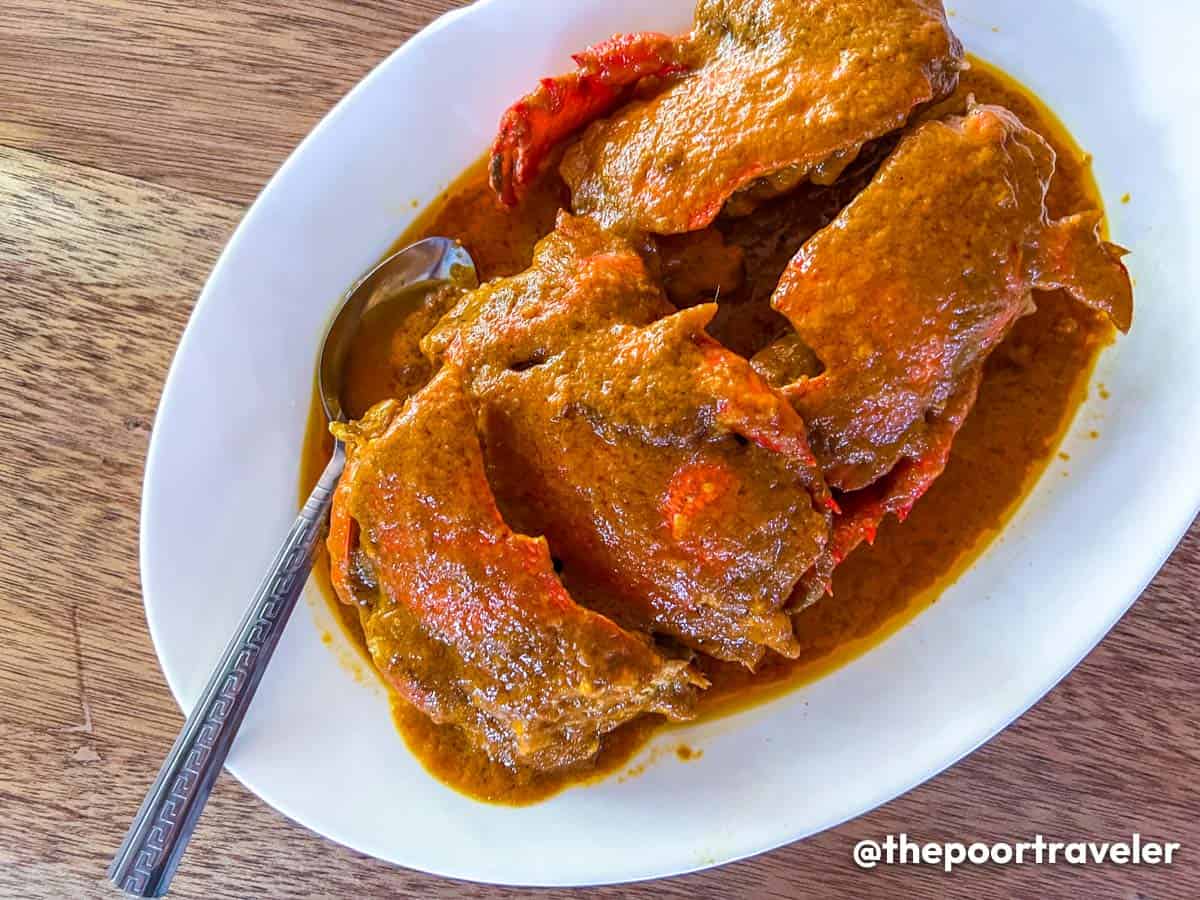
So what is it exactly? We are talking about Zamboanga’s gastronomic gem. Curacha looks like the love child of a huge crab and a hairy lobster. Known for its consistent red appearance, whether raw or cooked, it is sought after because it’s meatier than other crabs and packs more flavor. Thankfully, they thrive in the bosom of the Sulu Sea.
Your trip won’t be complete without trying a dish or two. Alavar’s Seafood Restaurant is famous for its curacha dish cooked in its equally popular specialty sauce.
If you want to take some home, head over to Aderes Flea Market in Guiwan, where you can purchase fresh fresh, uncooked curacha at a lower price. Lobsters are also available!
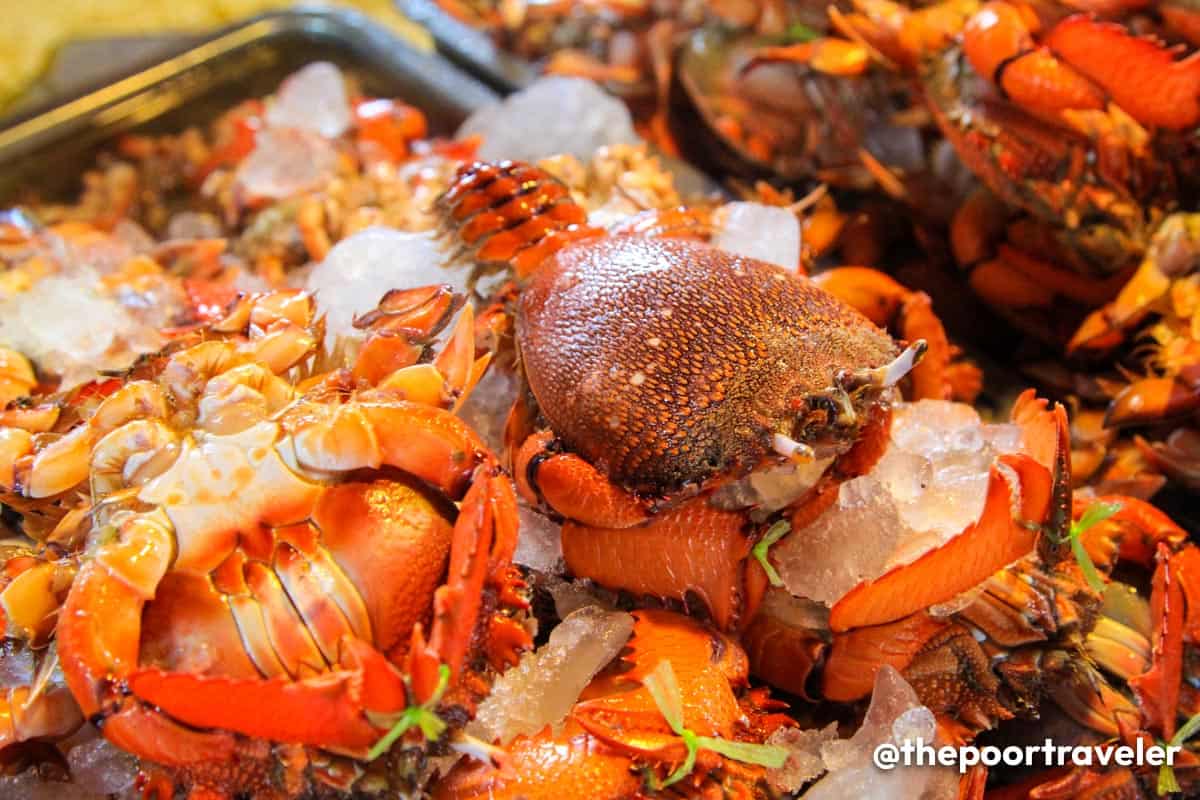
Moro Cuisine
The Filipino Muslims, also known as the Moros, take pride in their distinct cuisine. Although sharing some similarities with other parts of the country in terms of seasonings and ingredients like garlic, onions, and ginger, what make Moro cuisine different are other spices like turmeric, lemongrass, galangal, and kaffir lime — which are more commonly used by our ASEAN neighbors. It also utilizes burnt or blackened coconut meat in some dishes.
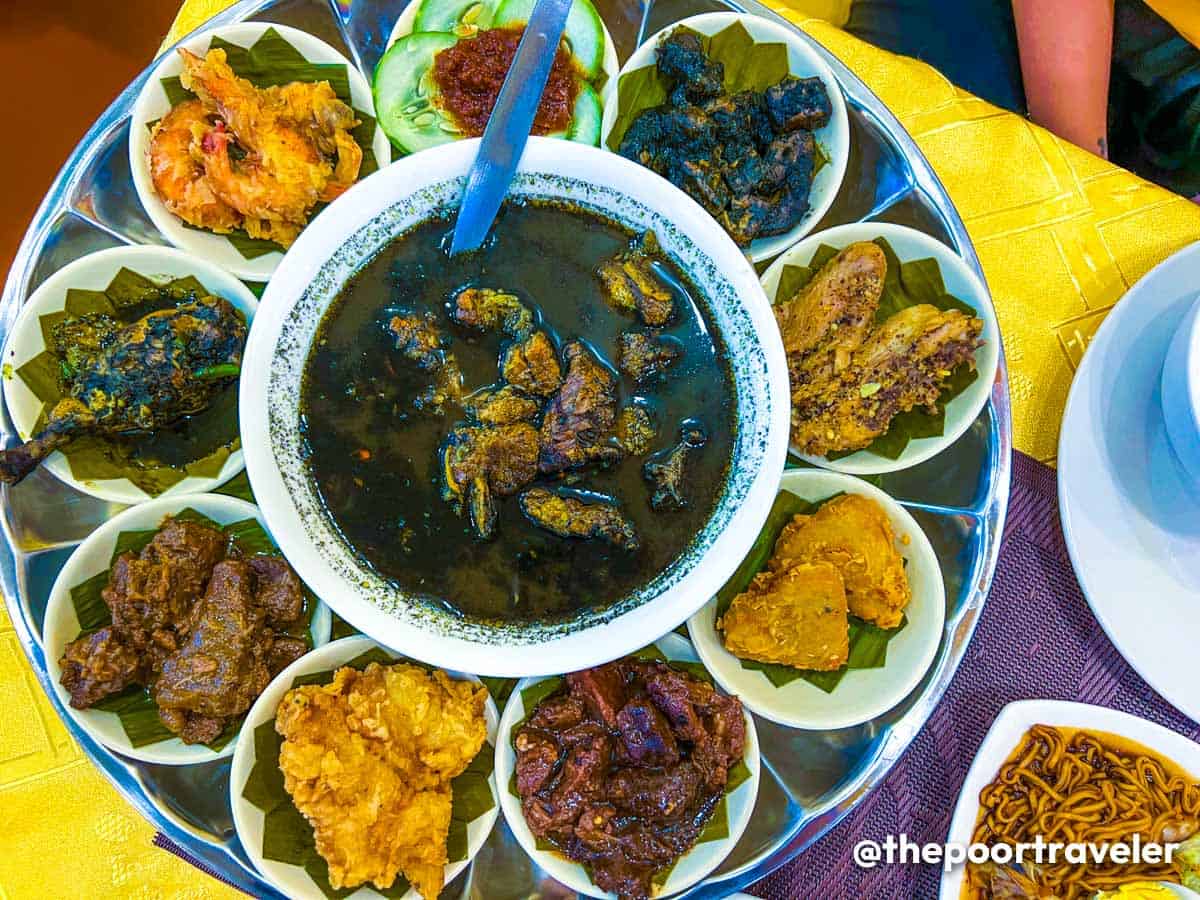
Some of the Moro faves are beef randang, piaparan, bakas, chicken pyanggang, pater, dodol, and lukatis. If you want to sample several dishes in one sitting, the latal is your best choice. It is a platter of some native dishes of the region.
Both Bay Tal Mal (at SM Mindpro) and Dennis Coffee Garden (near the airport) have latal on their menu.
Knickerbocker
After a sumptuous native Moro food fest, end it “sweetly” with a tall serving of Zamboanga’s iconic dessert — the knickerbocker.
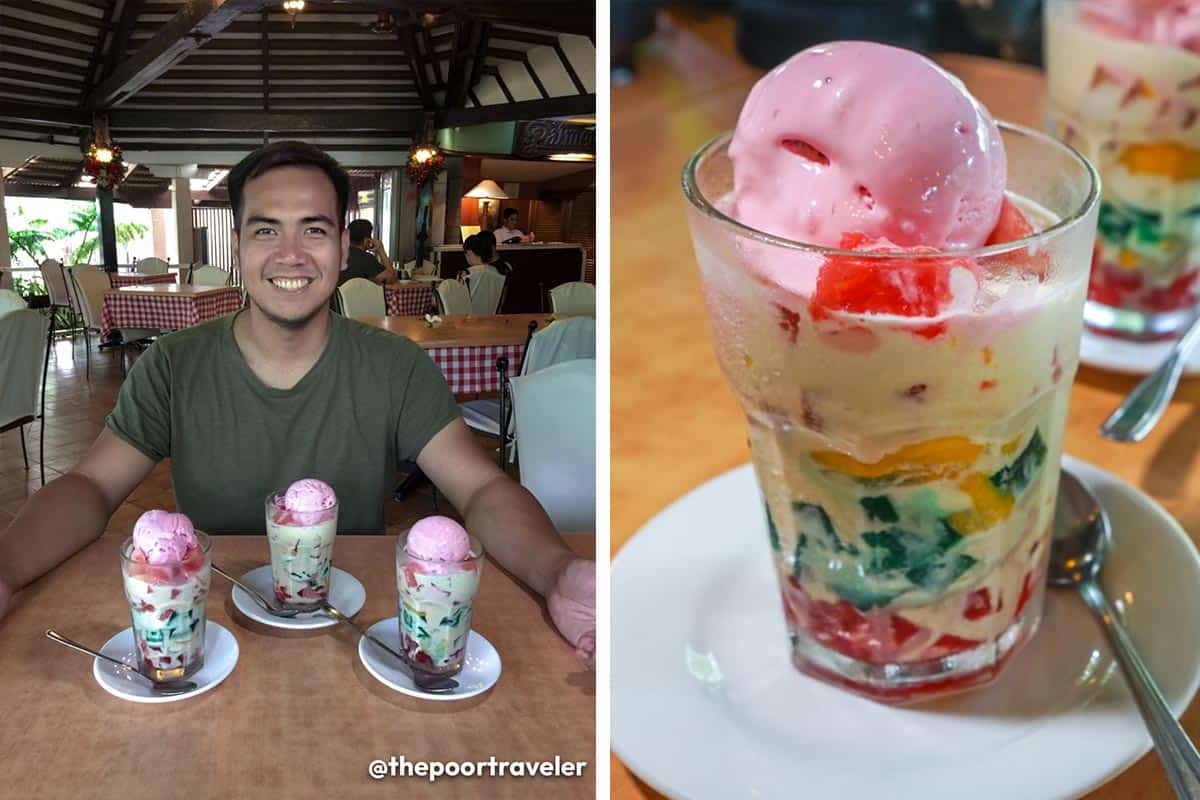
A what? A hybrid of fruit salad and halo-halo, Zamboanga’s knickerbocker usually combines slices of fruits, gelatin, and shaved ice. It is then doused in milk and topped with a scoop of ice cream.
The Palmeras , also known as Hacienda de Palmeras , is said to be the home of the original knickerbocker and is credited for inventing this refreshing dessert.
Satti and Street Food
Of course! Any TPT trip isn’t complete without delving into the street food scene! These everyday accessible munchies tell a lot about the place, its people, and its culture. You can find street food anywhere, especially in busy areas like the public market and around the city hall.
Paseo del Mar has its share of street grubs and snacks. R.T. Lim Boulevard also hosts a number of street food peddlers. Some of the streetfood choices are satay or “ihaw-ihaw”, pastil, sicalang, and lokot-lokot. But our favorite is mi goreng!
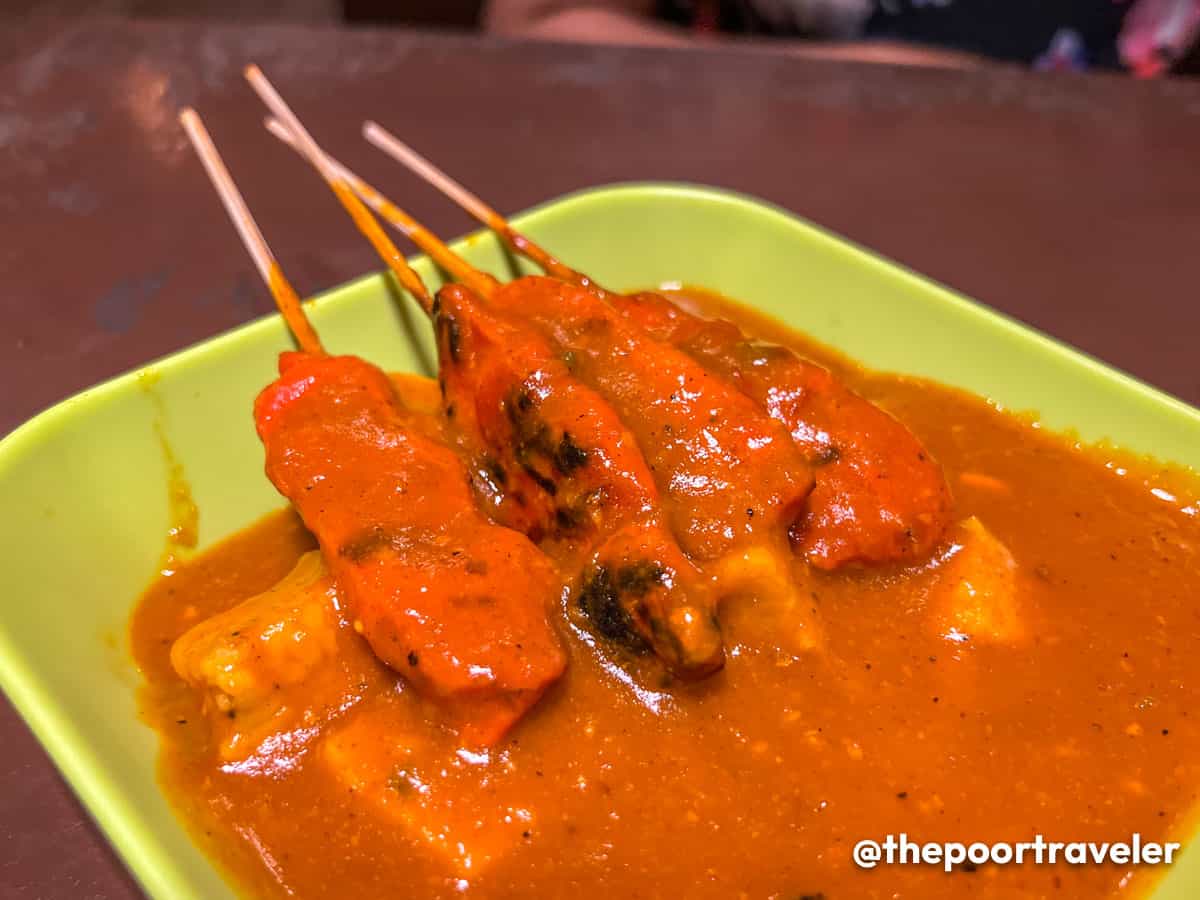
But perhaps the most iconic of all is satti , a breakfast favorite among locals. Satti is usually skewered beef or chicken, grilled and then served half-dipped in a bowl of spicy sauce with rice shaped into cubes!
When we asked the locals where to find the best satti in the city, all fingers pointed at Jimmy’s Satti . Unfortunately, we weren’t able to try it, but we had our helping from Dennis Coffee Garden, which also serves satti.
OTHER WORTHY ATTRACTIONS & ACTIVITIES
Zamboanga hermosa festival.
The city’s annual celebration of the Zamboanga Hermosa Festival is dedicated to its patron saint La Virgen Nuestra Señora del Pilar . It’s a month-long festivity that takes place in October; the first two weeks of which are usually packed with activities, peaking in the second week, particularly on the feast day of the patron saint, which is on the 12th day of October.
One of the main events is the Regatta de Zamboanga , a vinta race participated by hundreds of vinta owners and operators. All the participants are residents of Zamboanga.
Festival Date: Month of October
Taluksangay Mosque
If you trace the roots of Islam in Zamboanga, they will most likely lead you to the coastal village of Taluksangay on the southeast coast of the city. Here, just next to the barangay hall, stands a historic mosque. It is believed that it is here that Islam began to spread in the peninsula.
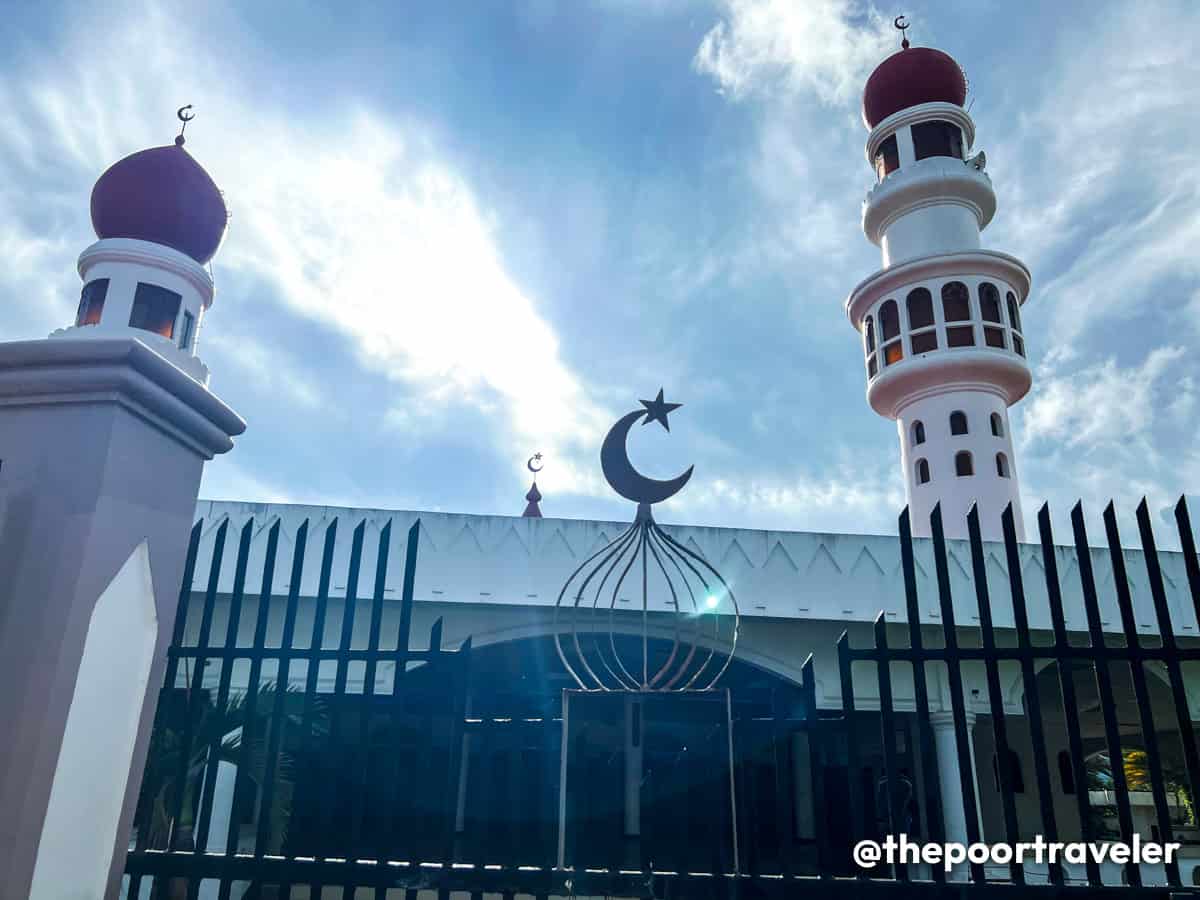
Constructed in 1885 by Hadji Abdullah Maas Nuno, the Taluksangay Mosque is said to be the oldest in Western Mindanao and the first in Zamboanga Peninsula. The mosque’s most recognizable features are the two minarets.
This off-route destination is mostly visited by Muslims and history buffs.
Location: Taluksungay Mosque, Barangay Taluksungay, Zamboanga City Opening Hours: Visitors can enter the mosque anytime EXCEPT during prayer times, which happen five times a day. It’s best to drop by the barangay hall, which is located just beside the mosque. Please observe visiting rules and protocols.
Merloquet Falls
Located about two hours away from the city center, near the boundary with Zamboanga Sibugay in the north and Zamboanga del Norte in the west, the magnificent two-tiered Merloquet Falls is regarded as one of the most beautiful not only in the region but in the country. The most photographed is the wide terraced drop, creating magical, intricate textured cascades instead of just a smooth straight drop.
The path leading to the falls is quite developed with concrete roads and a designated parking area for vehicles. On foot, the trek to the falls entails many cemented pathways and steps. Nonetheless, this may still be quite difficult for those who are physically challenged.
There are several swimming areas, but mind your steps because some parts are slippery. The best time to visit is in the wet/rainy season.
Location: Merloquet Falls Road, Barangay Sibulao, Zamboanga City Admission Fee: FREE Parking Fee: P20
Learn Chavacano
Zamboanga is often called Asia’s Latin City because of the heavy Hispanic influences. And it’s most apparent in its most dominant language — Chavacano (or Chabacano), the only Spanish-based creole in Asia. It is like a combination of Spanish and local languages, and it’s quite fascinating!
Why not learn Chavacano while in Zamboanga? Start from the basics such as greetings and useful phrases that you can use while in the city. It is also a good way to interact with the locals and learn more about their culture.
- Welcome! = Bienvenidos!
- Thank you very much. = Muchisimas Gracias.
- Good morning! = Buenas Dias!
- Good afternoon! = Buenas Tardes!
- Good evening! = Buenas Noches!
- I’m sorry. – Perdona mi.
- How much is this? – Cuanto esté?
How to Get to Zamboanga City
AirAsia flies daily to Zamboanga City from Manila and offers some of the most budget-friendly fares. Each booking comes with a complimentary 7kg carry-on baggage allowance.
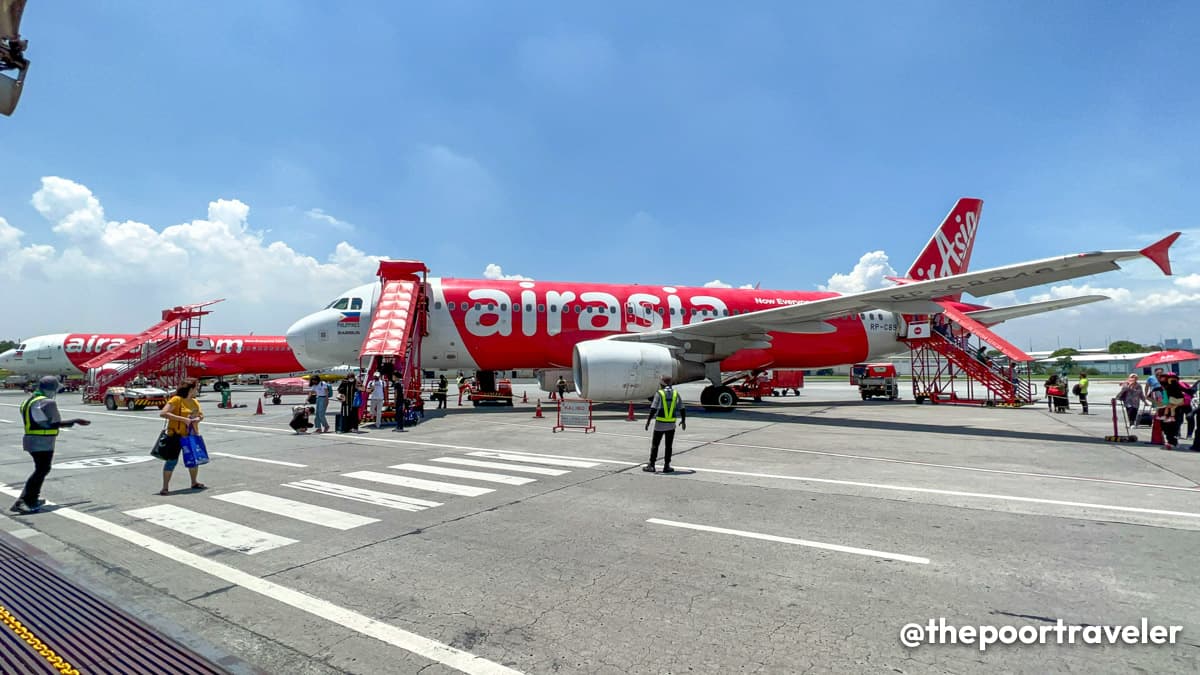
For a worry-free and more comfortable journey, you can also add a Value Pack , which includes 20kg check-in baggage allowance, standard selection, a meal, and Tune Protect insurance (for baggage delay & 1 hour on-time guarantee protection). Meanwhile, their Premium Flex option allows you to change the date and time of your flight up to two times.
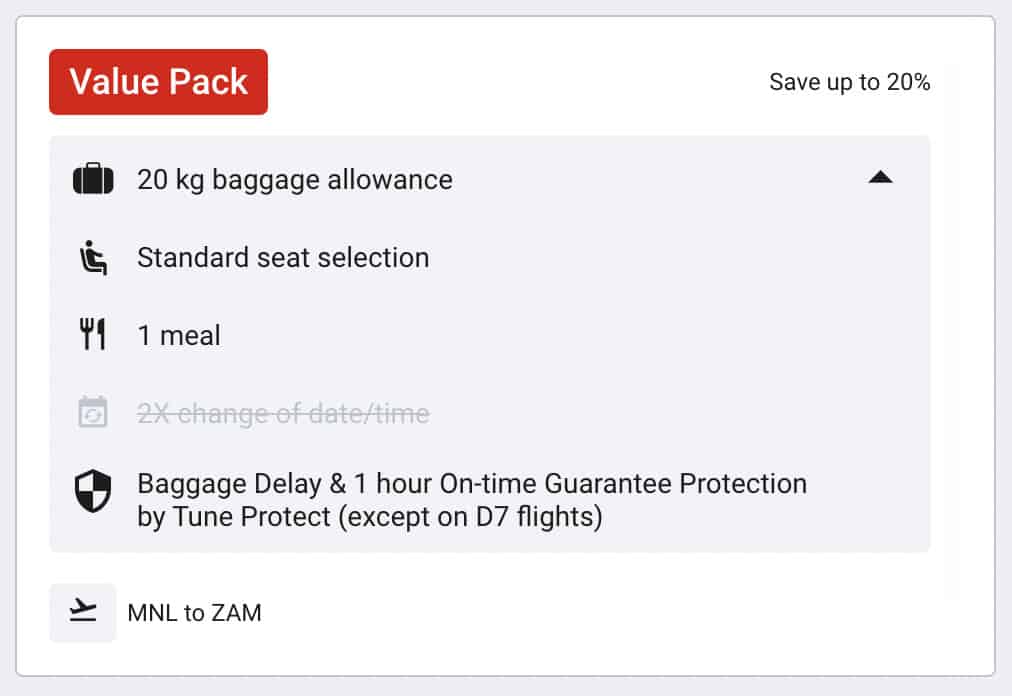
If you’re coming from Manila, AirAsia’s Zamboanga flights operate from NAIA Terminal 4.
Where to Stay in Zamboanga City
Accommodations in Zamboanga is much more affordable than in other highly urbanized cities in the Philippines. Average rate for a double or twin room at a business hotel should play within P1500-P1800 per night. But you can find a room for less than PhP 1500, even lower when there are ongoing promos.
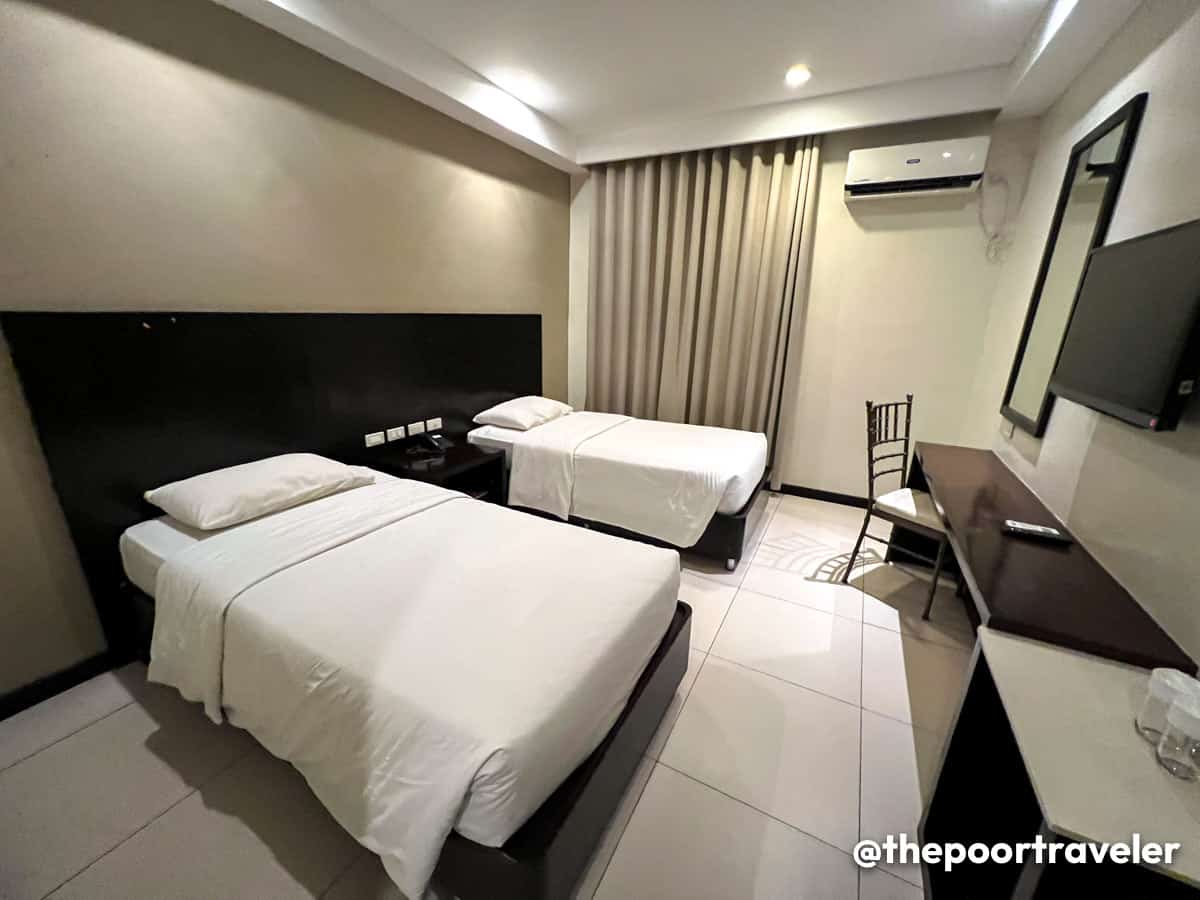
We have tried three different hotels in Zamboanga and all of them were decent and pleasant:
- Ever O Business Hotel. Check Rates & Availability! ✅
- Winzelle Suites. Check Rates & Availability! ✅
- L’ Meridian. Check Rates & Availability! ✅
If you have a bigger budget, you may also check out these other properties in the area:
- Marcian Garden Hotel. Check Rates & Availability! ✅
- Hotel Primera. Check Rates & Availability! ✅
- W Hotel. Check Rates & Availability! ✅
- Grand Astoria Hotel. Check Rates & Availability! ✅
Search for more Zamboanga Hotels!
Words by: Asta Alvarez Additional words by: Yosh Dimen Photos by: Yosh Dimen & Vins Carlos
Disc: Parts of our trip (particularly El Museo de Zamboanga, Zamboanga City Hall, Taluksangay Mosque and Once Islas) were made possible by AirAsia through a media tour.
More Tips on YouTube ⬇️⬇️⬇️
Is this post helpful to you?

Related Posts:
- 6 Incredible Beaches Around the World
- 4 Extraordinary Beaches in the Philippines to Visit
- ZAMBOANGA CITY TRAVEL GUIDE with Requirements, Itinerary & Budget
- 7 Must-Try ZAMBOANGA CITY Restaurants & Food Spots

- Recent Posts
- 2024 STILTS CALATAGAN Beach Resort Travel Guide with Itinerary & Budget - 7 April 2024
- TOKYO SKYTREE TRAVEL GUIDE: Know Before You Visit! - 30 March 2024
- 37 BORACAY TOURIST SPOTS & Things to Do (with Prices!) - 6 November 2023
Philippines is really the “Pearl of the Orient”. Its is blessed with rich natural resources, scenic, cultural and heritage spot, really full of history and Zamboanga City is one of the place. The Zamboanga City Pasonanca Natural Park is currently nominated as an Asean Heritage Park should it be finally declared as one it would be another spot in the city worth mentioning. The place encompasses the protected areas of the Pasonanca park which is a watershed and a virgin forest rich in fauna and flora.
Featured On

We heard you!
Your comment is now queued for moderation! We’ll try to get back to you soonest. While waiting, follow us on these channels.
Subscribe on Youtube! Follow us on Instagram!


- VIGATTINDEALS
- VIGATTININSURANCE
- VIGATTINTRADE
- OTHER SITES
- DESTINATIONS
- TOURIST SPOTS
- RESTAURANTS
- Sort Alphabetically
- Sort by Region
- • Abra
- • Agusan del Norte
- • Agusan del Sur
- • Aklan
- • Albay
- • Angeles City
- • Antique
- • Apayao
- • Aurora
- • Bacolod City
- • Baguio City
- • Basilan
- • Bataan
- • Batanes
- • Batangas
- • Benguet
- • Biliran
- • Bohol
- • Bukidnon
- • Bulacan
- • Butuan City
- • Cagayan
- • Cagayan de Oro City
- • Caloocan City
- • Camarines Norte
- • Camarines Sur
- • Camiguin
- • Capiz
- • Catanduanes
- • Cavite
- • Cebu
- • Cebu City
- • Compostela Valley
- • Cotabato City
- • Dagupan City
- • Davao City
- • Davao del Norte
- • Davao del Sur
- • Davao Occidental
- • Davao Oriental
- • Dinagat Islands
- • Eastern Samar
- • General Santos City
- • Guimaras
- • Ifugao
- • Iligan City
- • Ilocos Norte
- • Ilocos Sur
- • Iloilo
- • Iloilo City
- • Isabela
- • Kalinga
- • La Union
- • Laguna
- • Lanao del Norte
- • Lanao del Sur
- • Lapu-Lapu City
- • Las Piñas City
- • Leyte
- • Maguindanao
- • Makati City
- • Malabon City
- • Mandaluyong City
- • Manila City
- • Marikina City
- • Marinduque
- • Masbate
- • Misamis Occidental
- • Misamis Oriental
- • Mountain Province
- • Muntinlupa City
- • Naga City
- • Navotas City
- • Negros Occidental
- • Negros Oriental
- • North Cotabato
- • Northern Samar
- • Nueva Ecija
- • Nueva Vizcaya
- • Occidental Mindoro
- • Olongapo City
- • Oriental Mindoro
- • Ormoc City
- • Palawan
- • Pampanga
- • Pangasinan
- • Parañaque City
- • Pasay City
- • Pasig City
- • Pateros
- • Puerto Princesa City
- • Quezon
- • Quezon City
- • Quirino
- • Rizal
- • Romblon
- • Samar
- • San Juan City
- • Santiago City
- • Sarangani
- • Siquijor
- • Sorsogon
- • South Cotabato
- • Southern Leyte
- • Sultan Kudarat
- • Sulu
- • Surigao del Norte
- • Surigao del Sur
- • Tacloban City
- • Taguig City
- • Tarlac
- • Tawi-Tawi
- • Valenzuela City
- • Zambales
- • Zamboanga City
- • Zamboanga del Norte
- • Zamboanga del Sur
- • Zamboanga Sibugay
- Region I (Ilocos Region)
- Region II (Cagayan Valley)
- Region III (Central Luzon)
- Region IV-A (CALABARZON)
- Region IV-B (MIMAROPA)
- Region V (Bicol Region)
- Region VI (Western Visayas)
- Region VII (Central Visayas)
- Region VIII (Eastern Visayas)
- Region IX (Zamboanga P.)
- Region X (N. Mindanao)
- Region XI (Davao Region)
- Region XII (SOCCSKSARGEN)
- Region XIII (Caraga Region)
- CAR (Cordillera)
- ARMM (Muslim Mindanao)
- Attractions
- Restaurants
SoCCSKSarGen (Region XII Profile)
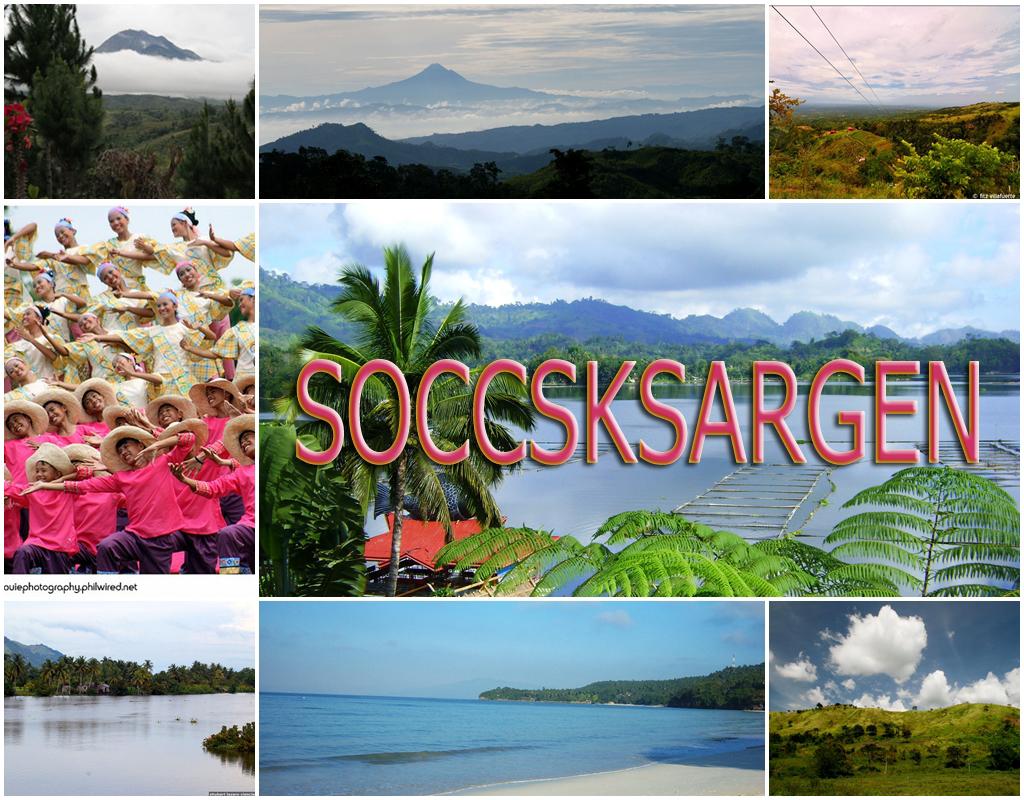
SoCCSKSarGen is a region of the Philippines, located in central Mindanao, and is officially designated as Region XII. The name is an acronym that stands for the region's four provinces and one of its cities: South Cotabato, Cotabato, Sultan Kudarat, Sarangani and General Santos City. The regional center is Koronadal City located in the province of South Cotabato. Cotabato City itself is part of SOCCSKSARGEN, but Maguindanao is part of the Autonomous Region in Muslim Mindanao.
Tourist spots include Mt. Apo, Lake Sebu, cultural villages, old Mosques and shrines, hot springs and lakes. There are four feeder airports found in Lebak, Kalamansig, Tacurong City, all in Sultan Kudarat and Surallah, South Cotabato; one national airport which is found in Cotabato City and one international airport in General Santos.
Adventurous travelers probably wish to conquer vast mountain wilderness or explore the many forests, caves and wildlife reserves. The region's many hectares of rubber, palm, citrus, pineapple, and lanzones farms are filled with nature's freshest harvests.
The artistry of the different ethnic tribes lends richness to local colors. Each tribe has one art in common, the weaving of versatile tubular cloth called malong and other hand-woven products, found among the Maguindanaons and T'bolis. Visitors will find unique souvenir items among their many handicraft, brassware, beadwork, t'nalak cloth and hand- woven products. Tribal festivals, tours and visits to ethnic villages provide insight into the everyday lives of these cultural minorities.
The region has extensive coastlines, valleys and mountain ranges. Known for its river system, the region is the catch basin of Mindanao. The system is a rich source of food, potable water and energy production. Cotabato contains the Rio Grande de Mindanao, which is the longest river in Mindanao and the second longest in the Philippines.
Region XII was previously called Central Mindanao and originally included the provinces of Lanao del Norte, Lanao del Sur, Cotabato, Sultan Kudarat, and Maguindanao. The creation of the Autonomous Region in Muslim Mindanao in 1990 left Central Mindanao with only Lanao del Norte, Sultan Kudarat, and Cotabato. Then, on September 19, 2001, President Gloria Macapagal-Arroyo's Executive Order No. 36 reorganized the regions and provinces in Mindanao. This moved changed Region XII into the present SOCCSKSARGEN.
A pair of agungs is one of the instruments found in the kulintang ensemble, and Region XII is home to a fascinating culture that revolves around kulintang music, a specific type of gong music found among both Muslim groups (such as the Maguindanao) and non-Muslim groups (such as the Tiruray) of the Southern Philippines. Kulintang music functions as a main community unifier, where all of the community can come to engage in events such as weddings, birthday celebrations and festivals, to dignitary engagements and pilgrimages to and from Mecca. At home, such music unifies and solidifies family ties as family members take to playing after dinner. Kulintang music also plays a vital role as the accompaniment to healing dances, as long-distance communication between members (They have the ability to use the gandingan, also known as the talking gongs, to communicate from far away before the invention of the telephone), and a social conduit for young people (interaction between opposite sexes were not allowed except though such instruments).
Kulintang ensembles among those of the Southern Philippines are usually composed of five pieces of instrumentation. Among the Maguindanao, this would include: the kulintang (strung out horizontally on a stand, serving as the main melody instrument of the ensemble), the agung (the largest gongs of the ensemble providing much of the lower beats, either coming in a pair of two or just one alone), the gandingan (four large vertical gongs aligned front to back, used as a secondary melodic instrument), the dabakan (an hour-glass shaped drum covered in goat/lizard skin) and the babendil (a singular gong used as the timekeeper of the entire ensemble).
Brief History
The most significant development in the political history of Mindanao was the organization of six politico-military districts in Mindanao in 1860. The central district embracing Cotabato included Polloc, Illana Bay as far as the Western coast of Zamboanga at point Murcielagos and the Southern extremity of Mindanao down to point Glan. The capital of the government was Cotabato City until 1872 when the city was destroyed by a strong earthquake, after which the capital was Zamboanga City.
The Central Mindanao region was created on July 7, 1975 under Presidential Decree No. 742. Under this decree, Central Mindanao was composed of the provinces of Cotabato, Sultan Kudarat, Lanao del Norte, Lanao del Sur and Maguindanao and the cities of Iligan, Cotabato and Marawi. The extent of regionalization was further seen in the establishment of Autonomous Region and Western Mindanaao (Regions XII and IX) by virtue of Presidential Decree No. 1618.
On August 1, 1989, Republic Act 6734 was signed into law, which provided for the creation of the Autonomous Region in Muslim Mindanao (ARMM). The former Regional Autonomous Government of Central Mindanao has therefore been reverted to an administrative region in 1990. Executive Order 429 was also issued on 12 October 1990, which provided for the reorganization of administrative regions in Mindanao and, in the case of Region XII, mandated the transfer of regional offices from Cotabato City to Koronadal City.
On February 23, 1995, Republic Act 7901 'An act Creating Region XIII to be known as the Caraga Administrative Region, and for other Purpose' was enacted. Section 3 of the said law provided for the transfer of Sultan Kudarat to Region XI following Surigao del Sur's transfer from Region XI to the Caraga Region.
Pursuant to the provisions of the Final Peace Agreement signed between the Government of the Philippines and the Moro National Liberation Front (MNLF) on September 6, 1996, Executive Order No.371 was issued by his Excellency Fidel V. Ramos on October 2, 1996. EO 371 established a Special Zone and Development (SZOPAD) in the southern Philippines, which encompassed five regions , including Region XII.
At the local scene, the municipality of Kidapawan became a city with the enactment of Republic Act 8500 on March 21, 1998. In the same year, the Province of Sultan Kudarat was reverted to Region XII by virtue of Republic Act 8744, An Act Repealing Section 3 of RA 7901 and to Return the Province of Sultan Kudarat to Region XII and other Purposes, which lapsed into law on December 18, pursuant to Article VI, Section 27 (1) of the constitution.
In the year 2000, the status of the two local government units where elevated. The municipality of Koronadal became a city on August 16, 2000 through Republic Act No. 8803. On the other hand, the municipality of Tacurong in the Sultan Kudarat became a city on September 18, 2000 by virtue of Republic Act o. 8805.
On August 14, 2001, a plebiscite was conducted in the ZSOPAD to determine the areas that shall comprise the ARMM, pursuant to RA 9054. The cities of Marawi in Region XII and Isabela in Region IX joined the ARMM. As a result administrative measure following the reconfiguration of ARMM, President Gloria Macapagal Arroyo issued Executive Order No. 36, dated September 19, 2001, which realigned the regions in Mindanao. The province of Lanao del Norte and Iligan City of Region XII were transferred to Region X. The provinces of South Cotabato, Saranggani, and the cities of Koronadal and General Santos of Region XI became part of Region XII. Thus, per EO No. 36, Region XII is now composed of the provinces of Sultan Kudarat, Saranggani, South Cotabato and Cotabato Province and the cities of General Santos, Cotabato, Kidapawan, Koronadal, and Tacurong.
The Region has a total land area of 20,566.26 sq. km, 20 percent of the total Mindanao land area of 101,587 sq. km. Along the coasts are lowland areas covered with mangroves and beaches. A chain of inactive volcanoes and low hills occupy the interior. The region belongs to the fourth climatic pattern which is characterized by having an event distribution of rainfall throughout the year. It is seldom visited by typhoons.
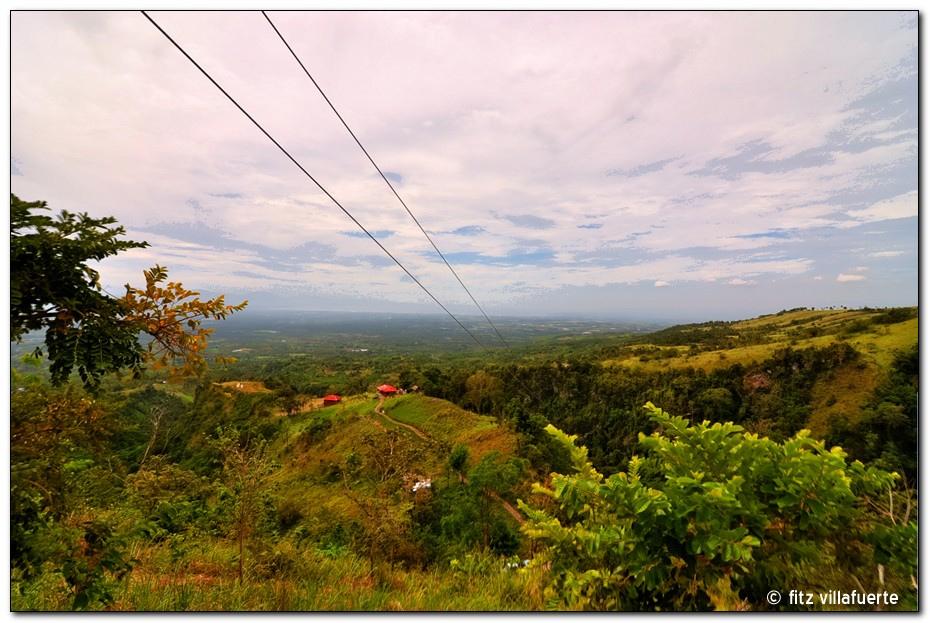
Sarangani Beach The Lush Green Hills of Columbio, Sultan Kudarat
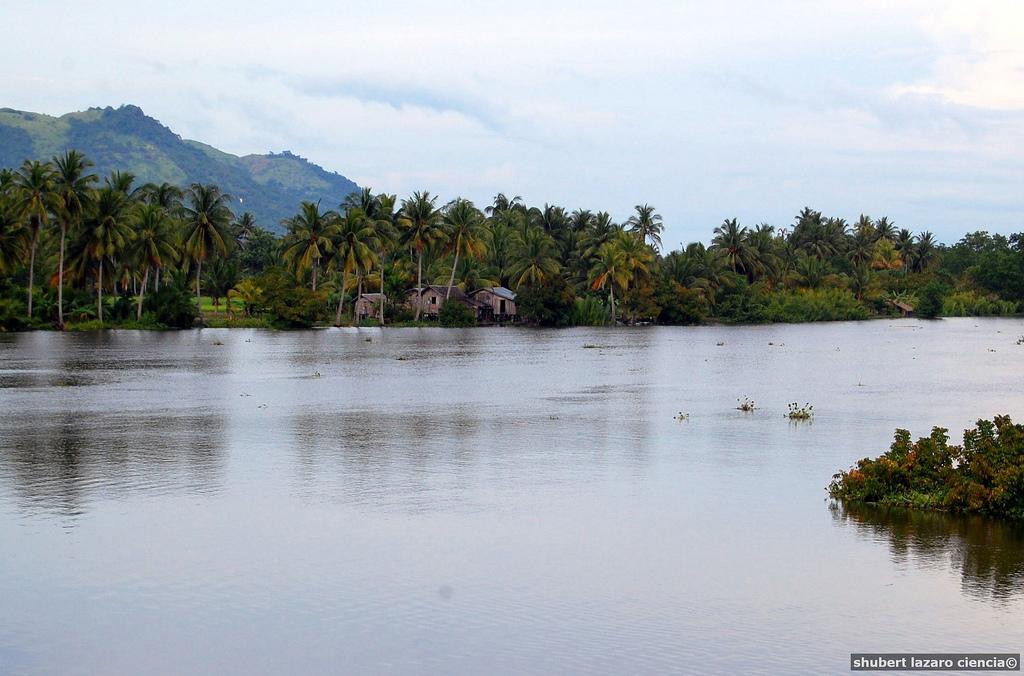
Rio Grande de Mindanao (Cotabato City) T'nalak Festival
- http://www.visitmyphilippines.com/index.php?title=RegionalProfile&func=all&pid=350&tbl=0
About Us | Privacy Policy | Contribute Vigattintourism © 2024
Vigattin Tourism
Top 30 Region 10 Tourist Spots
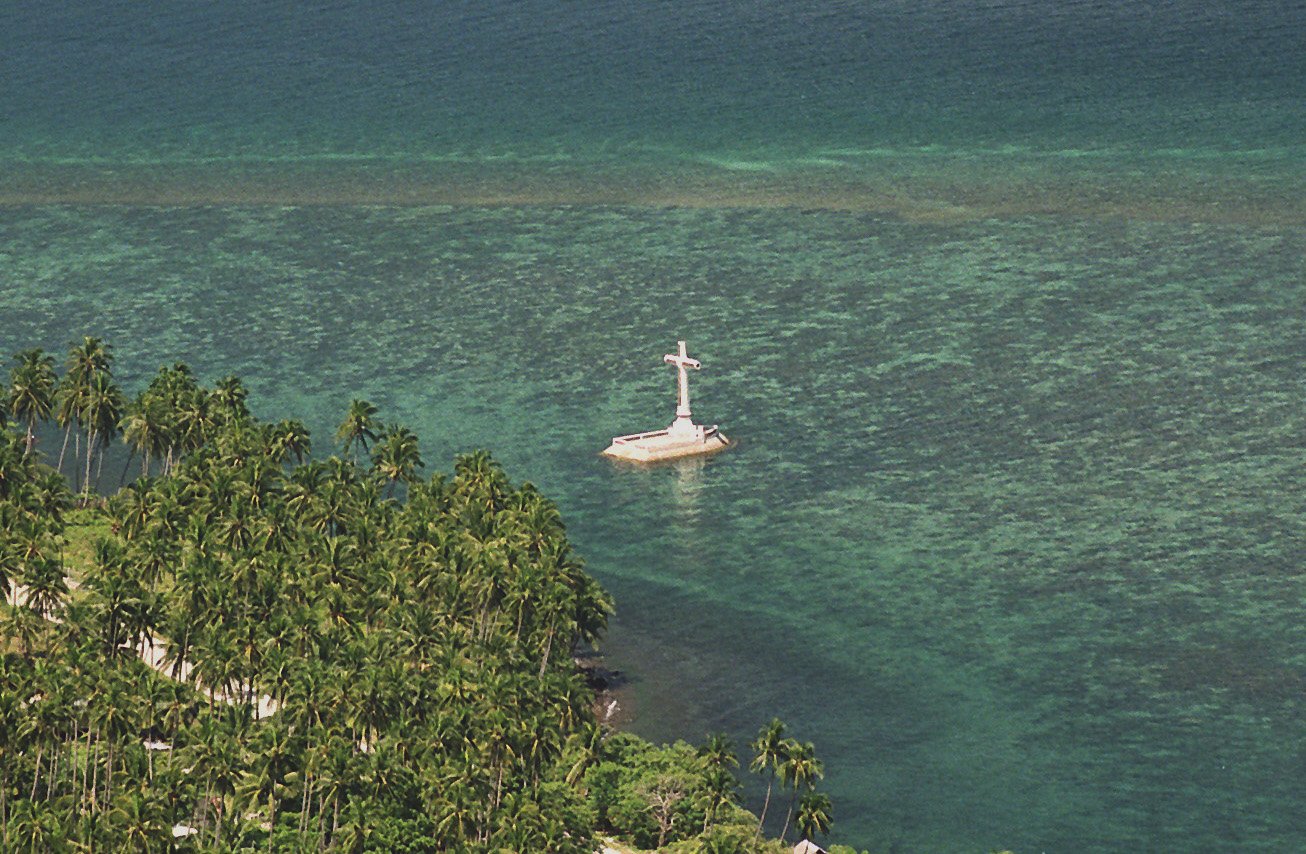
Northern Mindanao, also known as Region 10 in the Philippines, is an enthralling destination with diverse and unique attractions. Spanning five provinces - Bukidnon, Camiguin, Lanao del Norte, Misamis Occidental, and Misamis Oriental - this region captivates travelers with its stunning natural beauty, historic landmarks, and a rich array of cultural experiences.
Of all the provinces in Region 10, the most family-friendly would be the island of Camiguin. It has so many attractions that are unique from each other and they can be easily reached by land vehicles. Misamis Oriental and the city of Cagayan de Oro has a combination of both metro vibes and nature plus adventure. You can be having a blast white water rafting the whole day, then have a fancy or themed dinner in the city. Bukidnon is largely for adventure seekers, but since access is now easy to some of the major spots like Dahilayan, more and more groups and families can also experience varying levels of adventure. Misamis Occidental has so much to offer and nature lovers and adventure seekers are discovering more of what the province can offer. One can be in a pristine beach then to a lush mountain and even a pilgrimage site in one day.
Easily create your own travel itinerary to anywhere in the world! Just go to our Itinerary Builder page.
These are the top 30 or most known tourist spots in region 10., 1. white island, camiguin.
A pristine white sandbar surrounded by crystal-clear waters, offering a panoramic view of the Camiguin Island and the perfect spot for snorkeling.
2. Mount Dulang-Dulang, Bukidnon
One of the highest mountains in the Philippines, its picturesque hiking trails reveal the abundant flora and fauna of the Kitanglad Mountain Range.
3. Maria Cristina Falls, Iligan City, Lanao del Norte
Known as the "Mother of Industry," this spectacular waterfall also hosts a hydroelectric power station.
4. Monastery of Transfiguration, Malaybalay, Bukidnon
An architectural masterpiece designed by the National Artist for Architecture Leandro Locsin, this pyramid-shaped church is an oasis of tranquility.
5. Sunken Cemetery, Camiguin
Submerged under the sea due to a volcanic eruption, this unique underwater cemetery, marked by a large cross, attracts divers and snorkelers alike.
6. Tinago Falls, Iligan City, Lanao del Norte
This enchanting waterfall is tucked away in a deep ravine, accessible via a picturesque winding staircase.
7. Mapawa Nature Park, Cagayan de Oro, Misamis Oriental
Offering a wide range of outdoor activities such as river trekking, horseback riding, and zipline rides, this park is a haven for adventure lovers.
8. Dahilayan Adventure Park, Bukidnon
Home to Asia's longest dual zipline, this adventure park is nestled amidst lush pine trees, offering activities like ATV rides, rope courses, and bungee bouncing.
9. Huluga Caves, Cagayan de Oro, Misamis Oriental
A significant archaeological site containing artifacts dating back to 350 AD, offering an insightful peek into the region's prehistoric past.
10. Centennial Bongbongon Marker, Gingoog City, Misamis Oriental
This landmark commemorates the first Christian settlement in Gingoog City.
11. Soda Water Swimming Pool, Camiguin
A unique natural pool filled with carbonated water believed to have skin-healing properties.
12. Ardent Hibok-Hibok Hot Spring, Camiguin
A popular tourist spot for a relaxing dip in naturally heated pools, particularly after trekking Mount Hibok-Hibok.
13. Old Spanish Fort, Kolambugan, Lanao del Norte
A historic structure dating back to the Spanish colonial period, it served as a fortress against Moro pirates.
14. Misamis Occidental Aquamarine Park, Tudela, Misamis Occidental
A marine conservation park offering interactions with diverse marine life, including sea turtles, tropical fish, and mangrove forests.
15. Gardens of Malasag Eco-Tourism Village, Cagayan de Oro, Misamis Oriental
Set overlooking the picturesque Macajalar Bay, this eco-village offers an immersive experience of the indigenous cultures of Mindanao.
16. Rizal Park and Shrine, Dapitan City, Zamboanga del Norte
A historic site that marks where national hero Jose Rizal was exiled, it features replicas of his home, clinic, and water system.
17. Mimbalot Falls, Iligan City, Lanao del Norte
One of the most accessible waterfalls in the city, its natural pool is ideal for a refreshing swim.
18. Mount Kitanglad Range Natural Park, Bukidnon
An ASEAN Heritage Park home to various endemic and endangered species, offering opportunities for trekking, bird watching, and wildlife encounters.
19. Ozamiz City Fortress (Fuerte dela Concepcion y del Triunfo), Ozamiz City, Misamis Occidental
This 18th-century Spanish fortress offers panoramic views of Panguil Bay and houses a museum showcasing historical and archeological artifacts.
20. The Night Market at Divisoria, Cagayan de Oro, Misamis Oriental
A bustling market offering a variety of street food, affordable clothing, and unique trinkets.
21. Sagpulon Falls, Jasaan, Misamis Oriental
This waterfall is hidden amidst a lush forest and features a large basin pool perfect for swimming.
22. Capitol Tourism Plaza, Cagayan de Oro, Misamis Oriental
This bustling plaza is a hub of local activity, with a park, playground, and various shops and restaurants.
23. Museum of Three Cultures, Cagayan de Oro, Misamis Oriental
Showcasing the Maranao, Higaonon, and Christian cultures, the museum houses an array of artifacts, artworks, and historical photographs.
24. High Ridge, Cagayan de Oro, Misamis Oriental
Offering panoramic views of the city and Macajalar Bay, it's a perfect spot for dining, relaxation, and photography.
25. Iligan Anahaw Ampitheater, Iligan City, Lanao del Norte
The largest open amphitheater in Mindanao, it hosts various cultural performances and public gatherings.
26. KampoJuan, Manolo Fortich, Bukidnon
An eco-adventure park known for its thrilling anicycle ride across a 120-ft high and 840-ft long cable wire.
27. Seven Seas Waterpark and Resort, Opol, Misamis Oriental
A pirate-themed waterpark offering a variety of exciting water slides, a wave pool, and a lazy river.
28. Hugo Sky Lounge, Dahilayan, Bukidnon
Located at an elevation of 4,500 feet, this sky lounge offers stunning views of the Bukidnon landscape. A perfect place to unwind after a day of adventure.
29. Badiangon Sand Dunes, Gingoog City, Misamis Oriental
Experience a desert-like environment right in the heart of Mindanao
30. Mount Malindang Range Natural Park, Misamis Occidental
Declared an ASEAN Heritage Park, it offers challenging trails with captivating views of diverse flora and fauna.
From the crystal clear waters of White Island in Camiguin to the historical Rizal Park and Shrine in Dapitan City; from the thrill of sandboarding at Badiangon Sand Dunes to the tranquility of Mount Malindang Range Natural Park - Northern Mindanao, or Region 10, is a compelling blend of adventure, relaxation, and historical exploration. Each visit to this diverse region is a new narrative in your travel diary, contributing to a richer understanding and appreciation of what the Philippines has to offer. On your next trip, choose Northern Mindanao: where each experience is a story waiting to be told.
Tourist Spots in Dumaguete City and Its Environs
Top 30 region 9 tourist spots.

IMAGES
VIDEO
COMMENTS
11. Trek Mt. Apo — The Highest in the Philippines. ... Visit Nearby Tourist Spots in Davao Region . Explore nearby tourist spots outside the city and Samal Island. If you're up for an adventure, you can visit two of the popular attractions, Dahican Beach and Aliwagwag Falls! It's the perfect way to make your trip to Davao as complete as possible.
3. Monfort Bat Sanctuary. One of the most popular tourist attractions in Davao City is the incredible Monfort Bat Sanctuary which is also found on the famous Samal Island. This 245 feet long cave is said to be housing more than 2.3 million Rousette Fruit Bats which is the largest colony in the whole world!
See the best Davao tourist spots, top things to do, places to visit, attractions & more in 2023-2024. ... Davao City is also the gateway to surrounding provinces in the Davao Region as well as nearby regions in the southern & eastern parts of Mindanao. ... 11 Places To Visit in Lake Sebu. Balut Island & Sarangani Islands. Location: Sarangani ...
1. Island Garden City of Samal. The Island Garden City of Samal is among the top Davao Del Norte tourist spots. Home to unspoiled white beaches, stunning limestone rock formations, thriving marine life, and diverse flora and fauna, Samal Island is your ultimate tropical getaway. It is home to one of the world's biggest populations of bat ...
14. Guang-Guang Mangrove Park and Nursery. It is one of the protected Davao Oriental tourist spots as it hosts at least 18 of the rarest and endangered mangrove species in the country. It covers more than 21 000 hectares, making it an ideal habitat for different kinds of birds and sea turtles.
In this comprehensive guide, we will take you on a journey through the best of the Davao Region. From the bustling cityscape of Davao City to the pristine beaches of Samal Island, the stunning highlands of Mt. Apo, and the majestic waterfalls of Davao del Sur, we will highlight the most popular tourist destinations, local delicacies, and cultural attractions that make this region a must-visit ...
1. Mt. Pandadagsaan. Also known as the White Peak, Mt. Pandadagsaan is one of the best hiking Davao de Oro tourist spots. It is an ecological paradise, home to diverse flora and fauna species including eagles and hawks. Mt Pandadagsaan is the 3 rd highest peak in Davao region and the 13 th highest in the Philippines.
Davao Region (Region XI Profile) Davao City, modern metropolis bursting with life, verve and color, is located in a land area of 244,000 hectares and is touted as the world's largest in land area. This city, teeming with a vibrant populace, is the bustling hub of commerce, education, tourism, arts, culture and wellness in the southern ...
See way to experience (1) 2. Philippine Eagle Center. 652. Nature & Wildlife Areas. The Philippine Eagle Center (PEC) is an 8.4-hectare area located at the foothills of Mt. Apo in Malagos, Baguio District, Davao City and situated within the Malagos Watershed.
Davao Region (Region XI Profile) Davao City, modern metropolis bursting with life, verve and color, is located in a land area of 244,000 hectares and is touted as the world's largest in land area. This city, teeming with a vibrant populace, is the bustling hub of commerce, education, tourism, arts, culture and wellness in the southern ...
It is a 3-hectare island located in Barangay San Victor about 20 minutes from Baganga's town proper. It is considered as the Island Jewel of Baganga and is on the list of the top must-visit tourist spots of Davao Oriental and the Davao Region. Our lunch was served at San Victor Island.
Tourist Spots in Davao City are worth visiting this year 2015. Known to be as the Largest City in the Philippines, Davao City has a lot to showcase when we talk about tourism. ... Tourist Spots Finder March 11, 2020. Popular Beaches You Should Visit In Costa Rica. Tourist Spots Finder December 27, 2020. 10 Best Tourist Spots in Surigao del ...
Davao Region, officially designated as Region XI, is an administrative region in the Philippines occupying the southeastern section of Mindanao.It covers 5 provinces, namely, Davao de Oro (Compostela Valley), Davao del Norte, Davao del Sur, Davao Occidental, and Davao Oriental, as well as 1 highly urbanized city.The regional center is the City of Davao.
Region 11 (Davao Region) Davao Region / Southern Mindanao, designated as Region XI,is one of the regions of the Philippines, located on the southeastern portion of Mindanao. Davao Region consists of four provinces, namely: Compostela Valley, Davao del Norte, Davao Oriental, and Davao del Sur. The region encloses the Davao Gulf and its regional ...
Tuna Kilawin. Tuna Kilawin is another popular dish in Davao Region made with fresh tuna marinated in vinegar, calamansi juice, onions, and ginger. Unlike Kinilaw na Tuna, Tuna Kilawin has a creamier texture because of the addition of coconut milk. Ingredients: 500 grams of fresh tuna, cubed. 1/2 cup of vinegar.
2. DAVAO REGION REGION 11 • Davao Region is the 11th region of the Philippines that is situated at the South- Eastern part of Mindanao. • It comprises of 5 provinces; 1. Compostela Valley 2. Davao Del Norte 3. Davao Des Sur 4. Davao Oriental 5. Davao Occidental • And a highly urbanized city 1. Davao City.
The island is one of the most beautiful Davao tourist spots. 4. Crocodile Park. Davao City may not only be the Durian Capital of the Philippines. It is also the land of crocodiles. Located just within the city proper, the Crocodile Park hosts thousands of crocodiles, both saltwater and freshwater species.
Region 11: Provinces, Delecacies and Tourist Spots-- Created using PowToon -- Free sign up at http://www.powtoon.com/join -- Create animated videos and anima...
Region 11 - Southern Mindanao. "Southern Mindanao is composed of Compostela Valley, Davao del Norte, Davao del Sur and Davao Oriental. Compostela Valley. Compostela Valley is mainly agricultural while the eastern part is mostly mountainous. Natural attractions include cold springs, cascading falls, butterflies and exotic wildlife.
Some of the things to do here are swimming, hiking, trekking, biking, having a picnic, and going on a religious pilgrimage and retreat. Location: Climaco Freedom Park (Abong-Abong Park), Zamboanga City. Opening Hours: 24/7.
SoCCSKSarGen is a region of the Philippines, located in central Mindanao, and is officially designated as Region XII. The name is an acronym that stands for the region's four provinces and one of its cities: South Cotabato, Cotabato, Sultan Kudarat, Sarangani and General Santos City. The regional center is Koronadal City located in the province of South Cotabato. Cotabato City itself is part ...
The region's gateway is General Santos City, the country's "tuna capital" since the 1970s because of its rich trove of deep sea fish. Air and sea connections link between Iloilo and GenSan have been established to promote trade and travel between the two major urban centers. Other Emerging Spots in Region 12 4.
This detailed guide features the top 30 must-visit tourist spots that promise to elevate your travel experience. Immerse yourself in the breathtaking landscapes and rich cultural heritage of Region 10, Northern Mindanao, Philippines. ... These are the top 30 or most known tourist spots in region 10. 1. White Island, Camiguin ... 11. Soda Water ...